2012 No. 323
The Local Authorities (Conduct of Referendums)(England) Regulations 2012
Made
Coming into force in accordance with regulation 1
The Secretary of State makes the following Regulations in exercise of the powers conferred by sections 9MG and 105 of the Local Government Act 2000 F1.
In accordance with section 9MG(6) of that Act, the Secretary of State has consulted the Electoral Commission on the questions to be asked at a referendum as specified in these Regulations.
In accordance with section 105(6) of that Act, a draft of this instrument has been laid before and approved by a resolution of each House of Parliament.
Citation and commencement1
These Regulations may be cited as the Local Authorities (Conduct of Referendums)(England) Regulations 2012 and come into force on the day after the day on which they are made.
InterpretationC12
C41
In these Regulations—
“the 1972 Act” means the Local Government Act 1972 F2;
“the 1983 Act” means the Representation of the People Act 1983 F3;
“the 1985 Act” means the Representation of the People Act 1985 F4;
“the 2000 Act” means the Local Government Act 2000 F5;
“the 2011 Act” means the Police Reform and Social Responsibility Act 2011 F6;
“the Petitions Regulations” means the Local Authorities (Referendums)(Petitions)(England) Regulations 2011 F7;
“the Representation of the People Regulations” means the Representation of the People (England and Wales) Regulations 2001 F8;
“the Combination of Polls Regulations” means the Representation of the People (Combination of Polls)(England and Wales) Regulations 2004 F9;
“the Local Government Act Referendums Rules” means the rules set out in Schedule 3 to these Regulations;
“the Local Government Act Referendums (Combination of Polls) Rules” means the rules set out in Schedule 5 to these Regulations;
F177“combined authority mayoral election” means an election of a mayor for a combined authority under Part 6 of the Local Democracy, Economic Development and Construction Act 2009;
“counting observer” means a person appointed by a counting officer under rule 18(2) of the Local Government Act Referendums Rules or rule 18(1) of the Local Government Act Referendums (Combination of Polls) Rules (as the case may be);
“counting officer” means a person referred to in regulation 9;
“elected mayor”, in relation to a local authority, means an individual elected as mayor of the authority by local government electors for the authority's area in accordance with provisions made by or under Part 1A of the 2000 Act;
F190...
“further referendum” means a referendum held in pursuance of an order under regulation 17(5);
“local government election” must be construed in accordance with section 203(1) of the 1983 Act F10;
“mayoral election” must be construed in accordance with the Local Authorities (Mayoral Elections)(England and Wales) Regulations 2007 F11;
“notification date”—
- a
in relation to a referendum, means the date on which the notice required to be published by regulation 4(1) is published;
- b
in relation to a further referendum, means the date which falls two months before the day on which the poll at the further referendum is held;
- a
“petition organiser”, in relation to a referendum, means a person who is treated for the purpose of regulation 10(4) or (5) (formalities of petition) as the case may be of the Petitions Regulations, as the petition organiser of any valid petition (whether an amalgamated petition, a constituent petition or a post-announcement petition) received by the local authority by or in respect of which a referendum is held;
“police area” must be construed in accordance with section 102 of the 2011 Act;
“police and crime commissioner” means an individual elected as a police and crime commissioner by relevant electors within the police area in accordance with provisions made by or under Chapter 6 of Part 1 of the 2011 Act;
“police and crime commissioner election” must be construed in accordance with provision made by or under section 50 or 51 of the 2011 Act;
“polling observer” means a person appointed by a counting officer under rule 18(1) of the Local Government Act Referendums Rules or rule 19(1) of the Local Government Act Referendums (Combination of Polls) Rules (as the case may be);
“proper officer” must be construed in accordance with section 270(3) of the 1972 Act;
“referendum” means a referendum held under section 9M (cases in which change is subject to approval in a referendum etc) of the 2000 Act, or by virtue of regulations or order made under any provision of Part 1A (arrangements with respect to local authority governance in England) of that Act;
“referendum period”, in relation to a referendum (including a further referendum), means the period beginning with the notification date and ending on the date of the referendum;
“referendum petition” means the petition by which a referendum may be questioned in accordance with regulation 15;
“relevant election or referendum” means one or more of the following—
- a
another referendum (including a further referendum);
- b
a Parliamentary election;
- c
F190...
- d
a local government election;
- e
a mayoral election;
- ea
F178a combined authority mayoral election;
- f
a police and crime commissioner election,
the poll at which is taken together with the poll at the referendum;
- a
“voting area” means the area in which a referendum is held.
2
Any reference in the following provisions of these Regulations to a section followed by a number is, unless the context otherwise requires, a reference to the section of the 2000 Act that bears that number.
Question to be asked in a referendum3
Where the proposals in relation to which a referendum is to be held are for the authority to operate—
a
a mayor and cabinet executive, the question to be asked in that referendum is to be in the form set out—
i
where the authority is currently operating a leader and cabinet executive (England), in paragraph 1 of Schedule 1 to these Regulations; and
ii
where the authority is currently operating the committee system, in paragraph 2 of Schedule 1 to these Regulations; and
b
a leader and cabinet executive (England), the question to be asked in that referendum is to be in the form set out—
i
where the authority is currently operating a mayor and cabinet executive, in paragraph 3 of Schedule 1 to these Regulations; and
ii
where the authority is currently operating the committee system in paragraph 4 of Schedule 1 to these Regulations; and
c
the committee system, the question to be asked in that referendum is to be in the form set out—
i
where the authority is currently operating a mayor and cabinet executive, in paragraph 5 of Schedule 1 to these Regulations; and
ii
where the authority is currently operating a leader and cabinet executive (England), in paragraph 6 of Schedule 1 to these Regulations.
Publicity and other information in connection with referendums4
1
Subject to paragraph (2), the proper officer must, not fewer than 56 days before the date on which the referendum will be held in accordance with sub-paragraph (c)(ii) below, publish in such a manner as he or she considers likely to bring to the attention of persons who live in the local authority area a notice which contains—
a
a statement that, as the case may be—
i
proposals under section 9MA (Referendum: proposals by local authority); or
ii
proposals under regulation 17(2) of the Petitions Regulations; or
iii
any proposals required under an order under section 9ME or 9N,
have been drawn up;
b
a description of the main features of any proposals;
c
a statement—
i
that a referendum will be held;
ii
of the date on which the referendum will be held;
iii
in a case to which regulation 10(1) or (5) applies, that the poll in the referendum will be taken together with the poll or polls in an election or elections of a description which is to be specified in the statement;
iv
of the question to be asked in the referendum;
v
that the referendum will be conducted in accordance with procedures similar to those used at local government elections;
vi
of the referendum expenses limit (as defined in regulation 6(1)) that will apply in relation to the referendum and the number of local government electors by reference to which that limit has been calculated;
vii
of the address and times at which a copy of any proposals may be inspected;
viii
of the procedures for obtaining a copy of any proposals; and
ix
if the proper officer then knows that the poll in the referendum (whether or not it is to be taken together with the poll in an election) will be taken together with the poll in a referendum for another area, that the polls will be taken together for the two (or more) areas, which are to be specified in the statement.
2
At least 14 days before the day on which the proper officer of an authority publishes a notice in accordance with paragraph (1) that proper officer must, by notice in writing, advise—
a
if that person is the proper officer of a county council, the proper officer of the council of each district comprised in the county;
b
if that person is the proper officer of a district council comprised in an area for which there is a county council, the proper officer of—
i
the council of the county in which the district lies; and
ii
each of the district councils in that county,
that that person intends to publish a notice under paragraph (1) and the date of the referendum to be held in the area.
3
It is the duty of each proper officer—
a
to whom notice has been given under paragraph (2); and
b
whose council are considering the holding of a referendum in their area,
to consider whether it would be practicable to combine that referendum with the one of which such notice has been given; and each such officer must reply to the notice within seven days of its receipt, indicating whether that proper officer's authority wish to combine their referendum with that to which the notice refers.
4
Unless the notice required to be published by paragraph (1) (“the first notice”) is published fewer than 74 days before the date of the referendum, the proper officer must publish a second notice containing the particulars specified in paragraph (1)(c)(i)-(viii) and, if paragraph (1)(c)(ix) applies (whether or not it applied in relation to the first notice, if any), the particulars specified in that paragraph.
5
The second notice is to be published—
a
in the same manner as was used for the publication of the first notice; and
b
not more than 55 days and not fewer than 28 days before the date of the referendum.
6
The authority must make available for inspection throughout the referendum period, at the address and times stated in the notice, and free of charge, a copy of any proposals, and must secure that sufficient copies are available for persons who wish to obtain copies.
7
The authority may provide (whether or not in pursuance of any duty to do so) any other factual information relating to any proposals or the referendum so far as it is presented fairly.
8
In determining for the purposes of paragraph (7) whether any information is presented fairly, regard is, in accordance with section 9Q, to be had to any guidance for the time being issued by the Secretary of State under that section.
9
The date on which the notice required to be published by paragraph (1) is published is “the notification date”.
Restriction on publication etc of promotional material5
1
This regulation applies to any material which—
a
provides general information about the referendum;
b
deals with any of the issues raised by the question to be asked in the referendum; or
c
puts any arguments for or against a particular answer to that question.
2
No material to which this regulation applies is to be published by or on behalf of a local authority during the period of 28 days ending with the date of the poll at the referendum.
3
Paragraph (2) does not apply to—
a
material made available to persons in response to specific requests for information or to persons specifically seeking access to it;
b
the publication of information relating to the holding of the poll at the referendum; or
c
the publication of press notices containing factual information where the sole purpose of the publication is to refute or correct any inaccuracy in material published by a person other than the local authority.
4
In this regulation “publish” means make available to the public at large, or to any section of the public, in whatever form and by whatever means (including, in particular, by inclusion in any programme included in a programme service within the meaning of the Broadcasting Act 1990 F12); and “publication” is to be construed accordingly.
General restriction on referendum expenses6
1
In this regulation and in regulation 7—
“campaign organiser” means the individual or body by whom, or on whose behalf, referendum expenses are incurred (including expenses treated as incurred) in connection with a referendum campaign;
“referendum campaign” means a campaign conducted with a view to promoting or procuring a particular outcome in relation to the question to be asked in a referendum;
“referendum expenses” means the expenses incurred by or on behalf of any individual or body during the referendum period for referendum purposes in respect of any of the matters set out in paragraphs 1 to 7 of Schedule 2 to these Regulations, as read in accordance with paragraph 8 of that Schedule;
“referendum expenses limit” means the aggregate of £2,362 and the amount found by multiplying by 5.9 pence the number of entries in the relevant register;
“for referendum purposes” means—
- a
in connection with the conduct or management of any campaign conducted with a view to promoting or procuring a particular outcome in relation to the question asked in the referendum; or
- b
otherwise in connection with promoting or procuring any such outcome;
- a
F142“the relevant register” means the register or registers of local government electors kept in accordance with section 9 of the 1983 Act which has or have effect in the area of the local authority by which or as regards which the referendum is held on the day on which the referendum period begins (whether or not the persons to whom the entries relate are entitled to vote in the referendum).
2
The total referendum expenses incurred, or in accordance with regulation 7, treated as incurred, by or on behalf of any individual or body must not exceed the referendum expenses limit.
3
Where any referendum expenses are incurred in excess of the referendum expenses limit, a person who knew or ought reasonably to have known that that limit would be exceeded, or who, without reasonable excuse, authorises another person to exceed that limit, is guilty of an offence.
4
Where information is given to the Director of Public Prosecutions that an offence under paragraph (3) has been committed, it is his or her duty to make such inquiries and institute such prosecutions as the circumstances of the case appear to him or her to require.
5
Where an offence under paragraph (3) which has been committed by a body corporate is proved to have been committed with the consent or connivance of, or to have been attributable to any neglect on the part of, a director, manager, secretary or other similar officer of the body corporate, or any other person purporting to act in such capacity, that person, as well as the body corporate, is guilty of an offence and is liable to be proceeded against and punished accordingly.
6
A person who commits an offence under paragraph (3) is liable—
a
on summary conviction, to a fine not exceeding the statutory maximum or imprisonment for a term not exceeding F214the general limit in a magistrates’ court or both; or
b
on conviction on indictment, to a fine or imprisonment for a term not exceeding 12 months or both.
7
8
Nothing in paragraph (2) affects the right of any creditor who, when the expenses were incurred, was ignorant of that expense being in contravention of that paragraph.
Notional referendum expenses7
1
This regulation applies where—
a
property, services or facilities is or are provided for the use or benefit of any person either—
i
free of charge; or
ii
at a discount of more than 10 per cent of the commercial rate for the use of the property or for the provision of the services or facilities; and
b
the property, services or facilities is or are made use of by or on behalf of that person in circumstances such that, if any expenses were to be (or are) actually incurred by him or her or on his or her behalf in respect of that use, they would be (or are) referendum expenses incurred by him or her or on his or her behalf.
2
Subject to paragraph (5), where this regulation applies, an amount of referendum expenses determined in accordance with paragraph (3) is, unless it is not more than £200, to be treated for the purposes of regulation 6 as incurred by that person for the period for which the property, services or facilities is or are made use of as mentioned in paragraph (1)(b).
3
The amount mentioned in paragraph (2) is such proportion of either—
a
the commercial rate for use of the property or the provision of the services or facilities (where the property, services or facilities is or are provided free of charge); or
b
the difference between that commercial rate and the amount of the expenses actually incurred by or on behalf of that person in respect of the use of the property or the provision of the services or facilities (where the property, services or facilities is or are provided at a discount),
as is reasonably attributable to the use made of the property, services or facilities as mentioned in paragraph (1)(b).
4
Where the services of an employee are made available by his or her employer for the use or benefit of a person, the amount which is to be taken as constituting the commercial rate for the provision of those services is the amount of the remuneration or allowances payable to the employee by his or her employer in respect of the period for which that person's services are made available (but that amount is not to include any amount in respect of contributions or other payments for which the employer is liable in respect of that employee).
5
No amount of referendum expenses is to be regarded as incurred by virtue of paragraph (2) in respect of the provision by any individual of his or her own services which that person provides voluntarily in his or her own time and free of charge.
Conduct of referendum: poll at referendum not taken together with poll at relevant election or referendum8
1
A referendum is to be conducted in accordance with the Local Government Act Referendums Rules (as contained in Schedule 3 to these Regulations), unless the poll at the referendum is taken together with the poll at a relevant election or referendum.
2
The provisions mentioned in the first column of Tables 1 to 6 of Schedule 4 to these Regulations have effect in relation to referendums, subject to the modifications specified in that Schedule and to any contrary provision in these Regulations.
Counting officer9
1
Subject to regulations 11(2) and 13(2), functions conferred by these Regulations on the counting officer are to be exercised in each voting area by the person who is for the time being the returning officer at elections of councillors for that area under section 35(1) or (3) (returning officers: local elections) of the 1983 Act F13.
2
It is the counting officer's general duty at the referendum to do all such acts and things as may be necessary for effectually conducting the referendum in the manner provided by these Regulations.
3
The counting officer must also appoint and pay any such persons as may be necessary for the purpose of the counting of the votes.
Combination of polls: generalC2C510
1
Where the poll at a referendum would be taken on a day that falls within the period—
a
beginning 28 days before the day on which the poll is to be taken at an election of a description mentioned in paragraph (2); and
b
ending 28 days after the day on which the poll is to be taken at any such election,
the poll at the referendum must, subject to paragraph (3), be taken on the day on which the poll is to be taken at the election; and the polls must be taken together.
2
The descriptions of elections mentioned in this paragraph are—
a
an ordinary election of councillors for a county electoral division or a district or London borough ward (as the case may be) of the local authority by which or as regards which the referendum is to be held;
b
an ordinary election of councillors for a county electoral division or a district or London borough ward (as the case may be) of any other local authority, where that division or ward is wholly or partly within the area of the local authority by which or as regards which the referendum is to be held;
c
a parliamentary general election;
d
an election to fill a vacancy in a parliamentary constituency that is wholly or partly within the area of the local authority by which or as regards which the referendum is to be held;
F191e
. . . . . . . . . . . . . . . . . . . . . . . . . . . . . . . .
F191f
. . . . . . . . . . . . . . . . . . . . . . . . . . . . . . . .
g
an ordinary election within the meaning of Part 1 (the Greater London Authority) of the Greater London Authority Act 1999 F14, where the local authority by which or as regards which the referendum is to be held is a London borough;
h
an election (other than an ordinary election) of the Mayor of London under section 16(2) (filling a vacancy in the office of Mayor) of the Greater London Authority Act 1999, where the local authority by which or as regards which the referendum is to be held is a London borough;
i
an ordinary election of police and crime commissioners under section 50 of the 2011 Act;
j
an election to fill a vacancy in the office of a police and crime commissioner under section 51 of the 2011 Act for a police area in which the area of the local authority by which or as regards which the referendum is to be held falls;
k
an election of an elected mayor.
3
Where the poll at a referendum would be taken together with the poll at an election of a description mentioned in paragraph (2)(c), (d), F192... (h) or (j), paragraph (1) does not apply where notice of the date of the referendum is given under regulation 4 before the date on which notice is given of the date of election, and the date of the referendum is not the same as that of the election.
4
In a case to which paragraph (3) applies, the poll at a referendum is to be taken on the day of which the notice has been given under regulation 4.
5
The poll at a referendum may be taken together with the poll at an election under section 89 (filling of casual vacancies in the case of councillors) of the 1972 Act F15 or under section 10 (filling a vacancy in an Assembly constituency) of the Greater London Authority Act 1999—
a
where the referendum is to be held in compliance with a direction of the Secretary of State, if he or she so determines;
b
in any other case, if the authority by which the referendum is to be held so determine.
6
Notice of a determination under paragraph (5) must be given in writing—
a
where the determination is made by the Secretary of State, to the authority or authorities (as the case may be) by which the election and the referendum concerned are to be held;
b
where the determination is made by an authority, to the authority (other than themselves) by which the election concerned is to be held.
7
Subject to paragraph (8), where an authority (“the first authority”) have given notice under regulation 4(1) of the date on which a referendum will be held in their area, no other authority—
a
whose area includes that of the first authority; or
b
whose area is part of that of the council of the same county as that of the first authority,
may hold a referendum in their area within the period beginning 28 days before the date of the first authority's referendum and ending 28 days after that date unless the polls at the referendums are combined.
8
Where the date on which a referendum is to be held in a county is the same as that on which a referendum is to be held in any district within that county, the polls must be taken together.
Combination of referendum and election polls: conduct of referendumC3C611
1
This regulation applies, in relation to the referendum, where polls are taken together in accordance with regulation 10(1) or (5).
2
The referendum is to be conducted in accordance with the Local Government Act Referendums (Combination of Polls) Rules (as contained in Schedule 5 to these Regulations).
3
The provisions specified in the first column of Tables 1 to 6 of Schedule 4 have effect in relation to the referendum, subject to the modifications specified in that Schedule and to any contrary provision of these Regulations.
4
Where a person applies under Schedule 4 to the Representation of the People Act 2000 F16 to vote by post, or to vote by proxy, at the election, that person is to be treated as applying also to vote by post, or to vote by proxy, at the referendum.
Combination of referendum and election polls: supplementary provisions relating to elections12
1
This regulation applies, in relation to the election or elections (as the case may be), where polls are taken together in accordance with regulation 10(1) or (5).
2
The provisions specified in the first column of Tables 2, 3 and 6 of Schedule 4 have effect in relation to elections to which this regulation applies, subject to the modifications specified in that Schedule and to any contrary provision of these Regulations.
3
Where a person applies under Schedule 4 to the Representation of the People Act 2000 to vote by post, or to vote by proxy, at the referendum, that person is to be treated as applying also to vote at the election by post or by proxy.
Combination of referendum polls: supplementary13
1
This regulation applies where polls at referendums are taken together in accordance with regulation 10(7) or (8).
2
The functions mentioned in paragraph (3) are all to be discharged by one counting officer, and the counting officers are to agree as to which of them that should be.
3
The functions mentioned in this paragraph are—
a
those under the following rules of the Local Government Act Referendums (Combination of Polls) Rules—
i
unless paragraph (ii) applies, rule 8 (the corresponding number list) to the extent that it relates to ballot papers to be provided in pursuance of rule 17(1);
ii
where the proceedings on the issue and receipt of postal ballot papers at the referendums are taken together under regulation 65 of the Representation of the People Regulations (as applied by paragraph (5)), rule 8 (the corresponding number list);
iii
rule 12(3) (notice of situation of polling stations, etc);
iv
where the proceedings on the issue and receipt of postal ballot papers at the referendums are taken together under regulation 65 of the Representation of the People Regulations (as applied by paragraph (5)), rule 13 (postal ballot papers);
v
rule 14 (provision of polling stations);
vi
rule 15(1) and (2) (appointment of presiding officers and clerks) to the extent that that rule concerns the appointment of presiding officers and clerks to assist them;
vii
rule 17 (equipment of polling stations) F270, except the functions in rule 17(5A);
viii
rule 20 (notification of requirement of secrecy in relation to polling stations);
ix
where the proceedings on the issue and receipt of postal ballot papers at the referendums are taken together under regulation 65 of the Representation of the People Regulations (as applied by paragraph (5)), rule 22 (return of postal ballot papers);
x
rule 23(3) (signature as to certificate of employment);
xi
rule 24(2)(b) (keeping of order in station);
xii
rule 38(1) (the count); and
b
where the proceedings on the issue and receipt of postal ballot papers at more than one referendum are taken together under regulation 65 of the Representation of the People Regulations (as applied by paragraph (5)), the functions conferred by the provisions of Part 5 of those Regulations applied by paragraph (5).
4
The referendums are to be conducted in accordance with the Local Government Act Referendums (Combination of Polls) Rules.
5
The provisions specified in the first column of Tables 1 to 6 of Schedule 4 have effect in relation to the referendums, subject to the modifications specified in that Schedule and to any contrary provision of these Regulations.
6
The cost of taking the combined poll (excluding any cost solely attributable to one referendum) and any cost attributable to the combination is to be apportioned equally among the referendums.
Result of referendum or further referendum14
1
This regulation is subject to regulations 16 and 17.
2
If the majority of the votes cast in a referendum other than a further referendum are in favour of the authority operating arrangements which differ from its existing arrangements, the result of the referendum is—
a
for the purposes of section 9MB(3), to approve the authority's proposals under section 9MA;
b
for the purposes of regulation 18 (action where referendum proposals approved) of the Petitions Regulations, and in accordance with section 9MF(4), to approve the proposals drawn up under regulation 17(2) of the Petitions Regulations which were the subject of the referendum;
c
for the purposes of an order made under section 9N, to require the authority to start to operate a mayor and cabinet executive;
d
for the purposes of an order made under section 9ME, and in accordance with section 9MF(4), to require the authority to start to operate the form of governance that was the subject of the referendum held in consequence of the order.
3
If the majority of the votes cast in a referendum other than a further referendum are in favour of the continuation of the authority's existing arrangements, the result of the referendum is—
a
for the purposes of section 9MB(3), to reject the authority's proposals under section 9MA;
b
for the purposes of regulation 19 (action where referendum proposals rejected) of the Petitions Regulations, and in accordance with section 9MF(5), to reject the proposals drawn up under regulation 17(2) of the Petitions Regulations which were the subject of the referendum;
c
for the purposes of an order made under section 9N, to reject the proposal that the authority start to operate a mayor and cabinet executive;
d
for the purposes of an order made under section 9ME, and in accordance with section 9MF(5), to reject the proposal that the authority start to operate the form of governance that was the subject of the referendum held in consequence of that order.
4
If the majority of the votes cast in a further referendum are in favour of the authority continuing to operate a mayor and cabinet executive, the result of the referendum is to require the authority to continue to operate those arrangements.
5
If the majority of the votes cast in a further referendum are in favour of the authority changing its governance arrangements to those it operated at the time of the tainted referendum, the result of the referendum is to require the authority to implement those arrangements.
Procedures for questioning referendum15
1
A referendum under these Regulations may be questioned by petition (“a referendum petition”)—
a
on the ground that the result of the referendum was not in accordance with the votes cast;
b
on the ground that the referendum was avoided by such corrupt or illegal practices, within the meaning of the 1983 Act, as are relevant to referendums by virtue of regulation 8, 11 or 13 or paragraph (8);
c
on the grounds provided by section 164 (avoidance of election for general corruption etc) of the 1983 Act, as applied for the purposes of these Regulations by paragraph (8); or
d
subject to paragraph (3), on the ground that a payment of money or other reward has been made or promised since the referendum in pursuance of a corrupt or illegal practice relevant to the referendum by virtue of regulation 8, 11 or 13 or paragraph (8).
2
A referendum petition on any of the grounds specified in paragraph (1)(a) to (c) must be presented not later than 21 days after the day on which the referendum was held.
3
A referendum petition on the ground mentioned in paragraph (1)(d) may be presented only with the leave of the High Court.
4
An application for leave must be made, not later than 28 days after the date of the alleged payment or promise, by application notice to the court at such time and place as the court may appoint.
5
Not less than seven days before the day so appointed the applicant must—
a
serve the application notice on the respondent and the Director of Public Prosecutions and lodge a copy in the election petitions office; and
b
publish notice of the intended application in at least one newspaper circulating in the voting area for the referendum to which the application relates.
6
The application notice must state the grounds on which the application is made.
7
A referendum petition is to be tried by an election court, that is to say, a court constituted under section 130 (election court for local election in England and Wales, and place of trial) of the 1983 Act for the trial of an election petition, as applied by paragraph (8).
8
Schedule 6 to these Regulations contains provisions which have effect in relation to the questioning of a referendum as they have effect in relation to the questioning of an election under the Local Government Act 1972 subject to the modifications specified in that Schedule and to any contrary provision of these Regulations.
9
The Election Petition Rules 1960 F17 have effect in relation to a referendum petition as they have effect in relation to a local election petition within the meaning of those Rules, subject to the modifications specified in Schedule 7 to these Regulations and to any contrary provision of these Regulations.
Immediate consequences of referendum petitions16
1
This regulation, apart from paragraph (5), applies where—
a
a referendum petition is presented on any of the grounds mentioned in regulation 15(1)(a) to (c); or
b
leave is granted to the presentation of a referendum petition brought under the ground mentioned in regulation 15(1)(d).
2
Where this regulation applies—
a
in relation to a referendum—
i
at which the question asked was in the form set out in paragraph 3, 4, 5 or 6 of Schedule 1; and
ii
in which the majority of the votes cast are in favour of the authority operating arrangements which differ from their existing arrangements; and
b
before the authority have passed a resolution under section 9KC,
the authority must take no further steps in consequence of the referendum until the election court has certified its determination in the matter of the referendum petition.
3
Where this regulation applies—
a
in relation to a referendum—
i
at which the question asked was in the form set out in paragraph 3, 4, 5 or 6 of Schedule 1; and
ii
in which the majority of the votes cast are in favour of the authority operating arrangements which differ from their existing arrangements; and
b
after the authority have passed a resolution under section 9KC,
the authority must continue to operate the arrangements that are the subject of that resolution.
4
Where this regulation applies—
a
in relation to a referendum—
i
at which the question asked was in the form set out in paragraph 1 or 2 of Schedule 1; and
ii
in which the majority of the votes cast are in favour of the authority operating arrangements which differ from their existing arrangements; and
b
without an election for the return of an elected mayor having taken place in consequence of the referendum,
the authority must take no further steps in consequence of the referendum until the election court has certified its determination in the matter of the referendum petition.
5
Where leave is granted to the presentation of a referendum petition brought under the ground mentioned in regulation 15(1)(d)—
a
in relation to a referendum—
i
at which the question asked was in the form set out in paragraph 1 or 2 of Schedule 1; and
ii
in which the majority of the votes cast are in favour of the authority operating arrangements which differ from its existing arrangements; and
b
after an election for the return of an elected mayor has taken place in consequence of the referendum,
the elected mayor is to continue in office.
Determination of referendum petitions17
1
Where an election court certifies, as its determination of a referendum petition, that the result of the referendum declared under regulation 14 is or is not in accordance with the votes cast (as the case may be), any reference (in whatever terms) in the timetable—
a
included in the authority's proposals under section 9MA;
b
included in their proposals under regulation 17(2) of the Petitions Regulations; or
c
prepared in pursuance of any other regulations or an order made under any provision of Part 1A (arrangements with respect to local authority governance in England) of the 2000 Act,
to the date of the result of the referendum is to be construed as a reference to the date on which the election court certifies its determination.
2
On the substantive hearing of a referendum petition for which leave has been granted where the circumstances are as mentioned in any paragraph of regulation 16 other than paragraph (5), the election court must either—
a
dismiss the petition; or
b
allow the petition,
and, where the court allows the petition, it must declare the referendum avoided.
3
Where an election court certifies, as its determination of a referendum petition specifying any of the grounds mentioned in regulation 15(1), that the referendum was avoided, the authority concerned must, not earlier than two months and not later than three months after the date on which the election court has certified that determination, hold another referendum.
4
Where another referendum is held in the circumstances referred to in paragraph (3), these Regulations apply to the conduct of that referendum as they apply to the conduct of the avoided referendum subject to—
a
in regulation 4—
i
the omission of paragraph (1)(a) and (b);
ii
in paragraph (1)(c), the omission of paragraphs (vii) and (viii);
iii
after paragraph (1)(c)(ix), the insertion of—
x
that another referendum is being held in consequence of the determination of an election court that the referendum last held in the authority's area was avoided.
5
Where the circumstances are as mentioned in regulation 16(5)(a) and (b), the court must—
a
dismiss the petition; or
b
allow the petition,
and, where the court allows the petition, it must declare the referendum to be tainted, and order that a further referendum be held.
6
Where the election court makes the order mentioned in paragraph (5), subject to regulation 10(1), the authority must hold the further referendum as soon as practicable after the expiration of the period of five years beginning with the date on which the tainted referendum was held.
7
If the majority of the votes cast in a further referendum are in favour of the authority continuing to operate a mayor and cabinet executive, the authority must continue to operate those arrangements.
8
If the majority of the votes cast in a further referendum are in favour of the authority changing its governance arrangements to those which it operated at the time of the tainted referendum, section 9KC(2) applies as if in paragraph (b) for sub-paragraph (i) there were substituted—
i
states that in consequence of the rejection in a further referendum of the authority's existing mayor and cabinet executive, the authority have resolved to operate the arrangements they operated at the time of the tainted referendum instead;
9
These Regulations, except where the context otherwise requires, apply (so far as relevant) to the conduct of the further referendum as they apply to the conduct of any other referendum subject to—
a
in regulation 3 the omission of paragraphs (a), (b)(ii) and (c)(ii);
b
in regulation 4—
i
the omission of paragraph (1)(a) and (b);
ii
in paragraph (1)(c), the omission of paragraphs (vii) and (viii);
iii
after paragraph (1)(c)(ix), the insertion of—
x
that a further referendum is being held in consequence of the determination of an election court that the referendum last held in the authority's area was tainted by reason of a payment of money or other reward made or promised since the referendum in pursuance of a corrupt or illegal practice;
c
in Schedule 1 the omission of paragraphs 1, 2, 4 and 6;
d
the omission of the first, second, fourth and sixth forms appearing in the Local Government Act Referendums Rules and the Local Government Act Referendums (Combination of Polls) Rules.
Time18
1
The days mentioned in paragraph (2) are to be disregarded in calculating any period of time for the purposes of regulation 4(1).
2
The days mentioned in this paragraph are—
a
a Saturday or Sunday;
b
Christmas Eve, Christmas Day, Good Friday or a day which is a bank holiday under the Banking and Financial Dealings Act 1971 F18 in England; and
c
any day appointed as a day of public thanksgiving or mourning.
Advertisements19
The Town and Country Planning (Control of Advertisements) Regulations 1992 F19 have effect in relation to the display on any site in a voting area of an advertisement relating specifically to the referendum as they have effect in relation to the display of an advertisement relating specifically to a local government election.
Non-domestic rating: premises used for referendum purposes20
In relation to premises in a voting area, section 65(6) of the Local Government Finance Act 1988 F20 (occupation for election meetings and polls) has effect as if—
a
the reference to public meetings in furtherance of a person's candidature at an election included a reference to public meetings promoting a particular result in the referendum; and
b
the reference to the use by a returning officer for the purpose of taking the poll in an election included a reference to the use for the purpose of taking the poll in the referendum—
i
by a person exercising functions of a counting officer in accordance with regulation 9; or
ii
by a relevant returning or counting officer within the meaning of rule 2(1) of the Local Government Act Referendums (Combination of Polls) Rules.
Revocations21
The Local Authorities (Conduct of Referendums)(England) Regulations 2007 F21 are revoked.
Signed by authority of the Secretary of State for Communities and Local Government
SCHEDULE 1QUESTIONS TO BE ASKED IN A REFERENDUM
1
How would you like [insert name of local authority] to be run?
By a leader who is an elected councillor chosen by a vote of the other elected councillors. This is how the council is run now.
Or
By a mayor who is elected by voters. This would be a change from how the council is run now.
2
How would you like [insert name of local authority] to be run?
By one or more committees made up of elected councillors. This is how the council is run now.
Or
By a mayor who is elected by voters. This would be a change from how the council is run now.
3
How would you like [insert name of local authority] to be run?
By a mayor who is elected by voters. This is how the council is run now.
Or
By a leader who is an elected councillor chosen by a vote of the other elected councillors. This would be a change from how the council is run now.
4
How would you like [insert name of local authority] to be run?
By one or more committees made up of elected councillors. This is how the council is run now.
Or
By a leader who is an elected councillor chosen by a vote of the other elected councillors. This would be a change from how the council is run now.
5
How would you like [insert name of local authority] to be run?
By a mayor who is elected by voters. This is how the council is run now.
Or
By one or more committees made up of elected councillors. This would be a change from how the council is run now.
6
How would you like [insert name of local authority] to be run?
By a leader who is an elected councillor chosen by a vote of the other elected councillors. This is how the council is run now.
Or
By one or more committees made up of elected councillors. This would be a change from how the council is run now.
SCHEDULE 2MATTERS RELEVANT TO REFERENDUM EXPENSES
1
Advertising of any nature (whatever the medium used).
Expenses in respect of such advertising include agency fees, design costs and other costs in connection with preparing, producing, distributing or otherwise disseminating such advertising or anything incorporating such advertising and intended to be distributed for the purpose of disseminating it.
2
Unsolicited material addressed to voters (whether addressed to them by name or intended for delivery to households within any particular area or areas).
Expenses in respect of such material include design costs and other costs in connection with preparing, producing or distributing such material (including the cost of postage).
3
Any material of a description referred to in regulation 5(1).
4
Market research or canvassing conducted for the purposes of ascertaining voting intentions.
5
The provision of any services or facilities in connection with press conferences or other dealings with the media.
6
Transport (by any means) of persons to any place or places with a view to obtaining publicity in connection with a referendum campaign.
Expenses in respect of the transport of such persons include the costs of hiring a particular means of transport for the whole or part of the referendum period.
7
Rallies and other events, including public meetings organised so as to obtain publicity in connection with a referendum campaign or for other purposes connected with a referendum campaign.
Expenses in respect of such events include costs in connection with the attendance of persons at such events, the hire of premises for the purposes of such events or the provision of goods, services or facilities at them.
8
Nothing in paragraphs 1 to 7 is to be taken as extending to—
a
any expenses in respect of any property, services or facilities so far as those expenses fall to be met out of public funds;
b
any expenses incurred in respect of the remuneration or allowances payable to any member of staff of the campaign of the campaign organiser;
c
any expenses incurred in respect of an individual by way of travelling expenses (by any means of transport) or in providing for his or her accommodation or other personal needs to the extent that the expenses are paid by the individual from that person's own resources and are not reimbursed to him or her.
SCHEDULE 3THE LOCAL GOVERNMENT ACT REFERENDUMS RULES
PART 1Citation and Interpretation
Citation1
These Rules may be cited as the Local Government Act Referendums Rules.
Interpretation2
F2041
In these Rules—
“anonymous elector’s document” and “temporary electoral identity document” have the meanings given in regulation 3(1) of the Voter Identification Regulations 2022;
“voter” means a person entitled to vote on his or her own behalf.
2
Other expressions used both in these Rules and in the 1983 Act (as it applies to local government elections) have the same meaning in these Rules as they have in that Act.
PART 2Provisions as to Time
Timetable3
The proceedings at the referendum shall be conducted in accordance with the following Timetable.
Proceedings | Time |
|---|---|
Publication of notice of referendum | Not later than the twenty-fifth day before the day of the referendum. |
Notice of poll | Not later than the sixth day before the day of the referendum. |
Polling | Between the hours of 7 in the morning and 10 at night on the day of the referendum. |
Computation of time4
In computing any period of time for the purposes of the Timetable the days mentioned in regulation 18(2)(a) to (c) shall be disregarded, and any such day shall not be treated as a day for the purpose of any proceedings up to the completion of the poll nor shall the counting officer be obliged to proceed with the counting of the votes on such a day.
PART 3General Provisions
Notice of referendum5
1
The counting officer must publish notice of the referendum, stating the date of the poll.
2
The notice of referendum must state the date by which—
a
applications to vote by post or by proxy; and
b
other applications and notices about postal or proxy voting,
must reach the registration officer in order that they may be effective for the referendum.
Poll to be taken by ballot6
A poll must be taken at the referendum and the votes at the poll must be given by ballot.
The ballot papers7
1
The ballot of every person entitled to vote at the referendum must consist of a ballot paper.
2
Every ballot paper to be used in the referendum must be in the appropriate form in the Appendix (depending on the question to be asked in the referendum).
3
Every ballot paper must—
a
be capable of being folded up; and
b
have a number and other unique identifying mark printed on the back.
The corresponding number list8
1
The counting officer must prepare a list containing the numbers and other unique identifying marks of all of the ballot papers to be issued by him or her in pursuance of rule 13(1) or provided by that person in pursuance of rule 17(1).
2
The list must be in the form L1 in the Appendix or a form to like effect.
The official mark9
1
Every ballot paper must contain an appropriate security marking (the official mark).
2
The official mark must be kept secret.
3
The counting officer may use a different official mark for different purposes at the same referendum.
Prohibition of disclosure of vote10
No person who has voted at the referendum shall, in any legal proceeding to question the referendum, be required to state for which answer he or she has voted.
Use of schools and public rooms11
1
The counting officer may use, free of charge, for the purpose of taking the poll or counting the votes—
a
a room in a school maintained or assisted by a local authority (as defined in the Education Act 1996) or a school in respect of which grants are made out of moneys provided by Parliament to the person or body of persons responsible for the management of the school;
b
a room the expense of maintaining which is payable out of any rate.
2
The counting officer must make good any damage done to, and defray any expense incurred by the persons having control over, any such room as mentioned above by reason of its being used for the purpose of taking the poll or counting the votes.
PART 4Action to be Taken Before the Poll
Notice of poll12
1
The counting officer must publish notice of the poll stating—
a
the day and hours fixed for the poll; and
b
the question to be asked in the referendumF158, using the words in the relevant paragraph in Schedule 1 to the Local Authorities (Conduct of Referendums) (England) Regulations 2012.
2
The notice of the poll must be published no later than the sixth day before the date of the referendum.
3
The counting officer must, not later than the time of the publication of the notice of the poll, also give public notice of—
a
the situation of each polling station; and
b
the description of persons entitled to vote there.
Postal ballot papers13
1
The counting officer must, in accordance with regulations made under the 1983 Act F22, issue to those entitled to vote by post a ballot paper and a postal voting statement in the appropriate form in the Appendix, or a form to like effect, together with such envelopes for their return as may be prescribed by such regulations.
2
The counting officer must also issue to those entitled to vote by post such information as he or she thinks appropriate about how to obtain—
a
translations into languages other than English of any directions to or guidance for voters and proxies sent with the ballot paper;
b
a translation into Braille of such directions or guidance;
c
graphical representations of such directions or guidance;
d
the directions or guidance in any other form (including any audible form).
3
The postal voting statement must include provision for the form to be signed and for stating the date of birth of the voter or proxy.
4
In the case of a ballot paper issued to a person at an address in the United Kingdom, the counting officer must ensure that the return of the ballot paper and postal voting statement is free of charge to the voter or proxy.
Provision of polling stations14
1
The counting officer must provide a sufficient number of polling stations and, subject to the following provisions of this rule, must allot the voters to the polling stations in such manner as he or she thinks most convenient.
2
One or more polling stations may be provided in the same room.
3
The polling station allotted to voters from any parliamentary polling district wholly or partly within the voting area must, in the absence of special circumstances, be in the parliamentary polling place for that district.
4
The counting officer must provide each polling station with such number of compartments as may be necessary in which the voters and proxies can mark their votes screened from observation.
F2225
The counting officer must ensure that each polling station contains an area in which voters and proxies can produce proof of identity in private.
Appointment of presiding officers and polling clerks15
1
The counting officer must appoint and pay a presiding officer to attend at each polling station and such clerks as may be necessary for the purposes of the referendum.
2
The counting officer may, if he or she thinks fit, preside at a polling station and the provisions of these Rules relating to a presiding officer shall apply to a counting officer so presiding with the necessary modifications as to things to be done by the counting officer to the presiding officer or by the presiding officer to the counting officer.
3
A presiding officer may do, by the clerks appointed to assist him or her, any act (including the asking of questions) which he or she is required or authorised by these Rules to do at a polling station F223except—
a
order the arrest, exclusion or removal of any person from the polling station,
b
refuse to deliver a ballot paper under rule 24(3) or rule 26(1E) (including that rule as applied by rule 27, 28 or 29), or
c
resolve doubts over identity as mentioned in rule 26(1F) (including that paragraph as applied by rule 27, 28 or 29).
Issue of official poll cards16
1
The counting officer must as soon as practicable after the publication of the notice of the referendum send to each voter and proxy an official poll card.
2
The official poll card must be sent or delivered—
a
in the case of a voter, to his or her qualifying address; and
b
in the case of a proxy, to his or her address as shown in the list of proxies.
3
The official poll card must be in the appropriate form in the Appendix, or a form to the like effect, and must set out—
a
the name of the council and of the voting area;
b
the name of the voter, his or her qualifying address and number on the register;
c
the date and hours of the poll and the situation of the voter's polling station;
d
such other information as the counting officer thinks appropriate,
and different information may be provided in pursuance of sub-paragraph (d) to different voters or to different descriptions of voter.
4
In the case of a voter who has an anonymous entry in the register, instead of containing the matter mentioned in paragraph (3)(b), the poll card must contain such matter as is specified in the appropriate form in the Appendix.
5
In this rule references to a voter—
a
are to a person who is registered in the register of local government electors for the voting area in question on the last day for the publication of notice of the referendum; and
b
include a person then shown in the register as below voting age if (but only if) it appears from the register that he or she will be of voting age on the day fixed for the poll.
Equipment of polling stations17
1
The counting officer must provide each presiding officer with such number of ballot boxes and ballot papers as in the counting officer's opinion may be necessary.
2
Every ballot box must be so constructed that the ballot papers can be put in it, but cannot be withdrawn from it, without the box being unlocked or, where the box has no lock, the seal being broken.
3
The counting officer must provide each polling station with—
a
materials to enable voters and proxies to mark the ballot papers;
b
copies of the register of electors for the voting area or such part of it as contains the names of the voters allotted to the station;
c
the parts of any special lists prepared for the referendum corresponding to the register of electors for the voting area or the part of it provided under sub-paragraph (b);
d
a list, in the form L2 in the Appendix or a form to like effect, consisting of that part of the list prepared under rule 8 which contains the numbers (but not the other unique identifying marks) corresponding to those on the ballot papers provided to the presiding officer of the polling station.
4
The reference in paragraph (3)(b) to the copies of the register of electors includes a reference to copies of any notices issued under section 13B(3B) or (3D) of the 1983 Act F23 in respect of alterations to the register.
5
The counting officer must also provide each polling station with—
a
at least one large version of the ballot paper which must be displayed inside the polling station for the assistance of voters and proxies who are partially sighted; F232...
F233aa
a ballot paper refusal list, in the form in the Appendix or a form to like effect, on which entries are to be made as mentioned in rule 30A (refusal to deliver ballot paper); and
F196b
such equipment as it is reasonable to provide for the purposes of enabling, or making it easier for, relevant persons to vote independently in the manner directed by rule 26 (voting procedure), including in relation to voting secretly; and for this purpose “relevant persons” means persons who find it difficult or impossible to vote in that manner because of—
i
blindness or partial sight; or
ii
another disability.
F1975A
Paragraph (10) of rule 29 of Schedule 1 to the 1983 Act (Parliamentary elections rules: guidance to returning officers) applies for the purposes of paragraph (5)(b) of this rule as it applies for the purposes of that rule, but as if—
a
the reference in that paragraph to the returning officer were a reference to the counting officer, and
b
the reference in that paragraph to paragraph (3A)(b) were a reference to paragraph (5)(b) of this rule.
6
A notice in the form in the Appendix, giving directions for the guidance of voters and proxies in voting, must be printed in conspicuous characters and exhibited inside and outside every polling station.
F2316A
A large notice must be displayed inside each polling station containing—
a
details of the documents the voter or proxy needs to produce when applying for a ballot paper, namely—
i
in the case of a voter (other than a voter with an anonymous entry) or a proxy, any of the forms of identification for the time being referred to in rule 37(1H) of Schedule 1 to the 1983 Act (parliamentary elections rules);
ii
in the case of a voter with an anonymous entry, the voter’s official poll card and an anonymous elector’s document showing the same electoral number as the electoral number shown on the official poll card; and
b
a statement that further proof of identity may be required to resolve any discrepancy between the name of the holder of a form of identification and the name of the voter or proxy that the voter or proxy claims to be.
7
The counting officer may also provide copies of the notice mentioned in paragraph (6) in Braille or translated into languages other than English as he or she considers appropriate, provided that these notices are accurate reproductions in Braille or that other language of that notice.
8
In every compartment of every polling station there must be exhibited the notice “[Specify name of council....] REFERENDUM. Mark a cross (X) in the box on the right hand side of the answer of your choice. Vote ONCE only. Put no other mark on the ballot paper, or your vote may not be counted.”.
F1989
. . . . . . . . . . . . . . . . . . . . . . . . . . . . . . . .
Appointment of polling observers and counting observers18
1
The counting officer may appoint persons to attend at polling stations for the purpose of detecting personation (“polling observers”).
2
The counting officer must appoint persons to observe the counting of the votes and the verification of the ballot paper account (“counting observers”).
3
For the purpose of assisting the counting officer in the discharge of his or her functions under paragraph (2), a petition organiser may nominate persons who in the opinion of the petition organiser are suitable for appointment as counting observers.
4
A nomination under paragraph (3) must be made by notice in writing to the counting officer not later than the fifth day before the poll (disregarding any day which is to be disregarded by virtue of rule 4) and the notice must contain the address of each nominee.
5
Subject to paragraph (6), the counting officer must not, without good cause, decline to appoint as a counting observer a person nominated by a petition organiser under paragraph (3).
6
The counting officer may limit the number of counting observers, so however that—
a
the number must be the same in the case of each petition organiser; and
b
the number allowed to a petition organiser must not (except in special circumstances) be fewer than the number obtained by dividing the number of clerks employed on the counting by the number of petition organisers.
For the purposes of the calculations required by this paragraph, a counting observer who has been appointed on the nomination of more than one petition organiser is a separate counting observer for each of the petition organisers by whom he or she has been nominated.
7
Where a counting observer appointed on the nomination of a petition organiser dies or becomes incapable of acting, the petition organiser who made the nomination may nominate another person to be appointed as a counting observer in his or her place by giving notice in writing to the counting officer.
8
Paragraphs (4) and (5) apply to a nomination under paragraph (7), with the substitution in paragraph (4) for “fifth day” of “final day”.
9
In the following provisions of these Rules references to polling observers and counting observers shall be taken as references to polling observers and counting observers whose appointments have been duly made.
10
Any notice required to be given by the counting officer to a counting observer appointed on the nomination of a petition organiser may be delivered at, or sent by post to, the address stated in the notice of nomination.
11
A petition organiser may do any act or thing which any counting observer is authorised to do, or may assist any counting observer appointed on his or her nomination in doing any such act or thing.
12
Where by these Rules any act or thing is required or authorised to be done in the presence of the polling observers or counting observers, the non-attendance of any such person at the time and place appointed for the purpose shall not, if the act or thing is otherwise duly done, invalidate the act or thing done.
Notification of requirement of secrecy19
1
The counting officer must make such arrangements as he or she thinks fit to ensure that—
a
every person attending at a polling station (otherwise than for the purpose of voting or assisting a voter or proxy with disabilities to vote or as a constable on duty there) has been given a copy in writing of the provisions of subsections (1), (3) and (6) of section 66 of the 1983 Act F24, as applied by Schedule 4; and
b
every person attending at the counting of the votes (other than any constable on duty at the counting) has been given a copy in writing of the provisions of subsections (2) and (6) of that section, as applied by Schedule 4.
F1592
In this rule, a reference to a constable includes a person designated as a community support officer under section 38 of the Police Reform Act 2002 (police powers for employees).
Return of postal ballot papers20
1
Where—
a
a postal vote has been returned in respect of a person who is entered on the postal voters list; or
b
a proxy postal vote has been returned in respect of a proxy who is entered on the proxy postal voters list,
the counting officer must mark the list in the manner prescribed by regulations made under the 1983 Act F25.
2
Rule 36(3) does not apply for the purpose of determining whether, for the purposes of this rule, a postal vote or a proxy postal vote is returned.
PART 5The Poll
Admission to polling station21
1
The presiding officer must exclude all persons from the polling station except—
a
voters and proxies;
b
persons under the age of 18 who accompany voters and proxies to the polling station;
c
the polling observers appointed to attend at the polling station;
d
the clerks appointed to attend at the polling station;
e
persons who are entitled to attend by virtue of any of sections 6A to 6D of the Political Parties, Elections and Referendums Act 2000;
f
the constables on duty;
g
the companions of voters and proxies with disabilities;
h
the elected mayor, if any, of the council in respect of which the referendum is held; and
i
any petition organiser.
2
The presiding officer must regulate the total number of voters, proxies and persons under the age of 18 who accompany them to be admitted to the polling station at the same time.
3
A constable or person employed by a counting officer must not be admitted to vote in person elsewhere than at his or her own polling station allotted to him or her under these Rules, except on production and surrender of a certificate as to his or her employment which must be in the form in the Appendix, or a form to the like effect, and signed by an officer of police of or above the rank of inspector or by the counting officer, as the case may be.
4
Any certificate surrendered under this rule must forthwith be cancelled.
F1605
In this rule, a reference to a constable includes a person designated as a community support officer under section 38 of the Police Reform Act 2002 (police powers for employees).
Keeping of order in station22
1
It is the presiding officer's duty to keep order at his or her polling station.
2
If a person misconducts himself or herself in a polling station, or fails to obey the presiding officer's lawful orders, that person may immediately, by the presiding officer's order, be removed from the polling station—
a
by a constable in or near that station; or
b
by any other person authorised in writing by the counting officer to remove him or her,
and the person so removed shall not, without the presiding officer's permission, again enter the polling station during the day.
3
Any person so removed may, if charged with the commission in the polling station of an offence, be dealt with as a person taken into custody by a constable for an offence without a warrant.
4
The powers conferred by this rule must not be exercised so as to prevent a voter or proxy who is otherwise entitled to vote at a polling station from having an opportunity of voting at that station.
Sealing of ballot boxes23
Immediately before the commencement of the poll, the presiding officer must show the ballot box empty to such persons, if any, as are present in the polling station, so that they may see that it is empty, and must then lock it up, if it has a lock and (in any case) place his or her seal on it in such a manner as to prevent its being opened without breaking the seal and must place it in his or her view for the receipt of ballot papers, and keep it so locked and sealed or sealed (as the case may be).
Questions to be put to voters and proxies24
1
At the time of the application for a ballot paper (but not afterwards), the questions specified in the second column of the following Table—
a
may be put by the presiding officer to a person applying for a ballot paper who is mentioned in the first column; and
b
must be put if the letter “R” appears after the question and a petition organiser or polling observer requires the question to be put:
Q no | Person applying for ballot paper | Question |
|---|---|---|
1 | A person applying as a voter | F230(za)-What is your name? |
(zb)-What is your address? | ||
(a)—Are you the person registered in the register of local government electors for this voting area as follows? | ||
(read the whole entry from the register) [R] | ||
(b)—Have you already voted here or elsewhere at this referendum, otherwise than as proxy for some other person? [R] | ||
2 | A person applying as proxy | F230(za)-What is your name? |
(zb)-What is your name? | ||
(a)—Are you the person whose name appears as AB in the list of proxies for this voting area as entitled to vote as proxy on behalf of CD? [R] | ||
(b)—Have you already voted here or elsewhere at this referendum as proxy on behalf of CD? [R] | ||
(c)—Are you the spouse, civil partner, parent, grandparent, brother, sister, child or grandchild of CD? [R] | ||
3 | A person applying as proxy for a voter with an anonymous entry (instead of the questions at entry 2) | F230(za)-What is your name? |
(zb)-What is your address? | ||
(a)—Are you the person entitled to vote as proxy on behalf of the voter whose number on the register of electors is (read out the number)? [R] | ||
(b)—Have you already voted here or elsewhere as proxy on behalf of the voter whose number on the register of electors is (read out the number)? [R] | ||
(c)—Are you the spouse, civil partner, parent, grandparent, brother, sister, child or grandchild of the person whose number on the register of electors is (read out the number)? [R] | ||
4 | A person applying as proxy if the question at entry 2(c) or 3(c) is not answered in the affirmative | Have you already voted at this referendum on behalf of two persons of whom you are not the spouse, civil partner, parent, grandparent, brother, sister, child or grandchild? [R] |
5 | A person applying as a voter in relation to whom there is an entry in the postal voters list | F230(za)-What is your name? |
(zb)-What is your address? | ||
(a)—Did you apply to vote by post? | ||
(b)—Why have you not voted by post? | ||
6 | A person applying as proxy who is named in the proxy postal voters list | F230(za)-What is your name? |
(zb)-What is your address? | ||
(a)—Did you apply to vote by post as proxy? | ||
(b)—Why have you not voted by post as proxy? |
2
In the case of a person in respect of whom a notice has been issued under section 13B(3B) or (3D) of the 1983 Act, the references in the questions at entries 1(a) and 3(a), (b) and (c) to reading from the register shall be taken as references to reading from the notice issued under section 13B(3B) or (3D) of the 1983 Act.
F2282A
Where a clerk—
a
gives a person the required information (see paragraph (5)),
b
puts a question specified in paragraph (1) to the person, and
c
decides that the person has failed to answer the question satisfactorily,
the clerk must refer the matter to the presiding officer, who must put the question to the person again.
F2293
Where the presiding officer—
a
gives the person the required information,
b
puts a question specified in paragraph (1) to the person (whether or not following a referral under paragraph (2A)), and
c
decides that the person has failed to answer the question satisfactorily,
the officer must refuse to deliver a ballot paper to the person (and see rule 30A for the procedure where a ballot paper is refused under this paragraph).
3A
For the purposes of this rule, a person answers the question “What is your name?” or “What is your address?” satisfactorily if—
a
where one of those questions is put, the answer matches a name or address (as the case may be) in the register of electors;
b
where both those questions are put, the answers match a name and address in that register that relate to the same person.
3B
In the case of a person in respect of whom a notice has been issued under section 13B(3B) or (3D) of the 1983 Act, the references to the register in paragraph (3A) are to be read as references to the notice issued under section 13B(3B) or (3D).
4
Except as authorised by this rule, no inquiry shall be permitted as to the right of any person to vote F227(and for the purposes of this paragraph, an inquiry relating to the production of identification by a person is not to be regarded as an inquiry as to the right of the person to vote) .
F2265
For the purposes of this rule, a person to whom any question is to be put is given “the required information” if the person is first informed that—
a
a ballot paper will be refused if the person fails to answer each question satisfactorily, and
b
giving false information may be an offence.
Challenge of voter or proxy25
A person must not be prevented from voting by reason only that—
a
any petition organiser or polling observer permitted to be present in accordance with rule 21(1) declares that he or she has reasonable cause to believe that the person has committed an offence of personation; or
b
the person is arrested on the grounds that he or she is suspected of committing or of being about to commit such an offence.
Voting procedure26
1
F237Subject to rule 24(3) and to paragraphs (1A) to (1M), a ballot paper must be delivered to a voter or proxy who applies for one, and immediately before delivery—
F235a
. . . . . . . . . . . . . . . . . . . . . . . . . . . . . . . .
b
the number of the voter as stated in the register must be marked on the list mentioned in rule 17(3)(d) beside the number of the ballot paper to be issued to him or her;
c
a mark must be placed in the copy of the register of electors against the number of the voter to note that a ballot paper has been received but without showing the particular ballot paper which has been received; and
d
in the case of a person applying for a ballot paper as proxy, a mark must also be placed against his or her name in the list of proxies.
F2341A
A ballot paper must not be delivered to a voter or proxy unless the voter or proxy produces a specified document to the presiding officer or a clerk.
1B
The presiding officer or clerk must arrange for the voter or proxy to produce any document in a private area of the polling station if the voter or proxy so requests, and, in such a case, must ensure that no other persons witness the production except as permitted by the voter or proxy.
1C
Paragraph (1D) applies in relation to a voter or proxy where—
a
the voter or proxy produces a specified document to a clerk and the clerk decides that the document raises a reasonable doubt as to whether the voter or proxy is the voter or proxy that the voter or proxy claims to be, or
b
the voter or proxy produces a document to a clerk that the clerk reasonably suspects to be a forged document.
1D
Where this paragraph applies, the clerk must refer the matter and produce the document to the presiding officer, who must proceed as if the voter or proxy had produced the document to the presiding officer in the first place.
1E
The presiding officer must refuse to deliver a ballot paper to a voter or proxy where—
a
the voter or proxy produces a specified document to the officer and the officer decides that the document raises a reasonable doubt as to whether the voter or proxy is the voter or proxy that the voter or proxy claims to be, or
b
the voter or proxy produces a document to the officer that the officer reasonably suspects to be a forged document.
1F
Paragraph (1E)(a) does not apply where—
a
a discrepancy between the name of the holder of a specified document and the name of the voter or proxy that the voter or proxy claims to be is resolved to the presiding officer’s satisfaction at the time of the application by the voter or proxy producing further proof of identity, and
b
the presiding officer has no other reason (arising from any document produced by the voter or proxy) to doubt that the voter or proxy is the voter or proxy that the voter or proxy claims to be.
1G
The refusal to deliver a ballot paper to a voter or proxy under paragraph (1E) does not prevent the voter or proxy making a further application under paragraph (1), and paragraphs (1A) to (1F) apply on any further application.
1H
In this rule, a “forged document” means a false document made to resemble a specified document.
1I
In this rule, a “specified document”—
a
except in the case of a voter or proxy who has an anonymous entry in the register of electors, is one which for the time being falls within the list specified in rule 37(1H) of Schedule 1 to the 1983 Act (parliamentary election rules);
b
in the case of a voter or proxy who has an anonymous entry in the register of electors, means an anonymous elector’s document which—
i
was issued by the registration officer for the local authority in whose area the referendum is held, and
ii
contains the number—
aa
allocated to the voter or proxy as stated in the copy of the register of electors, or
bb
where an entry relating to the voter or proxy is added to the register in pursuance of a notice issued under section 13B(3B) or (3D) of the 1983 Act, as stated in the copy of that notice.
1J
Subject to paragraph (1K), a reference in this rule to a document that is a specified document is a reference to the document regardless of any expiry date relating to it.
1K
Paragraph (1J) does not apply to a temporary electoral identity document where the date of the poll for the referendum is after the date for which the document is issued.
1L
No person other than the presiding officer or a clerk may inspect a document produced as proof of a voter’s or proxy’s identity, except as permitted by the voter or proxy.
1M
References in this rule to producing a document are to producing it for inspection.
2
In the case of a voter who has an anonymous entry, that person must show the presiding officer his or her official poll card F236....
3
In the case of a voter who is added to the register in pursuance of a notice issued under section 13B(3B) or (3D) of the 1983 Act, paragraph (1) is modified as follows—
F250a
. . . . . . . . . . . . . . . . . . . . . . . . . . . . . . . .
b
in sub-paragraph (b), for “in the register” substitute “
on the copy of the notice issued under section 13B(3B) or (3D) of the 1983 Act
”
;
c
in sub-paragraph (c), for “in the copy of the register of electors” substitute “
on the copy of the notice issued under section 13B(3B) or (3D) of the 1983 Act
”
.
4
The voter or proxy, on receiving the ballot paper, must forthwith proceed into one of the compartments in the polling station and there secretly mark his or her paper and fold it up so as to conceal his or her vote, and must then show to the presiding officer the back of the paper, so as to disclose the number and other unique identifying mark, and put the ballot paper so folded up into the ballot box in the presiding officer's presence.
5
The voter or proxy must vote without undue delay, and must leave the polling station as soon as he or she has put his or her ballot paper into the ballot box.
F1616
A voter or proxy who at the close of the poll is in the polling station, or in a queue outside the polling station, for the purpose of voting shall (despite the close of the poll) be entitled to apply for a ballot paper under paragraph (1); and these rules apply in relation to such a voter or proxy accordingly.
Votes marked by presiding officer27
1
F249Subject to paragraph (1A), the presiding officer, on the application of a voter or proxy—
a
who is incapacitated by blindness or other disability from voting in the manner directed by these Rules; or
b
who declares orally that he or she is unable to read,
must, in the presence of the polling observers (if any), cause that person's vote to be marked on a ballot paper in the manner directed by that person, and the ballot paper to be placed in the ballot box.
F2481A
Paragraphs (1A) to (1M) of rule 26 apply in the case of a voter or proxy who applies under paragraph (a) as they apply in the case of a voter or proxy who applies under rule 26(1), but as if—
a
references to delivering a ballot paper to a voter or proxy were to causing a voter’s or proxy’s vote to be marked on a ballot paper, and
b
in rule 26(1G), the reference to paragraph (1) of rule 26 were to paragraph (1) of this rule.
2
The name and number on the register of electors of every person whose vote is marked in pursuance of this rule, and the reason why it is so marked, must be entered on a list (in these Rules called “the list of votes marked by the presiding officer”). In the case of a person voting as proxy for a voter, the number to be entered together with the proxy's name shall be the number in the register of the voter.
3
In the case of a person in respect of whom a notice has been issued under section 13B(3B) or (3D) of the 1983 Act, paragraph (2) applies as if for “on the register of electors of every person” there were substituted “
relating to every person in respect of whom a notice has been issued under section 13B(3B) or (3D) of the 1983 Act
”
.
Voting by persons with disabilities28
1
If a voter or proxy makes an application to the presiding officer to be allowed, on the ground of—
a
blindness or other disability; or
b
inability to read,
to vote with the assistance of another person by whom he or she is accompanied (in these Rules referred to as “the companion”), the presiding officer must require the voter or proxy to declare, orally or in writing, whether he or she is so incapacitated by his or her blindness or other disability, or by his or her inability to read, as to be unable to vote without assistance.
2
F247Subject to paragraph (2A), if the presiding officer—
a
is satisfied that the voter or proxy is so incapacitated; and
b
is also satisfied by a written declaration made by the companion (in these Rules referred to as “the declaration made by the companion of a voter or proxy with disabilities”) that the companion—
i
is a qualified person within the meaning of this rule; and
ii
has not previously assisted more than one voter or proxy with disabilities to vote at the referendum,
the presiding officer must grant the application, and then anything which is by these Rules required to be done to or by that voter or proxy in connection with the giving of his or her vote may be done to, or with the assistance of, the companion.
F2462A
Paragraphs (1A) to (1M) of rule 26 apply in the case of a voter or proxy who applies under paragraph (a) as they apply in the case of a voter or proxy who applies under rule 26(1), but as if—
a
references to delivering a ballot paper to a voter or proxy were to granting a voter’s or proxy’s application, and
b
in rule 26(1G), the reference to paragraph (1) of rule 26 were to paragraph (1) of this rule.
3
For the purposes of these Rules, a person is a voter or proxy with disabilities if he or she has made such a declaration as is mentioned in paragraph (1), and a person F199is qualified to assist a voter or proxy with disabilities to vote if that person is aged 18 or over.
4
The name and number in the register of electors of every person whose vote is given in accordance with this rule and the name and address of the companion must be entered on a list (in these Rules referred to as “the list of voters or proxies with disabilities assisted by companions”). In the case of a person voting as proxy for a voter, the number to be entered together with the proxy's name shall be the number in the register of the voter.
5
In the case of a person in respect of whom a notice has been issued under section 13B(3B) or (3D) of the 1983 Act, paragraph (4) applies as if for “in the register of electors of every person” there were substituted “
relating to every person in respect of whom a notice has been issued under section 13B(3B) or (3D) of the 1983 Act
”
.
6
The declaration made by the companion of a voter or proxy with disabilities—
a
must be in the form in the Appendix;
b
must be made before the presiding officer at the time when the voter or proxy applies to vote with the assistance of a companion; and
c
must forthwith be given to the presiding officer who must attest and retain it.
7
No fee or other payment shall be charged in respect of the declaration.
Tendered ballot papers: circumstances where available29
1
If a person, representing himself or herself to be—
a
a particular voter named on the register and not named in the absent voters list; or
b
a particular person named in the list of proxies as proxy for a voter and not entitled to vote by post as proxy,
applies for a ballot paper after another person has voted in person either as the voter or his or her proxy, the applicant shall, on satisfactorily answering the questions permitted by law to be asked at the poll, be entitled, subject to the provisions of rule 30, to mark a ballot paper (in these Rules referred to as “a tendered ballot paper”) in the same manner as any other voter or proxy.
2
Paragraph (4) applies if—
a
a person applies for a ballot paper representing himself or herself to be a particular voter named on the register;
b
he or she is also named in the postal voters list; and
c
he or she claims that he or she did not make an application to vote by post at the referendum.
3
Paragraph (4) also applies if—
a
a person applies for a ballot paper representing himself or herself to be a particular person named as a proxy in the list of proxies;
b
he or she is also named in the proxy postal voters list; and
c
he or she claims that he or she did not make an application to vote by post as proxy.
4
The person shall, on satisfactorily answering the questions permitted by law to be asked at the poll, be entitled, subject to the provisions of rule 30, to mark a ballot paper (in these Rules referred to as a “tendered ballot paper”) in the same manner as any other voter or proxy.
5
Paragraph (6) applies if, before the close of the poll but after the last time at which a person may apply for a replacement postal ballot paper, a person represents himself or herself to be—
a
a particular voter named on the register who is also named in the postal voters list; or
b
a particular person named as a proxy in the list of proxies and who is also named in the proxy postal voters list,
and claims that he or she has lost or has not received his or her postal ballot paper.
6
The person shall, on satisfactorily answering the questions permitted by law to be asked at the poll, be entitled, subject to the provisions of rule 30, to mark a ballot paper (in these Rules referred to as a “tendered ballot paper”) in the same manner as any other voter or proxy.
F2457
Paragraphs (1A) to (1M) of rule 26 apply in the case of a person who seeks to mark a tendered ballot paper under this rule as they apply in the case of a voter or proxy who applies for a ballot paper under rule 26(1), but as if in rule 26(1G), the reference to making a further application under paragraph (1) of rule 26 were to seeking a further time to mark a tendered ballot paper under the paragraph of this rule under which a previous such attempt was made.
Tendered ballot papers: general provisions30
1
A tendered ballot paper must—
a
be of a colour differing from that of the other ballot papers;
b
instead of being put into the ballot box, be given to the presiding officer and endorsed by him or her with the name of the person who has marked a tendered ballot paper and that person's number in the register of electors, and set aside in a separate packet.
2
The name of the person who has marked a tendered ballot paper and his or her number in the register of electors must be entered on a list (in these Rules referred to as the “tendered votes list”).
3
In the case of a person voting as proxy for a voter, the number to be endorsed or entered together with the proxy's name shall be the number in the register of the voter.
4
In the case of a voter who has an anonymous entry, this rule and rule 29 apply subject to the following modifications—
a
in paragraphs (1)(b) and (2) above, the references to the name of the person who has marked a tendered ballot paper shall be ignored;
b
otherwise, a reference to a person named on a register or list shall be construed as a reference to a person whose number appears in the register or list (as the case may be).
5
In the case of a person in respect of whom a notice has been issued under section 13B(3B) or (3D) of the 1983 Act, this rule and rule 29 shall apply as if—
a
in rule 29(1)(a), (2)(a) and (5)(a), for “named on the register” there were substituted “
in respect of whom a notice under section 13B(3B) or (3D) of the 1983 Act has been issued
”
;
b
in paragraph (1)(b) of this rule for “that person's number in the register of electors” there were substituted “
the number relating to him or her on a notice issued under section 13B(3B) or (3D) of the 1983 Act
”
;
c
in paragraph (2) of this rule, for “his or her number in the register of electors” there were substituted “
the number relating to him or her on a notice issued under section 13B(3B) or (3D) of the 1983 Act
”
.
F244Refusal to deliver ballot paper30A
1
Where a presiding officer refuses to deliver a ballot paper to a voter who applied for one other than as a proxy, the officer or a clerk must enter on the ballot paper refusal list—
a
the voter’s electoral number, and
b
against that number, the reason for the refusal.
2
Where a presiding officer refuses to deliver a ballot paper to a voter who applied for one as a proxy, the officer or a clerk must enter on the ballot paper refusal list—
a
the name and address of the voter, and
b
against those details, the reason for the refusal.
3
Paragraphs (4) and (5) apply where—
a
a presiding officer refuses to deliver a ballot paper to a voter or proxy under rule 26(1E), and
b
the voter or proxy makes a further application under rule 26(1).
4
If a ballot paper is delivered to the voter or proxy following a further application, the presiding officer or a clerk must note that fact on the ballot paper refusal list.
5
If the presiding officer again refuses to deliver a ballot paper to the voter or proxy, the presiding officer or a clerk must note that fact on the ballot paper refusal list.
6
Entries required by this rule to be made on the ballot paper refusal list must be made as soon as practicable after delivery of a ballot paper to a voter or proxy is refused (or, in the case mentioned in paragraph (4), as soon as practicable after the delivery of a ballot paper to a voter or proxy).
7
For the purposes of paragraph (1)(a), a person’s “electoral number” is the number—
a
allocated to the person as stated in the copy of the register of electors, or
b
where an entry relating to the person is added to the register in pursuance of a notice issued under section 13B(3B) or (3D) of the 1983 Act, as stated in the copy of that notice.
8
Subject to rule 26(1G) and paragraph (9), a refusal to deliver a ballot paper to a voter or proxy is final and may not be questioned in any proceeding whatsoever.
9
A refusal to deliver a ballot paper to a voter or proxy is subject to review on a referendum petition.
10
In this rule—
a
except in paragraph (3)(a), any reference to the refusal to deliver a ballot paper (however expressed) is to the refusal to do so under rule 24(3) or 26(1E), and
b
any reference to paragraph (1E) or (1G) of rule 26 includes a reference to that paragraph as applied by rule 27, 28 or 29.
Spoilt ballot papers31
A voter or proxy who has inadvertently dealt with his or her ballot paper in such manner that it cannot be conveniently used as a ballot paper may, on delivering it to the presiding officer and proving to his or her satisfaction the fact of the inadvertence, obtain another ballot paper in the place of the ballot paper so delivered (in these Rules referred to as “a spoilt ballot paper”), and the spoilt ballot paper must be immediately cancelled.
Correction of errors on day of poll32
The presiding officer must keep a list of persons to whom ballot papers are delivered in consequence of an alteration to the register made by virtue of section 13B(3B) or (3D) of the 1983 Act which takes effect on the day of the poll.
Adjournment of poll in case of riot33
1
Where the proceedings at any polling station are interrupted or obstructed by riot or open violence, the presiding officer must adjourn the proceedings till the following day and must forthwith give notice to the counting officer.
2
Where the poll is adjourned at any polling station—
a
the hours of polling on the day to which it is adjourned must be the same as for the original day; and
b
references in these Rules to the close of the poll shall be construed accordingly.
Procedure on close of poll34
1
As soon as practicable after the close of the poll, the presiding officer must, in the presence of the polling observers (if any), make up into separate packets, sealed with his or her own seal and the seals of such polling observers as desire to affix their seals—
a
each ballot box in use at the station, sealed so as to prevent the introduction of additional ballot papers and unopened, but with the key, if any, attached;
b
the unused and spoilt ballot papers placed together;
c
the tendered ballot papers;
d
the marked copies of the register of electors (including any marked copy notices issued under section 13B(3B) or (3D) of the 1983 Act) and of the list of proxies;
F243da
the ballot paper refusal list completed in accordance with rule 30A;
e
the lists prepared under rule 8 including the parts which were completed in accordance with rule 26(1)(b) (together referred to in these Rules as “the completed corresponding number lists”);
f
the certificates as to employment on duty on the day of the poll;
g
the tendered votes list, the list of voters and proxies with disabilities assisted by companions, the list of votes marked by the presiding officer, a statement of the number of voters and proxies whose votes are so marked by the presiding officer under the heads “disability” and “unable to read”, the list maintained under rule 32 (correction of errors on day of poll), and the declarations made by the companions of voters and proxies with disabilities,
and must deliver the packets or cause them to be delivered to the counting officer to be taken charge of by that person; but if the packets are not delivered by the presiding officer personally to the counting officer, the arrangements for their delivery shall require the counting officer's approval.
2
The marked copies of the register of electors and of the list of proxies must be in one packet but must not be in the same packet as the completed corresponding number lists or the certificates as to employment on duty on the day of the poll.
3
The packets must be accompanied by a statement (in these Rules referred to as “the ballot paper account”) made by the presiding officer showing the number of ballot papers entrusted to him or her, and accounting for them under the heads of ballot papers issued and not otherwise accounted for, unused, spoilt and tendered ballot papers.
PART 6Counting of Votes
Attendance at counting of votes35
1
The counting officer must make arrangements for counting the votes in the presence of the counting observers as soon as practicable after the close of the poll, and must give to the counting observers notice in writing of the time and place at which he or she will begin to count the votes.
2
No person other than—
a
the counting officer and his or her clerks;
b
the counting observers;
c
the elected mayor, if any, of the council in respect of which the referendum is held;
d
the petition organisers; and
e
persons who are entitled to attend by virtue of any of sections 6A to 6D of the Political Parties, Elections and Referendums Act 2000,
may be present at the counting of the votes, unless permitted by the counting officer to attend.
3
A person not entitled to attend at the counting of the votes shall not be permitted to do so by the counting officer unless he or she is satisfied that the efficient counting of the votes will not be impeded.
4
The counting officer must give the counting observers all such reasonable facilities for overseeing the proceedings, and all such information with respect to them, as he or she can give them consistently with the orderly conduct of the proceedings and the discharge of his or her duties in connection with them.
5
In particular, where the votes are counted by sorting the ballot papers according to the answer for which the vote is given and then counting the number of ballot papers for each answer, the counting observers shall be entitled to satisfy themselves that the ballot papers are correctly sorted.
The count36
1
The counting officer must—
a
in the presence of the counting observers open each ballot box and count and record the number of ballot papers in it;
b
in the presence of the counting observers verify each ballot paper account; and
c
count such of the postal ballot papers as have been duly returned and record the number counted.
2
The counting officer must not count the votes given on any ballot papers until—
a
in the case of postal ballot papers, they have been mixed with the ballot papers from at least one ballot box; and
b
in the case of ballot papers from a ballot box, they have been mixed with the ballot papers from at least one other ballot box.
3
A postal ballot paper must not be taken to be duly returned unless—
a
it is returned in the manner set out in paragraph (4) and reaches the counting officer or any polling station in the voting area in question before the close of the poll;
b
the postal voting statement, duly signed, is also returned in the manner set out in paragraph (4) and reaches the counting officer or such a polling station before that time;
c
the postal voting statement also states the date of birth of a voter or proxy; and
d
in a case where steps for verifying the date of birth and signature of a voter or proxy have been prescribed by regulations made under the 1983 Act, the counting officer (having taken such steps) verifies that date of birth and that signature.
F1623A
A postal ballot paper or postal voting statement that reaches the counting officer or a polling station on or after the close of the poll is treated for the purposes of paragraph (3) as reaching that officer or polling station before the close of the poll if it is delivered by a person who, at the close of the poll, is in the polling station, or in a queue outside the polling station, for the purpose of returning it.
4
The manner in which any postal ballot paper or postal voting statement may be returned—
a
to the counting officer, is by hand or by post;
b
to a polling station, is by hand.
5
The counting officer must not count any tendered ballot paper.
6
The counting officer, while counting and recording the number of ballot papers and counting the votes, must keep the ballot papers with their faces upwards and take all proper precautions for preventing any person from seeing the numbers or other unique identifying marks printed on the back of the papers.
7
The counting officer must verify each ballot paper account by comparing it with the number of ballot papers recorded by him or her, and the unused and spoilt ballot papers in his or her possession and the tendered votes list (opening and resealing the packets containing the unused and spoilt ballot papers and the tendered votes list) and must draw up a statement as to the result of the verification, which any counting observer may copy.
8
The counting officer must so far as practicable proceed continuously with counting the votes, allowing only time for refreshment, except that he or she may exclude the hours between 7 in the evening and 9 on the following morning.
9
During the time so excluded the counting officer must—
a
place the ballot papers and other documents relating to the referendum under his or her own seal; and
b
otherwise take proper precautions for the security of the papers and documents.
Re-count37
1
A petition organiser, if present when the counting or any re-count of the votes is completed, may require the counting officer to have the votes re-counted or again re-counted but the counting officer may refuse to do so if in his or her opinion the request is unreasonable.
2
No step shall be taken on the completion of the counting or any re-count of votes until such petition organisers as are present at its completion have been given a reasonable opportunity to exercise the right conferred by this rule.
Rejected ballot papers38
1
Any ballot paper—
a
which does not bear the official mark; or
b
on which votes are given for more than one answer; or
c
on which anything is written or marked by which the voter or proxy can be identified except the printed number and other unique identifying mark on the back; or
d
which is unmarked or void for uncertainty,
shall, subject to paragraph (2), be void and not counted.
2
A ballot paper on which the vote is marked—
a
elsewhere than in the proper place; or
b
otherwise than by means of a cross; or
c
by more than one mark,
shall not for such reason be deemed to be void if an intention that the vote shall be for one or the other of the answers clearly appears, and the way the paper is marked does not itself identify the voter or proxy and it is not shown that he or she can be identified by it.
3
The counting officer must endorse the word “rejected” on any ballot paper which under this rule is not to be counted, and must add to the endorsement the words “rejection objected to” if any objection is made by a counting observer to the counting officer's decision.
4
The counting officer must draw up a statement showing the number of ballot papers rejected under the several heads of—
a
want of official mark;
b
voting for more than one answer;
c
writing or mark by which the voter or proxy could be identified;
d
unmarked or void for uncertainty.
Decisions on ballot papers39
The decision of the counting officer on any question arising in respect of a ballot paper shall be final, but shall be subject to review on a referendum petition.
Equality of votes40
Where, after the counting of the votes (including any re-count) is completed, an equality of votes is found to exist between the answers the counting officer must forthwith decide the referendum by lot.
PART 7Declaration of Result and Disposal of Documents
Declaration of result41
When the result of the poll has been ascertained, the counting officer must forthwith—
a
declare the result of the referendum;
b
inform the proper officer of the authority by or in respect of which the referendum was held of the result of the referendum;
c
give public notice of—
i
the result of the referendum;
ii
the number of ballot papers counted;
iii
the total number of votes cast for each answer; and
iv
the number of rejected ballot papers under each head shown in the statement of rejected ballot papers.
Sealing up of ballot papers42
1
On the completion of the counting at a referendum the counting officer must seal up in separate packets the counted and rejected ballot papers.
2
The counting officer must not open the sealed packets of—
a
tendered ballot papers;
b
the completed corresponding number lists;
F240ba
the completed ballot paper refusal list;
c
certificates as to employment on duty on the day of the poll; or
d
marked copies of the register of electors (including any marked copy notices issued under section 13B(3B) or (3D) of the 1983 Act) and lists of proxies.
Delivery of documents to relevant registration officer43
1
The counting officer must then forward to the relevant registration officer the following documents—
a
the packets of ballot papers in the counting officer's possession;
b
the ballot paper accounts and the statements of rejected ballot papers and of the result of the verification of the ballot paper accounts;
c
the tendered votes lists, the lists of voters and proxies with disabilities assisted by companions, the lists of votes marked by the presiding officer and the related statements, the lists maintained under rule 32, and the declarations made by the companions of voters and proxies with disabilities;
d
the packets of the completed corresponding number lists;
F242da
the packet containing the completed ballot paper refusal list;
e
the packets of certificates as to employment on duty on the day of the poll; and
f
the packets containing marked copies of registers (including any marked copy notices issued under section 13B(3B) or (3D) of the 1983 Act) and of the postal voters list, of the lists of proxies and of the proxy postal voters list,
endorsing on each packet a description of its contents, the date of the referendum to which it relates and the name of the local authority by which or in respect of which the referendum was held.
2
In this rule and in rules 44 and 45 references to the relevant registration officer are to the registration officer of the local authority by or in respect of which the referendum is held.
Orders for production of documents44
1
An order—
a
for the inspection or production of any rejected ballot papers in the custody of the relevant registration officer; or
b
for the opening of a sealed packet of the completed corresponding number lists or certificates as to employment on duty on the day of the poll or for the inspection of any counted ballot papers in the relevant registration officer's custody,
may be made by a county court, if the court is satisfied by evidence on oath that the order is required for the purpose of instituting or maintaining a prosecution for an offence in relation to ballot papers, or for the purpose of a referendum petition.
F2411A
An order—
a
for the opening of the sealed packet containing a completed ballot paper refusal list, or
b
for the inspection or production of that list,
may be made by the county court if satisfied by evidence on oath that the order is required for the purpose of a referendum petition.
2
An order for the opening of a sealed packet of the completed corresponding number lists or of certificates as to employment on duty on the day of the poll or for the inspection of any counted ballot papers in the custody of the relevant registration officer may be made by an election court.
3
An order under this rule may be made subject to such conditions as to—
a
persons;
b
time;
c
place and mode of inspection;
d
production or opening,
as the court making the order may think expedient.
4
In making and carrying into effect an order for the opening of a packet of the completed corresponding number lists or of certificates as to employment on duty on the day of the poll or for the inspection of counted ballot papers, care must be taken that the way in which the vote of any particular person has been given shall not be disclosed until it has been proved—
a
that that person's vote was given; and
b
that the vote has been declared by a competent court to be invalid.
5
An appeal lies to the High Court from any order of a county court under this rule.
6
Any power given under this rule to a county court may be exercised by any judge of the court otherwise than in open court.
7
Where an order is made for the production by the relevant registration officer of any document in his or her possession relating to any specified referendum—
a
the production by the relevant registration officer or his or her agent of the document ordered in such manner as may be directed by that order shall be conclusive evidence that the document relates to the specified referendum; and
b
any endorsement on any packet of ballot papers so produced shall be prima facie evidence that the ballot papers are what they are stated to be by the endorsement.
8
The production from proper custody of—
a
a ballot paper purporting to have been used at any referendum; and
b
a completed corresponding number list with a number marked in writing beside the number of the ballot paper,
shall be prima facie evidence that the person whose vote was given by that ballot paper was the person whose entry in the register of electors or on a notice issued under section 13B(3B) or (3D) of the 1983 Act at the time of the referendum contained the same number as the number written as mentioned in sub-paragraph (b) of this paragraph.
9
Save as by this rule provided, no person shall be allowed to inspect any rejected or counted ballot papers in the possession of the relevant registration officer or open any sealed packets of the completed corresponding number lists or of certificates as to employment on duty on the day of the poll.
Retention of documents45
The relevant registration officer must retain for one year all documents relating to a referendum forwarded to him or her in pursuance of these Rules by a counting officer, and then, unless otherwise directed by an order of a county court, the Crown Court, a magistrates' court or an election court, must cause them to be destroyed.
F209F205F207F208PART 8Appendix of Forms
Sch. 3 Pt. 8 Form substituted (16.1.2023) by The Voter Identification Regulations 2022 (S.I. 2022/1382), regs. 1(3), 48(17)(e), Sch. 8 Pt. 1 (with reg. 1(6)(7))
Sch. 3 Pt. 8 Form substituted (16.1.2023) by The Voter Identification Regulations 2022 (S.I. 2022/1382), regs. 1(3), 48(17)(b), Sch. 8 Pt. 1 (with reg. 1(6)(7))
Sch. 3 Pt. 8 Form substituted (16.1.2023) by The Voter Identification Regulations 2022 (S.I. 2022/1382), regs. 1(3), 48(17)(c), Sch. 8 Pt. 1 (with reg. 1(6)(7))
Sch. 3 Pt. 8 Form inserted (16.1.2023) by The Voter Identification Regulations 2022 (S.I. 2022/1382), regs. 1(3), 48(17)(d), Sch. 8 Pt. 1 (with reg. 1(6)(7))
Note:—The forms contained in this Appendix may be adapted so far as circumstances require.
Form of Ballot Paper: Question in referendum as specified in paragraph 1 of Schedule 1
Form of Ballot Paper: Question in referendum as specified in paragraph 2 of Schedule 1
Form of Ballot Paper: Question in referendum as specified in paragraph 3 of Schedule 1
Form of Ballot Paper: Question in referendum as specified in paragraph 4 of Schedule 1
Form of Ballot Paper: Question in referendum as specified in paragraph 5 of Schedule 1
Form of Ballot Paper: Question in referendum as specified in paragraph 6 of Schedule 1
Corresponding Number List L1
Corresponding Number List L2
Form of Postal Voting Statement
Official Poll Card (to be sent to a voter voting in person)
Official Postal Poll Card (to be sent to a voter voting by post)
Official Proxy Poll Card (to be sent to an appointed proxy voting in person)
Official Proxy Postal Poll Card (to be sent to an appointed proxy voting by post)
F206Ballot Paper Refusal List
Form of directions for the guidance of the voters and proxies in voting
Form of Certificate of Employment
Declaration to be made by the companion of a voter or proxy with disabilities
SCHEDULE 4Application, with modifications, of Acts and subordinate legislation
Interpretation1
1
The provisions set out in the first column of Tables 1 to 6 have effect subject to—
a
any modification mentioned in the second column of those Tables; and
b
unless the context otherwise requires, the modifications mentioned in sub-paragraph (2).
2
The modifications mentioned in this paragraph are—
a
a reference to an election must be construed as a reference to the referendum;
b
a reference to a returning officer must be construed as a reference to the counting officer;
c
a reference to a constituency, an electoral division or a ward must be construed as a reference to a voting area;
d
a reference to voting for, or a vote for, a candidate must be construed as a reference to voting for, or a vote for, an answer;
e
a reference to promoting or procuring the election of a candidate, or furthering a person's candidature, must be construed as a reference to promoting or procuring a particular result in the referendum;
f
references to nomination papers and, except as mentioned in sub-paragraphs (d) and (e), references to candidates, must be ignored;
g
a reference to the return of a person must be construed as a reference to a particular result in the referendum;
h
a reference to a person voting as an elector must be construed as a person voting on his or her own behalf;
i
a reference to a person's entitlement as an elector to an absent vote must be construed as a reference to a person's entitlement to vote by post on his or her own behalf or to vote by proxy;
j
except where the polls at the referendum and an election are taken together in accordance with regulation 10(1) or (5), where anything is required to be done in the presence of election, polling, counting or other agents, the reference to the presence of agents must be ignored;
k
a reference to anything having been prescribed must be construed as a reference to its being provided for by a provision of subordinate legislation applied by these Regulations;
l
a form which is required to be used may be used with such variations as the circumstances require;
m
a reference to the registration officer, in relation to a district or a London borough, is a reference to the relevant registration officer appointed under section 8 of the 1983 Act F26; and for the purpose of the exercise of a registration officer's functions in relation to the referendum, section 52(1) to (4) F27 (discharge of registration duties) and section 54(1), (3) and (4) F28 (payment of expenses of registration) of that Act have effect;
n
a reference to an election petition must be construed as a reference to a referendum petition;
o
any reference to an enactment or instrument made under an enactment must be construed as a reference to that enactment or instrument as applied by these Regulations;
p
so much of any provision as applies only in Scotland, Wales or Northern Ireland is to be ignored.
Representation of the People Act 1983 F29
(1) Provision | (2) Modification |
|---|---|
F163Section 13AB (alteration of registers: interim publication dates) | After “election”, in each place, insert “or referendum” |
F163In subsection (5), for the words from “is the last day” to the end, substitute “is the 19th working day before the day of the referendum; and in this subsection “working day” means a day which is not a day mentioned in regulation 18(2) of the Local Authorities (Conduct of Referendums) (England) Regulations 2012.” | |
F163After subsection (8) insert—
| |
Section 13B (alteration of registers: pending elections) F30 | After “election”, in each place, substitute |
After subsection (4) insert— | |
“(4A) This section also applies to referendums.” | |
Section 31 (polling districts and stations at local government elections) F31 | In subsection (1)— |
(a) for “elections of county councillors” substitute | |
(b) for “elections of London borough or district councillors” substitute | |
In subsection (3) for “local government elections” substitute | |
Section 35(4) (appointments by returning officers) | |
Section 36(4) and (6) (returning officer's expenditure at local elections) F32 | In subsection (4) for the words from “by a returning officer” to “London borough)” substitute |
In subsection (6) for the words from the beginning to “councillor, the council” substitute | |
Paragraph 1(2)(b) of this Schedule does not have effect in relation to the first reference in subsection (6) to the returning officer. | |
Section 47 (loan of equipment for local elections) F33 | In subsection (1) for “the returning officer at a local government election” substitute |
In subsection (2)— | |
(a) omit the words from “, or” at the end of paragraph (a) to “as the case may be”; | |
(b) for “an election held under those Acts” substitute | |
Section 49(4) to (5) (effect of registers) F34 | In subsection (5) omit “prevent the rejection of the vote on a scrutiny or”. |
Section 60 (personation) | In subsection (2) omit “parliamentary or”. |
Section 61 (other voting offences) F35 | In subsection (1) after “local government election” and “local government elections”, in each place, insert |
For subsections (2) to (4) substitute— | |
“(2) A person shall be guilty of an offence if— | |
(a) that person votes on his or her own behalf otherwise than by proxy— | |
(i) more than once in the same voting area, | |
(ii) in more than one voting area, or | |
(iii) in any voting area where there is in force an appointment of a person to vote as his or her proxy in the referendum in another voting area, or | |
(b) that person votes on his or her own behalf in person and is entitled to vote by post, or | |
(c) that person votes on his or her own behalf in person knowing that a person appointed to vote as his or her proxy has already voted in person or is entitled to vote by post, or | |
(d) that person applies for a person to be appointed as his or her proxy to vote for him or her without applying for the cancellation of a previous appointment of a third party then in force or without withdrawing a pending application for such an appointment. | |
(3) A person shall be guilty of an offence if— | |
(a) that person votes as proxy for the same person either— | |
(i) more than once in the same voting area, or | |
(ii) in more than one voting area, or | |
(b) that person votes in person as proxy for a person and is entitled to vote by post as proxy for someone whom he or she already knows to have voted in person. | |
(4) A person shall also be guilty of an offence if he or she votes as proxy in any voting area for more than two persons of whom he or she is not the spouse, civil partner, parent, grandparent, brother, sister, child or grandchild.” | |
F221In subsection (6ZB), for “, (2A)(a) to (c), (3)(a)(i) and (3A)(a) to (c)” substitute “and (3)(a)(i)” . | |
For subsection (6A) substitute— | |
“(6A) A person is not guilty of an offence under subsection (2)(b) only by reason of his or her having marked a tendered ballot paper in pursuance of rule 29 of the Local Government Act Referendums Rules or rule 31 of the Local Government Act Referendums (Combination of Polls) Rules (as the case may be) within the meaning of the Local Authorities (Conduct of Referendums)(England) Regulations 2012.” | |
Section 62A (offences relating to applications for postal and proxy votes) F36 | In subsection (1)(a) after “election” insert |
Section 63 (breach of official duty) F37 | In subsection (3) after “local government election” in both places insert |
In subsection (4)(a) after “election” insert | |
Section 65 (tampering with ballot papers, etc) F38 | In subsection (1)— |
(a) after “election”, in the first place it occurs, insert | |
(b) omit paragraph (a). | |
In subsection (3) for “clerk” substitute | |
Section 66 (requirement of secrecy) F39 | For subsection (1)(b) substitute— |
“(b) every polling observer, so attending,”. | |
Section 66A (prohibition of exit polls) F40 | In subsection (2) omit the “and” preceding paragraph (b) and after that paragraph insert— |
“; and | |
(c) any referendum”. | |
Section 92 (broadcasting from outside the United Kingdom) F41 | In subsection (1) after “local government election” insert |
Section 94 (imitation poll cards) F42 | In subsection (2)— |
(a) after “section 36” insert | |
(b) after “the rules”, insert | |
Section 96 (schools and rooms for local election meetings) F43 | For subsection (1) substitute— |
“(1) Subject to the provisions of this section, any person is entitled, for the purpose of holding a public meeting to promote a particular result in the referendum, to use free of charge at reasonable times during the campaign period any meeting room to which this section applies. | |
(1A) In subsection (1), “the campaign period” means the period of 25 days ending with the day before the date of the referendum.” | |
Omit subsection (2). | |
In subsection (3)— | |
(a) for the words from “electoral area for which” to “that electoral area” substitute | |
(b) omit paragraph (b). | |
In subsection (4)— | |
(a) omit the words “and paragraph 1(1) of Schedule 5 to this Act”, | |
(b) after the words “that section” insert “subject to the substitution in subsection (5) of that section, for the word | |
(c) omit the words from “and any person” to the end. | |
After subsection (4) insert— | |
“(5) The lists maintained by a county council, district council or London borough council of meeting rooms which candidates at a parliamentary election in any constituency are entitled to use shall have effect for the purposes of the referendum; and any person shall, before the referendum, be entitled at all reasonable hours to inspect those lists or a copy of them.” | |
Section 97 (disturbances at election meetings) F44 | For subsection (2) substitute— |
“(2) This section applies to a meeting in connection with a referendum held during the campaign period. | |
(2A) In subsection (2) “the campaign period” means the period of 25 days ending with the day before the date of the referendum.” | |
Section 100(1) and (2) (illegal canvassing by police officers) F45 | In subsection (1) for the words from “from giving his vote” to the end substitute |
Section 109 (payments for the exhibition of election notices) | |
Section 110 (details to appear on election publications) F46 | |
Section 111 (prohibition of paid canvassers) | |
Section 112 (providing money for illegal purposes) | |
Section 113 (bribery) F47 | |
Section 114 (treating) | |
Section 115 (undue influence) F48 | |
Section 116 (rights of creditors) | Omit paragraphs (b) and (c). |
Section 118 (interpretation of Part 2) F49 | |
Section 119 (computation of time for purposes of Part 2) F50 | In subsection (1)(b) after “disregarded” insert— |
“; and | |
(c) in computing any period referred to in section 96(1A) or 97(2A), as applied for the purposes of a referendum, any of the days so mentioned shall be disregarded.” | |
Section 167 (application for relief) F51 | |
Section 168 (prosecutions for corrupt practices) F52 | |
Section 169 (prosecutions for illegal practices) F53 | |
Section 170 (conviction of illegal practice on charge of corrupt practice etc) | |
Section 173(1)(a)(i), (2) and (3) F54 (incapacities) | In subsection (1)(a)(i) after “Great Britain” insert |
Section 174 (mitigation and remission etc) F55 | |
Section 175 (illegal payments etc) F56 | Omit subsection (2). |
Section 176 (time limit for prosecutions) | |
Section 177 (summary trial) | For “the local government Act” substitute |
In subsection (1)(a) for the words from “in the county” to “adjoins”, substitute | |
Section 178 (prosecution of offences committed outside the United Kingdom) F57 | |
Section 179 (offences by associations) | |
Section 181(1) (Director of Public Prosecutions) F58 | |
Section 185 (interpretation of Part 3) F59 | |
Section 199B (translations of certain documents) F60 | In subsections (1), (5) and (7) after “local government election” insert |
Omit subsection (4)(a). | |
Section 200(1A) and (2) (public notices, and declarations) F61 | |
Section 202 (interpretation) F62 |
Representation of the People Act 1985 F63
(1) Provision | (2) Modification |
|---|---|
Section 15 (combination of polls at parliamentary F179... and local elections) F64 | F180After subsection (1)(b) insert— |
“or | |
(d) a referendum and an election of one or more of the descriptions specified in paragraph (b),”. | |
In subsection (2), after “related areas”, insert | |
In subsection (4)— | |
(a) after “elections”, in the first place where that word appears, insert | |
(b) after “one election” insert | |
(c) after “elections”, in the second place where that word appears, insert |
Representation of the People Act 2000 F65
(1) Provision | (2) Modification |
|---|---|
Section 10 (pilot schemes for local elections in England and Wales) F66 | In subsection (2)— |
(a) after “Representation of the People Acts”, insert | |
(b) in paragraph (c) for “candidates” substitute | |
In subsection (3)— | |
(a) in paragraph (b) for “candidates” substitute | |
(b) for “section 75(1) of the 1983 Act (restriction on third party election expenditure)” substitute | |
Omit subsection (4). | |
At the end of subsection (7)(a) insert | |
In subsection (11) for the words after “means”, substitute | |
Section 12 (changes relating to absent voting at elections in Great Britain) | In subsection (1) at the end insert |
Schedule 4 (absent voting in Great Britain) F67 | In paragraph 1(1), in the definition of “the appropriate rules” at the end of paragraph (b), insert— |
“, and | |
(c) in the case of a referendum, the Local Government Act Referendums Rules or the Local Government Act Referendums (Combination of Polls) Rules (as the case may be) within the meaning of the Local Authorities (Conduct of Referendums) (England) Regulations 2012”. | |
In paragraphs 2 to 7, 7C and 7D, except in paragraphs 3(1), 3(2), 3(4)(a)(i), 6(7), 7(4)(a) and 7(6)(a)(i), after “local government election”, “local government elections”, “elections” and “election”, insert, as the context requires, | |
In paragraphs 3(1) and 3(2) for “or at both” substitute | |
In paragraphs 3(4)(a)(i) and 7(6)(a)(i) for “or both” substitute | |
In paragraphs 6(7) and 7(4)(a) for “or at both” substitute |
Political Parties, Elections and Referendums Act 2000 F68
(1) Provision | (2) Modification |
|---|---|
Section 6A (attendance of representatives of Commission at elections etc) | After subsection (1)(b) insert— |
“; | |
(c) proceedings relating to a referendum under the Local Authorities (Conduct of Referendums) (England) Regulations 2012 which are the responsibility of the counting officer.” | |
Section 6B (observation of working practices by representatives of Commission) | After subsection (2) insert— |
“(2A) A representative of the Commission may also observe the working practices of a counting officer at a referendum under the Local Authorities (Conduct of Referendums) (England) Regulations 2012, and any person acting under his or her direction.” | |
Section 6C (accredited observers: individuals) | In subsection (1) after “applies” insert |
Section 6D (accredited observers: organisations) | In subsection (1) after “applies” insert |
Section 6E (attendance and conduct of observers) | For subsection (4)(c) substitute— |
“(c) in the case of any other proceedings at a referendum to which Part 7 applies, the relevant counting officer (within the meaning of section 6A); | |
(ca) in the case of any other proceedings at a referendum under the Local Authorities (Conduct of Referendums) (England) Regulations 2012, the counting officer;” | |
In subsection (4)(d) for “or (c)” substitute |
Electoral Administration Act 2006 F69
(1) Provision | (2) Modification |
|---|---|
Section 42 (access to other election documents) | |
Section 43 (access to other election documents: contravention of regulations) | In subsection (1)(a) after “section 42” insert |
Section 44 (access to other election documents: supplementary) | In subsection (5) for the words “election documents” to “Northern Ireland)” substitute |
After subsection (7)(e) insert— | |
“; | |
(f) in relation to a referendum, a voting area within the meaning of the Local Authorities (Conduct of Referendums) (England) Regulations 2012.” | |
Section 46 (returning officers: correction of procedural errors) | After subsection (3)(b) insert— |
“; | |
(c) a referendum.” | |
Omit subsection (6). | |
Section 69 (encouraging electoral participation) | After subsection (8)(b) insert— |
“; | |
(c) a counting officer at a referendum.” |
The Representation of the People (England and Wales) Regulations 2001 F70
(1) Provision | (2) Modification |
|---|---|
Regulation 3 (interpretation) F71 | At the end of paragraph (2)(b) insert— |
“, or | |
(c) in the case of a referendum, the corresponding rule in the Local Government Act Referendums Rules or the Local Government Act Referendums (Combination of Polls) Rules (as the case may be) within the meaning of the Local Authorities (Conduct of Referendums) (England) Regulations 2012.” | |
F165Regulation 4(1)(b) (forms) and, in so far as it gives effect to Forms E and K in Schedule 3, regulation 4(2) | |
Regulation 5 (communication of applications, notices, etc) | |
Regulation 6 (electronic signatures and related certificates) F72 | |
Regulation 7 (copies of documents) F73 | |
Regulation 8 (time) F74 | |
Regulation 11 (interference with notices) | |
Regulation 50 (interpretation of Part 4) F75 | |
Regulation 51 (general requirements for an absent vote) F76 | For paragraph (4)(b) substitute— |
“(b) whether it is made for all or any of parliamentary elections, local government elections or referendums.” | |
In paragraph (5)— | |
(a) after “election”, in each place, insert | |
(b) omit “elections”. | |
Regulation 51A (additional provision concerning the requirement that an application for an absent vote must be signed by the applicant) F77 | |
Regulation 51AA (additional requirement for applications for ballot papers to be sent to different address from that stated in application) F78 | |
Regulation 51B (additional requirements for applications for ballot papers to be sent to different address from that shown in the record kept under paragraph 3(4) or 7(6) of Schedule 4) F79 | |
Regulation 52 (additional requirements for applications for the appointment of a proxy) | |
Regulation 55 (additional requirements for applications for a proxy vote in respect of a particular election) F80 | |
F164Regulation 55A (additional requirements for applications for an emergency proxy vote in respect of a particular election)F218: grounds relating to occupation, service or employment | |
F219Regulation 55B (additional requirements for application for an emergency proxy vote in respect of a particular election: grounds relating to voter identification) | |
F220Regulation 56 (closing dates for applications) | F220In paragraphs (1) to (3A), after “election” in each place insert “or referendum” . In paragraph (3D), after “election” in the second and third places it occurs insert “or referendum” .In paragraphs (4) to (5A) and (7)(b), after “election” in each place insert “or referendum” . |
F220Regulation 56A (grounds relating to voter identification) | F220In paragraph (3)— in sub-paragraph (a), after “election” in the second place it occurs insert in sub-paragraph (b)(i) and (ii), after “election” insert In paragraph (6)— in sub-paragraph (a), after “election” in the second place it occurs insert in sub-paragraph (b), after “election” in the first place it occurs insert |
Regulation 57 (grant or refusal of applications) F81 | In paragraph (5) after “election” insert |
Regulation 58 (notice of appeal) | |
Regulation 59 (cancellation of proxy appointment) | |
F164Regulation 60B (requirement to provide fresh signatures following rejection of a postal voting statement) | |
Regulation 61B F82 | In paragraph (3)(a) for “any candidate or agent” substitute |
F164Regulation 61C (notification of a rejected postal voting statement) | |
Regulation 62 (marked register for polling stations) F83 | |
Regulation 64 (interpretation of Part 5) F84 | Omit the definition of “agent”. |
Regulation 65 (combination of polls) | Substitute— |
“65 Where the polls at elections or referendums are taken together under— | |
(a) section 15(1) or (2) of the 1985 Act (combination of polls at parliamentary F181... and local government elections), | |
(b) section 36(3) or (3AB) of the 1983 Act (combination of polls at local elections), or | |
(c) the Local Authorities (Conduct of Referendums) (England) Regulations 2012, the proceedings at the issue and receipt of postal ballot papers may, if the returning and counting officers concerned agree, be taken together.” | |
Regulation 66 (form of postal voting statement) | Omit paragraph (a). |
Regulation 67 (persons entitled to be present at proceedings on issue of postal ballot papers) F85 | |
Regulation 68 (persons entitled to be present at proceedings on the receipt of postal ballot papers) F86 | Where the issue and receipt of postal votes are not taken together at more than one poll in accordance with regulation 65 of the Representation of the People Regulations as applied by these Regulations: |
For paragraphs (a) to (d) substitute— | |
“(a) the counting officer and his or her clerks, | |
(b) persons who by virtue of rule 35(2)(a) to (e) of the Local Government Act Referendums Rules or rule 37(3)(a) to (e) of the Local Government Act Referendums (Combination of Polls) Rules (as the case may be) within the meaning of the Local Authorities (Conduct of Referendums) (England) Regulations 2012 are entitled to attend at the counting of the votes.” | |
Where the issue and receipt of postal votes are taken together at more than one poll in accordance with regulation 65 of the Representation of the People Regulations as applied by these Regulations: | |
After paragraph (d) insert— | |
“(e) the counting officer and his or her clerks, and | |
(f) persons who by virtue of rule 35(2)(a) to (e) of the Local Government Act Referendums Rules or rule 37(3)(a) to (e) of the Local Government Act Referendums (Combination of Polls) Rules (as the case may be) within the meaning of the Local Authorities (Conduct of Referendums) (England) Regulations 2012 are entitled to attend at the counting of the votes.” | |
Regulation 69 (agents of candidates who may attend proceedings on receipt of postal ballot papers) | In paragraph (8) for “candidates or their agents” substitute |
Where the issue and receipt of postal votes are not taken together at more than one poll in accordance with regulation 65 of the Representation of the People Regulations as applied by these Regulations: | |
Omit paragraphs (1) to (7). | |
Where the issue and receipt of postal votes are taken together at more than one poll in accordance with regulation 65 of the Representation of the People Regulations as applied by these Regulations | |
For paragraph (3) substitute— | |
“(3) Where postal ballot papers for more than one election or referendum are issued together by virtue of regulation 65, the references to the returning officer in paragraphs (2), (4) and (5) must be construed as references to the returning or counting officer who issues the postal ballot papers.” | |
Regulation 70 (notification of requirement of secrecy) | |
Regulation 71 (time when postal ballot papers are to be issued) | |
Regulation 72 (procedure on issue of postal ballot paper) F87 | In paragraph (5) after “one election” insert |
In paragraph (5)(a)— | |
(a) after “elections” insert | |
(b) after “election” insert | |
In paragraph (6) for “the poll at one election is taken with the poll at another election” substitute | |
Regulation 73 (refusal to issue postal ballot paper) F88 | |
Regulation 74 (envelopes) F89 | |
Regulation 75 (sealing up of completed corresponding number lists and security of special lists) F90 | |
Regulation 76 (delivery of postal ballot papers) | |
Regulation 77 (spoilt postal ballot papers) F91 | In paragraph (2)(b) for “election” substitute |
Regulation 78 (lost postal ballot papers) F92 | In paragraph (2A)(b) for “election” substitute |
F164Regulation 78A (cancellation of postal ballot papers) | In paragraph (1), for “after the final nomination day at a parliamentary or local government election” substitute “during the referendum period in respect of a referendum”. Omit paragraph (5). |
Regulation 79(3) to (5) (alternative means of returning postal ballot paper or postal voting statement) F93 | In paragraph (5) for “polling agents” substitute |
Regulation 80 (notice of opening of postal ballot paper envelopes) | Where the issue and receipt of postal votes are not taken together at more than one poll in accordance with regulation 65 of the Representation of the People Regulations as applied by these Regulations; |
In paragraph (1) for “each candidate” substitute | |
Omit paragraph (2)(b). | |
Where the issue and receipt of postal votes are taken together at more than one poll in accordance with regulation 65 of the Representation of the People Regulations as applied by these Regulations: | |
In paragraph (1) after “each candidate” insert | |
Regulation 81 (postal ballot boxes and receptacles) F94 | In paragraphs (3) and (4) for “the agents” substitute |
Regulation 82 (receipt of covering envelopes) | |
Regulation 83 (opening of postal voters' ballot box) | In paragraph (1) for “the agents” substitute |
Regulation 84 (opening of covering envelopes) F95 | |
Regulation 84A (confirming receipt of postal voting statements) F96 | |
F166. . . | F166. . . |
Regulation 85A (procedure in relation to postal voting statements: personal identifier verification) F97 | In paragraph (4) for “agents” substitute |
F166. . . | F166. . . |
Regulation 86 (opening of ballot paper envelopes) | |
Regulation 86A (retrieval of cancelled postal ballot papers) F98 | In paragraph (2)(b) and (f) for “agents” substitute |
Regulation 87 (lists of rejected postal ballot papers) | |
Regulation 88 (checking of lists kept under regulation 87) | |
Regulation 89 (sealing of receptacles) F99 | |
Regulation 91 (forwarding of documents) F100 | F167After paragraph (3A) insert— |
| |
Regulation 116 (interpretation of Part 7) F101 | |
Regulation 118 (inspection of documents open to public inspection) F102 | |
Regulation 119 (conditions on the use, supply and disclosure of documents open to public inspection) F103 | |
In Schedule 3, Form E F104 | After “REPRESENTATION OF THE PEOPLE ACTS” insert |
F182 After “Local government electoral area(s)” insert | |
F183After the words “*[local government] election” in both places where they occur, insert | |
F184After the words “*[electoral area], in both places where they occur, insert “*[voting area]”. | |
In the note after “election” in each place insert | |
F164In Schedule 3, Form K | For “Representation of the People Acts” substitute “Local Authorities (Conduct of Referendums) (England) Regulations”. For “Parliamentary Election” substitute “Local Government Act Referendum”. |
F212SCHEDULE 5The Local Government Act Referendums (Combination of Polls) Rules
Sch. 5 Pt. 8 Forms substituted (16.1.2023) by The Voter Identification Regulations 2022 (S.I. 2022/1382), regs. 1(3), 50(17) (with reg. 1(6)(7))
PART 1Citation and Interpretation
Citation1
These Rules may be cited as the Local Government Act Referendums (Combination of Polls) Rules.
Interpretation2
1
In these Rules—
F239“anonymous elector’s document” has the meaning given in regulation 3(1) of the Voter Identification Regulations 2022;
“relevant returning or counting officer” means the returning officer or the counting officer discharging the functions under (as the case may be)—
- a
regulation 5 of the Combination of Polls Regulations F105; or
- b
regulation 13(2);
- a
“voter” means a person entitled to vote on his or her own behalf.
F238“temporary electoral identity document” has the meaning given in regulation 3(1) of the Voter Identification Regulations 2022;
2
Subject to paragraph (1), expressions used both in these Rules and the 1983 Act (as it applies to local government elections) have the same meaning in these Rules as they have in that Act.
PART 2Provisions as to Time
Timetable3
The proceedings at the referendum shall be conducted in accordance with the following Timetable.
Proceedings | Time |
|---|---|
Publication of notice of referendum | Not later than the twenty-fifth day before the day of the referendum. |
Notice of poll | Not later than the sixth day before the day of the referendum. |
Polling | Between the hours of 7 in the morning and 10 at night on the day of the referendum. |
Computation of time4
In computing any period of time for the purposes of the Timetable the days mentioned in regulation 18(2)(a) to (c) shall be disregarded, and any such day shall not be treated as a day for the purpose of any proceedings up to the completion of the poll nor shall the relevant returning or counting officer, nor the counting officer, be obliged to take any step in relation to the counting of the votes on such a day.
PART 3General Provisions
Notice of referendum5
1
The counting officer must publish notice of the referendum stating the date of the poll.
2
The notice of referendum must state the date by which—
a
applications to vote by post or by proxy; and
b
other applications and notices about postal or proxy voting,
must reach the registration officer in order that they may be effective for the referendum.
Poll to be taken by ballot6
A poll must be taken at the referendum and the votes at the poll must be given by ballot.
The ballot papers7
1
The ballot of every person entitled to a vote at the referendum must consist of a ballot paper.
2
Every ballot paper to be used in the referendum must be in the appropriate form in the Appendix (depending on the question to be asked in the referendum).
3
Every ballot paper must—
a
be capable of being folded up;
b
have a number and other unique identifying mark printed on the back; and
c
be a different colour from the ballot papers used at any other relevant election or referendum.
The corresponding number list8
1
Subject to paragraph (2), the relevant returning or counting officer must prepare a list containing the numbers and other unique identifying marks of all of the ballot papers to be issued by that person in pursuance of rule 13(1) or provided by him or her in pursuance of rule 17(1).
2
Where proceedings on the issue and receipt of postal ballot papers in the referendum are not taken together with such proceedings at one or more relevant elections and referendums, the counting officer must prepare the list mentioned in paragraph (1) in respect of all of the ballot papers to be issued by him or her in pursuance of rule 13(1).
3
The list must be in the form M1 in the Appendix or a form to like effect.
The official mark9
1
Every ballot paper must contain an appropriate security marking (the official mark).
2
The official mark must be kept secret.
3
The counting officer may use a different official mark for different purposes at the same referendum.
Prohibition of disclosure of vote10
No person who has voted at the referendum shall, in any legal proceeding to question the referendum, be required to state for which answer he or she has voted.
Use of schools and public rooms11
1
The counting officer and the relevant returning or counting officer may use, free of charge, for relevant purposes—
a
a room in a school maintained or assisted by a local authority (as defined in the Education Act 1996) or a school in respect of which grants are made out of moneys provided by Parliament to the person or body of persons responsible for the management of the school;
b
a room the expense of maintaining which is payable out of any rate.
2
That officer must make good any damage done to, and defray any expense incurred by the persons having control over, any such room as mentioned above by reason of its being used for the purpose of taking the poll or counting the votes.
3
In paragraph (1) “relevant purposes” means—
a
in the case of the counting officer, the counting of the votes; and
b
in the case of the relevant returning or counting officer, the taking of the poll and the discharging of the functions under rule 38(1).
PART 4Action to be taken Before the Poll
Notice of Poll12
1
The counting officer must publish notice of the poll stating—
a
the day and hours fixed for the poll; and
b
the question to be asked in the referendum F168, using the words in the relevant paragraph in Schedule 1 to the Local Authorities (Conduct of Referendums) (England) Regulations 2012.
2
The notice of the poll must be published no later than the sixth day before the date of the referendum.
3
The relevant returning or counting officer must, not later than the time of the publication of the notice of the poll, also give public notice of—
a
the situation of each polling station; and
b
the description of persons entitled to vote there.
4
The notice published under paragraph (3) must—
a
state that the poll at the referendum is to be taken together with the poll at a relevant election or referendum;
b
c
where any of the polls are to be taken together in part of the electoral area only, specify that part.
Postal ballot papers13
1
The relevant returning or counting officer must, in accordance with regulations made under the 1983 Act F107, issue to those entitled to vote by post a ballot paper and a postal voting statement in the appropriate form in the Appendix, or a form to like effect, together with such envelopes for their return as may be prescribed by such regulations.
2
The relevant returning or counting officer must also issue to those entitled to vote by post such information as he or she thinks appropriate about how to obtain—
a
translations into languages other than English of any directions to or guidance for voters and proxies sent with the ballot paper;
b
a translation into Braille of such directions or guidance;
c
graphical representations of such directions or guidance;
d
the directions or guidance in any other form (including any audible form).
3
The postal voting statement must include provision for the form to be signed and for stating the date of birth of the voter or proxy.
4
In the case of a ballot paper issued to a person at an address in the United Kingdom, the relevant returning or counting officer must ensure that the return of the ballot paper and postal voting statement is free of charge to the voter or proxy.
5
In paragraphs (1), (2) and (4) for “relevant returning or counting officer” substitute “
counting officer
”
where proceedings on the issue and receipt of postal ballot papers at the referendum are not taken together with such proceedings at one or more relevant elections or referendums.
Provision of polling stations14
1
The relevant returning or counting officer must provide a sufficient number of polling stations and, subject to the following provisions of this rule, must allot the voters to the polling stations in such manner as he or she thinks most convenient.
2
The polling stations are the polling places or polling stations (as the case may be) designated for the purposes of the election or referendum for which the relevant returning or counting officer discharges functions which are not combined functions.
3
In paragraph (2) “combined functions” means functions under regulation 5 of the Combination of Polls Regulations or regulation 13(2).
4
One or more polling stations may be provided in the same room.
5
The polling station allotted to voters from any parliamentary polling district wholly or partly within the voting area must, in the absence of special circumstances, be in the parliamentary polling place for that district.
6
The relevant returning or counting officer must provide each polling station with such number of compartments as may be necessary in which the voters and proxies can mark their votes screened from observation.
F2517
The counting officer must ensure that each polling station contains an area in which voters and proxies can produce proof of identity in private.
Appointment of presiding officers and clerks15
1
The relevant returning or counting officer must appoint and pay a presiding officer to attend at each polling station and such clerks as may be necessary for the purposes of the referendum.
2
The relevant returning or counting officer may, if he or she thinks fit, preside at a polling station and the provisions of these Rules relating to a presiding officer shall apply to a relevant returning or counting officer so presiding with the necessary modifications as to things to be done by the relevant returning or counting officer to the presiding officer or by the presiding officer to the relevant returning or counting officer.
3
A presiding officer may do, by the clerks appointed to assist him or her, any act (including the asking of questions) which he or she is required or authorised by these Rules to do at a polling station F225except—.
a
order the arrest, exclusion or removal of any person from the polling station,
b
refuse to deliver a ballot paper under rule 26(3) or rule 28(1E) (including that rule as applied by rule 29, 30 or 31), or
c
resolve doubts over identity as mentioned in rule 28(1F) (including that paragraph as applied by rule 29, 30 or 31).
Issue of official poll cards16
1
The counting officer must as soon as practicable after the publication of the notice of referendum send to each voter and proxy an official poll card.
2
The official poll card must be sent or delivered—
a
in the case of a voter, to his or her qualifying address; and
b
in the case of a proxy, to his or her address as shown in the list of proxies.
3
The official poll card must be in the appropriate form in the Appendix, or a form to the like effect, and must set out—
a
the name of the council and of the voting area;
b
the name of the voter, his or her qualifying address and number on the register;
c
the date and hours of the poll and the situation of the voter's polling station;
d
such other information as the counting officer thinks appropriate,
and different information may be provided in pursuance of sub-paragraph (d) to different voters or to different descriptions of voter.
4
In the case of a voter with an anonymous entry, instead of containing the matter mentioned in paragraph (3)(b), the poll card must contain such matter as is specified in the appropriate form in the Appendix.
5
In this rule references to a voter—
a
mean a person who is registered in the register of local government electors for the voting area in question on the last day for the publication of notice of the referendum; and
b
include a person then shown in the register as below voting age if (but only if) it appears from the register that he or she will be of voting age on the day fixed for the poll.
6
If the counting officer and the returning or counting officer (as the case may be) for each relevant election or referendum think fit, an official poll card issued under this rule may be combined with the official poll card issued at every relevant election or referendum.
Equipment of polling stations17
1
The relevant returning or counting officer must provide each presiding officer with such number of ballot boxes and ballot papers as in the former officer's opinion may be necessary.
2
The same ballot box may be used for the poll at the referendum and the poll at every relevant election or referendum, if the relevant returning or counting officer thinks fit.
3
Every ballot box must be so constructed that the ballot papers can be put in it, but cannot be withdrawn from it, without the box being unlocked or, where the box has no lock, the seal being broken.
4
The relevant returning or counting officer must provide each polling station with—
a
materials to enable voters and proxies to mark the ballot papers;
b
copies of the register of electors for the voting area or such part of it as contains the names of the voters allotted to the station;
c
the parts of any special lists prepared for the referendum corresponding to the register of electors for the voting area or the part of it provided under sub-paragraph (b);
d
a list, in the form M2 in the Appendix or a form to like effect, consisting of that part of the list prepared under rule 8 which contains the numbers (but not the other unique identifying marks) corresponding to those on the ballot papers provided to the presiding officer of the polling station.
5
The reference in paragraph (4)(b) to the copies of the register of electors includes a reference to copies of any notices issued under section 13B(3B) or (3D) of the 1983 Act F108 in respect of alterations to the register.
F2685A
The counting officer must provide each polling station with a ballot paper refusal list, in the form in the Appendix or a form to like effect, on which entries are to be made as mentioned in rule 32A (refusal to deliver ballot paper).
6
The relevant returning or counting officer must also provide each polling station with—
a
at least one large version of each ballot paper which must be printed on the same colour paper as the corresponding ballot paper and displayed inside the polling station for the assistance of voters and proxies who are partially sighted; and
F200b
such equipment as it is reasonable to provide for the purposes of enabling, or making it easier for, relevant persons to vote independently in the manner directed by rule 28 (voting procedure), including in relation to voting secretly; and for this purpose “relevant persons” means persons who find it difficult or impossible to vote in that manner because of—
i
blindness or partial sight; or
ii
another disability.
F2016A
Paragraph (10) of rule 29 of Schedule 1 to the 1983 Act (Parliamentary elections rules: guidance to returning officers) applies for the purposes of paragraph (6)(b) of this rule as it applies for the purposes of that rule, but as if—
a
the reference in that paragraph to the returning officer were a reference to the relevant returning or counting officer, and
b
the reference in that paragraph to paragraph (3A)(b) were a reference to paragraph (6)(b) of this rule.
7
Where notwithstanding paragraph (2) separate ballot boxes are to be used, each ballot box must be clearly marked with—
a
the election or referendum to which it relates, as shown on the ballot papers for that election or referendum; and
b
the words “Place the [specify colour of ballot papers in question] ballot papers in here”.
8
A notice in the form in the Appendix, giving directions for the guidance of voters and proxies in voting, must be printed in conspicuous characters and exhibited inside and outside every polling station.
F2698A
A large notice must be displayed inside each polling station containing—
a
details of the documents the voter or proxy needs to produce when applying for a ballot paper, namely—
i
in the case of a voter (other than a voter with an anonymous entry) or a proxy, any of the forms of identification for the time being referred to in rule 37(1H) of Schedule 1 to the 1983 Act (parliamentary elections rules);
ii
in the case of a voter with an anonymous entry, the voter’s official poll card and an anonymous elector’s document showing the same electoral number as the electoral number shown on the official poll card; and
b
a statement that further proof of identity may be required to resolve any discrepancy between the name of the holder of a form of identification and the name of the voter or proxy that the voter or proxy claims to be.
9
The relevant returning or counting officer may also provide copies of the notice mentioned in paragraph (8) in Braille or translated into languages other than English as he or she considers appropriate, provided that these notices are accurate reproductions in Braille or that other language of that notice.
F16910
In every compartment of every polling station there must be exhibited the notice—
“*PARLIAMENTARY ELECTION
([Specify colour] ballot paper)
Vote for ONLY ONE CANDIDATE by putting a cross [X} in the box next to your choice.
F186...
*[Specify name of council] COUNCIL ELECTION
([Specify colour] ballot paper)
*[Vote for NO MORE THAN … CANDIDATES by putting a cross [X] in the box next to EACH of your choices]
*[Vote ONLY ONCE by putting a cross [X] in the box next to your choice].
*ELECTION OF THE MAYOR OF LONDON
([Specify colour] ballot paper
#On the ballot paper for the election of the Mayor, vote ONCE for your first choice and ONCE for your second choice.
*ELECTION OF THE LONDON ASSEMBLY
#On the constituency members ballot paper [(specify colour)] vote for ONE candidate only.
#On the London members ballot paper [(specify colour)] vote for ONE party or individual candidate only.
*REFERENDUM ON HOW [specify name of Council] COUNCIL IS RUN.
([Specify colour] ballot paper)
Vote ONLY ONCE by putting a cross [X] in the box next to your choice.
*[Specify other] ELECTION/REFERENDUM
([Specify colour] ballot paper)
*[Specify voting instructions in accordance with the legislation governing the election or referendum]
PUT NO OTHER MARK ON THE BALLOT PAPER OR YOUR VOTE MAY NOT COUNT
*[PLEASE DO NOT FOLD THE BALLOT PAPERS FOR [specify the election(s) and/or referendum(s) at which the votes are to be counted electronically]. Post them, face downwards, in the [*appropriate] ballot box.]
*Complete or omit as necessary.
#Alternatively, insert such information as the GLRO may decide.”
F20211
. . . . . . . . . . . . . . . . . . . . . . . . . . . . . . . .
Appointment of counting observers18
1
The counting officer must appoint persons to observe the counting of the votes and the verification of the ballot paper account (“counting observers”).
2
Where the counting officer is not the relevant returning or counting officer, he or she must give notice in writing of the appointments of counting observers to that officer as soon as is practicable following the appointment.
3
For the purpose of assisting the counting officer in the discharge of his or her functions under paragraph (1), a petition organiser may nominate persons who in the opinion of the petition organiser are suitable for appointment as counting observers.
4
A nomination under paragraph (3) must be made by notice in writing to the counting officer not later than the fifth day before the poll (disregarding any day which is to be disregarded by virtue of rule 4) and the notice must contain the address of each nominee.
5
Subject to paragraph (6), the counting officer must not, without good cause, decline to appoint as a counting observer a person nominated by a petition organiser under paragraph (3).
6
The counting officer may limit the number of counting observers, so however that—
a
the number must be the same in the case of each petition organiser; and
b
the number allowed to a petition organiser must not (except in special circumstances) be fewer than the number obtained by dividing the number of clerks employed on the counting by the number of petition organisers.
For the purposes of the calculations required by this paragraph, a counting observer who has been appointed on the nomination of more than one petition organiser is a separate counting observer for each of the petition organisers by whom he or she has been nominated.
7
Where a counting observer appointed on the nomination of a petition organiser dies or becomes incapable of acting, the petition organiser who made the nomination may nominate another person to be appointed as a counting observer in his or her place by giving notice in writing to the counting officer.
8
Paragraphs (4) and (5) apply to a nomination under paragraph (7), with the substitution in paragraph (4) for “fifth day” of “final day”.
9
In the following provisions of these Rules references to counting observers shall be taken as references to counting observers whose appointments have been duly made.
10
Any notice required to be given by the counting officer to a counting observer appointed on the nomination of a petition organiser may be delivered at, or sent by post to, the address stated in the notice of nomination.
11
A petition organiser may do any act or thing which any counting observer is authorised to do, or may assist any counting observer appointed on his or her nomination in doing any such act or thing.
12
Where by these Rules any act or thing is required or authorised to be done in the presence of the counting observers, the non-attendance of any such person at the time and place appointed for the purpose shall not, if the act or thing is otherwise duly done, invalidate the act or thing done.
Appointment of polling observers19
1
The counting officer may appoint persons to attend at polling stations for the purpose of detecting personation (“polling observers”).
2
Where the counting officer is not the relevant returning or counting officer, he or she must give notice in writing of the appointment to the relevant returning or counting officer.
3
That notice must state the names and addresses of the persons appointed and must be given not later than the fifth day (disregarding any day specified in rule 4) before the day of the poll.
4
Not more than four polling observers or polling agents, or such greater number as the relevant returning or counting officer may by notice allow, shall be permitted to attend at any particular polling station and if the number of such polling observers or agents exceeds that number, the relevant returning or counting officer must determine which polling observers or agents are permitted to attend by lot and only the polling observers and agents on whom the lot falls shall be deemed to have been duly appointed.
5
In the following provisions of these Rules references to polling observers shall be taken as references to polling observers whose appointments have been duly made.
6
Where by these Rules any act or thing is required or authorised to be done in the presence of the polling observers, the non-attendance of any such person at the time and place appointed for the purpose shall not, if the act or thing is otherwise duly done, invalidate the act or thing done.
Notification of requirement of secrecy in respect of polling stations20
F1701
The relevant returning or counting officer must make such arrangements as he or she thinks fit to ensure that every person attending at a polling station (otherwise than for the purpose of voting or assisting a voter or proxy with disabilities to vote or as a constable on duty there) has been given a copy in writing of the provisions of subsections (1), (3) and (6) of section 66 of the 1983 Act, as applied by Schedule 4 F109.
F1712
In this rule, a reference to a constable includes a person designated as a community support officer under section 38 of the Police Reform Act 2002 (police powers for employees).
Notification of requirement of secrecy in respect of the count21
F1721
The counting officer must make such arrangements as he or she thinks fit to ensure that every person attending at the counting of the votes (other than any constable on duty at the counting) has been given a copy in writing of the provisions of subsections (2) and (6) of section 66 of the 1983 Act, as applied by Schedule 4.
F1732
In this rule, a reference to a constable includes a person designated as a community support officer under section 38 of the Police Reform Act 2002 (police powers for employees).
Return of postal ballot papers22
1
Where—
a
a postal vote has been returned in respect of a person who is entered on the postal voters list; or
b
a proxy postal vote has been returned in respect of a proxy who is entered on the proxy postal voters list,
the relevant returning or counting officer must mark the list in the manner prescribed by regulations made under the 1983 Act F110.
2
In paragraph (1) for “relevant returning or counting officer” substitute “
counting officer
”
where proceedings on the issue and receipt of postal ballot papers at the referendum are not taken together with such proceedings at one or more relevant elections or referendums.
3
Rule 38(5) does not apply for the purpose of determining whether, for the purposes of this rule, a postal vote or a proxy postal vote is returned.
PART 5The Poll
Admission to the polling station23
1
The presiding officer must exclude all persons from the polling station except—
a
voters and proxies;
b
persons under the age of 18 who accompany voters and proxies to the polling station;
c
the polling observers appointed to attend at the polling station;
d
the clerks appointed to attend at the polling station;
e
persons who are entitled to attend by virtue of any of sections 6A to 6D of the Political Parties, Elections and Referendums Act 2000 F111;
f
the constables on duty;
g
the companions of voters and proxies with disabilities;
h
the elected mayor, if any, of the council in respect of which the referendum is held;
i
any petition organiser; and
j
persons entitled to be admitted to the polling station at a relevant election or referendum with which the poll at the referendum is combined.
2
The presiding officer must regulate the total number of voters and proxies and persons under the age of 18 who accompany them to be admitted to the polling station at the same time.
3
A constable or person employed by any returning or counting officer at any relevant election or referendum must not be admitted to vote in person elsewhere than at his or her own polling station allotted to him or her under these Rules, except on production and surrender of a certificate as to his or her employment which must be in the form in the Appendix, or a form to the like effect, and signed by an officer of police of or above the rank of inspector or by the returning or counting officer by whom the person is employed, as the case may be.
4
Any certificate surrendered under this rule must forthwith be cancelled.
F1745
In this rule, a reference to a constable includes a person designated as a community support officer under section 38 of the Police Reform Act 2002 (police powers for employees).
Keeping of order in station24
1
It is the presiding officer's duty to keep order at his or her polling station.
2
If a person misconducts himself or herself in a polling station, or fails to obey the presiding officer's lawful orders, that person may immediately, by the presiding officer's order, be removed from the polling station—
a
by a constable in or near that station; or
b
by any other person authorised in writing by the relevant returning or counting officer to remove him or her,
and the person so removed shall not, without the presiding officer's permission, again enter the polling station during the day.
3
Any person so removed may, if charged with the commission in the polling station of an offence, be dealt with as a person taken into custody by a constable for an offence without a warrant.
4
The powers conferred by this rule must not be exercised so as to prevent a voter or proxy who is otherwise entitled to vote at a polling station from having an opportunity of voting at that station.
Sealing of ballot boxes25
Immediately before the commencement of the poll, the presiding officer must show the ballot box is empty to such persons, if any, as are present in the polling station, so that they may see that it is empty, and must then lock it up, if it has a lock and (in any case) place his or her seal on it in such a manner as to prevent its being opened without breaking the seal and must place it in his or her view for the receipt of ballot papers, and keep it so locked and sealed or sealed (as the case may be).
Questions to be put to voters and proxies26
1
At the time of the application for a ballot paper (but not afterwards), the questions specified in the second column of the following Table—
a
may be put by the presiding officer to a person applying for a ballot paper who is mentioned in the first column; and
b
must be put if the letter “R” appears after the question and a petition organiser or a polling observer requires the question to be put:
Q no | Person applying for ballot paper | Question |
|---|---|---|
1 | A person applying as a voter | F253(za) What is your name? |
F253(zb) What is your address? | ||
(a)—Are you the person registered in the register of local government electors for this voting area as follows? | ||
(read the whole entry from the register) [R] | ||
(b)—Have you already voted here or elsewhere at this referendum, otherwise than as proxy for some other person? [R] | ||
2 | A person applying as proxy | F253(za) What is your name? |
F253(zb) What is your name? | ||
(a)—Are you the person whose name appears as AB in the list of proxies for this voting area as entitled to vote as proxy on behalf of CD? [R] | ||
(b)—Have you already voted here or elsewhere at this referendum as proxy on behalf of CD? [R] | ||
(c)—Are you the spouse, civil partner, parent, grandparent, brother, sister, child or grandchild of CD? [R] | ||
3 | A person applying as proxy for a voter with an anonymous entry (instead of the questions at entry 2) | F253(za) What is your name? |
F253(zb) What is your address? | ||
(a)—Are you the person entitled to vote as proxy on behalf of the voter whose number on the register of electors is (read out the number)? [R] | ||
(b)—Have you already voted here or elsewhere as proxy on behalf of the voter whose number on the register of electors is (read out the number)? [R] | ||
(c)—Are you the spouse, civil partner, parent, grandparent, brother, sister, child or grandchild of the person whose number on the register of electors is (read out the number)? [R] | ||
4 | A person applying as proxy if the question at entry 2(c) or 3(c) is not answered in the affirmative | Have you already voted at this referendum on behalf of two persons of whom you are not the spouse, civil partner, parent, grandparent, brother, sister, child or grandchild? [R] |
5 | A person applying as a voter in relation to whom there is an entry in the postal voters list | F253(za) What is your name? |
F253(zb) What is your address? | ||
(a)—Did you apply to vote by post? | ||
(b)—Why have you not voted by post? | ||
6 | A person applying as proxy who is named in the proxy postal voters list | F253(za) What is your name? |
F253(zb) What is your address? | ||
(a)—Did you apply to vote by post as proxy? | ||
(b)—Why have you not voted by post as proxy? |
2
In the case of a person in respect of whom a notice has been issued under section 13B(3B) or (3D) of the 1983 Act, the references in the questions at entries 1(a) and 3(a), (b) and (c) to reading from the register shall be taken as references to reading from the notice issued under section 13B(3B) or (3D) of the 1983 Act.
F2672A
Where a clerk—
a
gives a person the required information (see paragraph (5)),
b
puts a question specified in paragraph (1) to the person, and
c
decides that the person has failed to answer the question satisfactorily,
the clerk must refer the matter to the presiding officer, who must put the question to the person again.
F2243
Where the presiding officer—
a
gives the person the required information,
b
puts a question specified in paragraph (1) to the person (whether or not following a referral under paragraph (2A)), and
c
decides that the person has failed to answer the question satisfactorily,
the officer must refuse to deliver a ballot paper to the person (and see rule 32A for the procedure where a ballot paper is refused under this paragraph).
3A
For the purposes of this rule, a person answers the question “What is your name?” or “What is your address?” satisfactorily if—
a
where one of those questions is put, the answer matches a name or address (as the case may be) in the register of electors;
b
where both those questions are put, the answers match a name and address in that register that relate to the same person.
3B
In the case of a person in respect of whom a notice has been issued under section 13B(3B) or (3D) of the 1983 Act, the references to the register in paragraph (3A) are to be read as references to the notice issued under section 13B(3B) or (3D).
4
Except as authorised by this rule, no inquiry shall be permitted as to the right of any person to vote F252(and for the purposes of this paragraph, an inquiry relating to the production of identification by a person is not to be regarded as an inquiry as to the right of the person to vote) .
F2665
For the purposes of this rule, a person to whom any question is to be put is given “the required information” if the person is first informed that—
a
a ballot paper will be refused if the person fails to answer each question satisfactorily, and
b
giving false information may be an offence.
Challenge of voter or proxy27
A person must not be prevented from voting by reason only that—
a
any petition organiser or polling observer permitted to be present in accordance with rule 23(1) declares that he or she has reasonable cause to believe that the person has committed an offence of personation; or
b
the person is arrested on the grounds that he or she is suspected of committing or of being about to commit such an offence.
Voting procedure28
1
F258Subject to rule 26(3) and to paragraphs (1A) to (1M), a ballot paper must be delivered to a voter or proxy who applies for one, and immediately before delivery—
F257a
. . . . . . . . . . . . . . . . . . . . . . . . . . . . . . . .
b
the number of the voter as stated in the register must be marked on the list mentioned in rule 17(4)(d) beside the number of the ballot paper to be issued to him or her;
c
a mark must be placed in the copy of the register of electors against the number of the voter to note that a ballot paper has been received but without showing the particular ballot paper which has been received; and
d
in the case of a person applying for a ballot paper as proxy, a mark must also be placed against his or her name in the list of proxies.
F2561A
A ballot paper must not be delivered to a voter or proxy unless the voter or proxy produces a specified document to the presiding officer or a clerk.
1B
The presiding officer or clerk must arrange for the voter or proxy to produce any document in a private area of the polling station if the voter or proxy so requests, and, in such a case, must ensure that no other persons witness the production except as permitted by the voter or proxy.
1C
Paragraph (1D) applies in relation to a voter or proxy where—
a
the voter or proxy produces a specified document to a clerk and the clerk decides that the document raises a reasonable doubt as to whether the voter or proxy is the voter or proxy that the voter or proxy claims to be, or
b
the voter or proxy produces a document to a clerk that the clerk reasonably suspects to be a forged document.
1D
Where this paragraph applies, the clerk must refer the matter and produce the document to the presiding officer, who must proceed as if the voter or proxy had produced the document to the presiding officer in the first place.
1E
The presiding officer must refuse to deliver a ballot paper to a voter or proxy where—
a
the voter or proxy produces a specified document to the officer and the officer decides that the document raises a reasonable doubt as to whether the voter or proxy is the voter or proxy that the voter or proxy claims to be, or
b
the voter or proxy produces a document to the officer that the officer reasonably suspects to be a forged document.
1F
Paragraph (1E)(a) does not apply where—
a
a discrepancy between the name of the holder of a specified document and the name of the voter or proxy that the voter or proxy claims to be is resolved to the presiding officer’s satisfaction at the time of the application by the voter or proxy producing further proof of identity, and
b
the presiding officer has no other reason (arising from any document produced by the voter or proxy) to doubt that the voter or proxy is the voter or proxy that the voter or proxy claims to be.
1G
The refusal to deliver a ballot paper to a voter or proxy under paragraph (1E) does not prevent the voter or proxy making a further application under paragraph (1), and paragraphs (1A) to (1F) apply on any further application.
1H
In this rule, a “forged document” means a false document made to resemble a specified document.
1I
In this rule, a “specified document”—
a
except in the case of a voter or proxy who has an anonymous entry in the register of electors, is one which for the time being falls within the list specified in rule 37(1H) of Schedule 1 to the 1983 Act (parliamentary election rules);
b
in the case of a voter or proxy who has an anonymous entry in the register of electors, means an anonymous elector’s document which—
i
was issued by the registration officer for the local authority in whose area the referendum is held, and
ii
contains the number—
aa
allocated to the voter or proxy as stated in the copy of the register of electors, or
bb
where an entry relating to the voter or proxy is added to the register in pursuance of a notice issued under section 13B(3B) or (3D) of the 1983 Act, as stated in the copy of that notice.
1J
Subject to paragraph (1K), a reference in this rule to a document that is a specified document is a reference to the document regardless of any expiry date relating to it.
1K
Paragraph (1J) does not apply to a temporary electoral identity document where the date of the poll for the referendum is after the date for which the document is issued.
1L
No person other than the presiding officer or a clerk may inspect a document produced as proof of a voter’s or proxy’s identity, except as permitted by the voter or proxy.
1M
References in this rule to producing a document are to producing it for inspection.
2
In the case of a voter who has an anonymous entry, that person must show the presiding officer his or her official poll card F254....
3
In the case of a voter or proxy who is added to the register in pursuance of a notice issued under section 13B(3B) or (3D) of the 1983 Act F112, paragraph (1) is modified as follows—
F255a
. . . . . . . . . . . . . . . . . . . . . . . . . . . . . . . .
b
in sub-paragraph (b), for “in the register” substitute “
on the copy of the notice issued under section 13B(3B) or (3D) of the 1983 Act
”
;
c
in sub-paragraph (c), for “in the copy of the register of electors” substitute “
on the copy of the notice issued under section 13B(3B) or (3D) of the 1983 Act
”
.
4
The voter or proxy, on receiving the ballot paper, must forthwith proceed into one of the compartments in the polling station and there secretly mark his or her paper and fold it up so as to conceal his or her vote, and must then show to the presiding officer the back of the paper, so as to disclose the number and other unique identifying mark, and put the ballot paper so folded up into the ballot box in the presiding officer's presence.
5
The voter or proxy must vote without undue delay, and must leave the polling station as soon as he or she has put his or her ballot paper into the ballot box.
F1755A
A voter or proxy who at the close of the poll is in the polling station, or in a queue outside the polling station, for the purpose of voting shall (despite the close of the poll) be entitled to apply for a ballot paper under paragraph (1); and these rules apply in relation to such a voter or proxy accordingly.
6
The same copy of the register of electors which is used under paragraph (1) for the referendum or, where paragraph (3) applies, the same copy of the notice issued under section 13B(3B) or (3D) of the 1983 Act, may be used for each relevant election or referendum, and—
a
one mark may be placed in that copy of the register or on that notice under paragraph (1)(c) or in the list of proxies under paragraph (1)(d) to denote that a ballot paper has been issued in respect of each election or referendum; but
b
where a ballot paper has not been issued in respect of a relevant election or referendum, a different mark must be placed in the copy of that register or, as the case may be, on that notice or in that list so as to identify each election or referendum in respect of which a ballot paper was issued.
Votes marked by presiding officer29
1
The presiding officer, on the application of a voter or proxy—
a
who is incapacitated by blindness or other disability from voting in the manner directed by these Rules; or
b
who declares orally that he or she is unable to read,
must, in the presence of the polling observers (if any), cause that person's vote to be marked on a ballot paper in the manner directed by that person, and the ballot paper to be placed in the ballot box.
2
The name and number on the register of electors of every person whose vote is marked in pursuance of this rule, and the reason why it is so marked, must be entered on a list (in these Rules called “the list of votes marked by the presiding officer”).
3
In the case of a person voting as proxy for a voter, the number to be entered together with the proxy's name shall be the number in the register of the voter.
4
In the case of a person in respect of whom a notice has been issued under section 13B(3B) or (3D) of the 1983 Act, paragraph (2) applies as if for “on the register of electors of every person” there were substituted “
relating to every person in respect of whom a notice has been issued under section 13B(3B) or (3D) of the 1983 Act
”
.
5
The same list may be used for the referendum and each relevant election or referendum and, where it is so used, an entry in that list shall be taken to mean that the ballot papers were so marked in respect of each election or referendum, unless the list identifies the election or referendum at which the ballot paper was so marked.
Voting by persons with disabilities30
1
If a voter or proxy makes an application to the presiding officer to be allowed, on the ground of—
a
blindness or other disability; or
b
inability to read,
to vote with the assistance of another person by whom he or she is accompanied (in these Rules referred to as “the companion”), the presiding officer must require the voter or proxy to declare, orally or in writing, whether he or she is so incapacitated by his or her blindness or other disability, or by his or her inability to read, as to be unable to vote without assistance.
2
F260Subject to paragraph (2A), if the presiding officer—
a
is satisfied that the voter or proxy is so incapacitated; and
b
is also satisfied by a written declaration made by the companion (in these Rules referred to as “the declaration made by the companion of a voter or proxy with disabilities”) that the companion—
i
is a qualified person within the meaning of this rule; and
ii
has not previously assisted more than one voter or proxy with disabilities to vote at the referendum,
the presiding officer must grant the application, and then anything which is by these Rules required to be done to or by that voter or proxy in connection with the giving of his or her vote may be done to, or with the assistance of, the companion.
F2592A
Paragraphs (1A) to (1M) of rule 28 apply in the case of a voter or proxy who applies under paragraph (a) as they apply in the case of a voter or proxy who applies under rule 28(1), but as if—
a
references to delivering a ballot paper to a voter or proxy were to granting a voter’s or proxy’s application, and
b
in rule 28(1G), the reference to paragraph (1) of rule 28 were to paragraph (1) of this rule.
3
For the purposes of these Rules, a person is a voter or proxy with disabilities if he or she has made such a declaration as is mentioned in paragraph (1), and a person F203is qualified to assist a voter or proxy with disabilities to vote if that person is aged 18 or over.
4
The name and number in the register of electors of every person whose vote is given in accordance with this rule and the name and address of the companion must be entered on a list (in these Rules referred to as “the list of voters and proxies with disabilities assisted by companions”).
In the case of a person voting as proxy for a voter, the number to be entered together with the proxy's name shall be the number in the register of the voter.
5
In the case of a person in respect of whom a notice has been issued under section 13B(3B) or (3D) of the 1983 Act, paragraph (4) applies as if for “in the register of electors of every person” there were substituted “
relating to every person in respect of whom a notice has been issued under section 13B(3B) or (3D) of the 1983 Act
”
.
6
The same list may be used for the referendum and each relevant election or referendum and, where it is so used, an entry in that list shall be taken to mean that the votes were so given in respect of each election or referendum, unless the list identifies the election or referendum at which the vote was so given.
7
The declaration made by the companion of a voter or proxy with disabilities—
a
must be in the form in the Appendix;
b
must be made before the presiding officer at the time when the voter or proxy applies to vote with the assistance of a companion; and
c
must forthwith be given to the presiding officer who must attest and retain it.
8
No fee or other payment shall be charged in respect of the declaration.
Tendered ballot papers: circumstances where available31
1
If a person, representing himself or herself to be—
a
a particular voter named on the register and not named in the absent voters list; or
b
a particular person named in the list of proxies as proxy for a voter and not entitled to vote by post as proxy,
applies for a ballot paper after another person has voted in person either as the voter or his or her proxy, the applicant shall, on satisfactorily answering the questions permitted by law to be asked at the poll, be entitled, subject to the provisions of rule 32, to mark a ballot paper (in these Rules referred to as “a tendered ballot paper”) in the same manner as any other voter.
2
Paragraph (4) applies if—
a
a person applies for a ballot paper representing himself or herself to be a particular voter named on the register;
b
he or she is also named in the postal voters list; and
c
he or she claims that he or she did not make an application to vote by post.
3
Paragraph (4) also applies if—
a
a person applies for a ballot paper representing himself or herself to be a particular person named as a proxy in the list of proxies;
b
he or she is also named in the proxy postal voters list; and
c
he or she claims that he or she did not make an application to vote by post as proxy.
4
The person shall, on satisfactorily answering the questions permitted by law to be asked at the poll, be entitled, subject to the provisions of rule 32, to mark a ballot paper (in these Rules referred to as a “tendered ballot paper”) in the same manner as any other voter.
5
Paragraph (6) applies if, before the close of the poll but after the last time at which a person may apply for a replacement postal ballot paper, a person represents himself or herself to be—
a
a particular voter named on the register who is also named in the postal voters list; or
b
a particular person named as a proxy in the list of proxies and who is also named in the proxy postal voters list,
and claims that he or she has lost or has not received his or her postal ballot paper.
6
The person shall, on satisfactorily answering the questions permitted by law to be asked at the poll, be entitled, subject to the provisions of rule 32, to mark a ballot paper (in these Rules referred to as a “tendered ballot paper”) in the same manner as any other voter.
F2617
Paragraphs (1A) to (1M) of rule 28 apply in the case of a person who seeks to mark a tendered ballot paper under this rule as they apply in the case of a voter or proxy who applies for a ballot paper under rule 28(1), but as if in rule 28(1G), the reference to making a further application under paragraph (1) of rule 28 were to seeking a further time to mark a tendered ballot paper under the paragraph of this rule under which a previous such attempt was made.
Tendered ballot papers: general provisions32
1
A tendered ballot paper must—
a
be of a colour differing from that of the other ballot papers;
b
instead of being put into the ballot box, be given to the presiding officer and endorsed by him or her with the name of the person who has marked a tendered ballot paper and that person's number in the register of electors, and set aside in a separate packet.
2
The name of the person who has marked a tendered ballot paper and his or her number in the register of electors must be entered on a list (in these Rules referred to as the “tendered votes list”).
3
The same list may be used for the referendum and each relevant election or referendum and, where it is so used, an entry in that list shall be taken to mean that tendered ballot papers were marked in respect of each election or referendum, unless the list identifies the election or referendum at which a tendered ballot paper was marked.
4
In the case of a person voting as proxy for a voter, the number to be endorsed or entered together with the proxy's name shall be the number in the register of the voter.
5
In the case of a voter who has an anonymous entry, this rule and rule 31 apply subject to the following modifications—
a
in paragraphs (1)(b) and (2) above, the references to the name of the person who has marked a tendered ballot paper shall be ignored;
b
otherwise, a reference to a person named on a register or list shall be construed as a reference to a person whose number appears on the register or list (as the case may be).
6
In the case of a person in respect of whom a notice has been issued under section 13B(3B) or (3D) of the 1983 Act, this rule and rule 31 shall apply as if—
a
in rule 31(1)(a), (2)(a) and (5)(a), for “named on the register” there were substituted “
in respect of whom a notice under section 13B(3B) or (3D) of the 1983 Act has been issued
”
;
b
in paragraph (1)(b) of this rule, for “that person's number in the register of electors” there were substituted “
the number relating to him or her on a notice issued under section 13B(3B) or (3D) of the 1983 Act
”
;
c
in paragraph (2) of this rule, for “his or her number in the register of electors” there were substituted “
the number relating to him or her on a notice issued under section 13B(3B) or (3D) of the 1983 Act
”
.
Spoilt ballot papers33
A voter or proxy who has inadvertently dealt with his or her ballot paper in such manner that it cannot be conveniently used as a ballot paper may, on delivering it to the presiding officer and proving to his or her satisfaction the fact of the inadvertence, obtain another ballot paper in the place of the ballot paper so delivered (in these Rules referred to as “a spoilt ballot paper”), and the spoilt ballot paper must be immediately cancelled.
Correction of errors on day of poll34
1
The presiding officer must keep a list of persons to whom ballot papers are delivered in consequence of an alteration to the register made by virtue of section 13B(3B) or (3D) of the 1983 Act which takes effect on the day of the poll.
2
The same list may be used for each relevant election or referendum and, where it is so used, an entry in that list shall be taken to mean that ballot papers were issued in respect of each election or referendum, unless the list identifies the election or referendum for which a ballot paper was issued.
Adjournment of poll in case of riot35
1
Where the proceedings at any polling station are interrupted or obstructed by riot or open violence, the presiding officer must adjourn the proceedings till the following day and must forthwith give notice to the relevant returning or counting officer.
2
Where the poll is adjourned at any polling station—
a
the hours of polling on the day to which it is adjourned must be the same as for the original day; and
b
references in these Rules to the close of the poll shall be construed accordingly.
Procedure on close of poll36
1
As soon as practicable after the close of the poll, the presiding officer must, in the presence of the polling observers appointed for the purposes of the referendum and the polling agents or observers appointed for the purposes of each relevant election or referendum, make up into separate packets, sealed with his or her own seal and the seals of such polling observers and agents as desire to affix their seals—
a
each ballot box in use at the station, sealed so as to prevent the introduction of additional ballot papers and unopened, but with the key, if any, attached;
b
the unused and spoilt ballot papers placed together;
c
the tendered ballot papers;
d
the marked copies of the register of electors (including any marked copy notices issued under section 13B(3B) or (3D) of the 1983 Act) and of the list of proxies;
F263da
the ballot paper refusal list completed in accordance with rule 32A;
e
the lists prepared under rule 8 including the parts which were completed in accordance with rule 28(1)(b) (together referred to in these Rules as “the completed corresponding number lists”);
f
the certificates as to employment on duty on the day of the poll;
g
the tendered votes list, the list of voters and proxies with disabilities assisted by companions, the list of votes marked by the presiding officer, a statement of the number of voters and proxies whose votes are so marked by the presiding officer under the heads “disability” and “unable to read”, the list maintained under rule 34 (correction of errors on day of poll) and the declarations made by the companions of voters and proxies with disabilities,
and must deliver the packets or cause them to be delivered to the relevant returning or counting officer to be taken charge of by that person; but if the packets are not delivered by the presiding officer personally to the relevant returning or counting officer, the arrangements for their delivery shall require that officer's approval.
2
The contents of the packets referred to in sub-paragraphs (b), (c) and (f) of paragraph (1) must not be combined with the contents of the packets made under the corresponding rule that applies at any relevant election or referendum; nor shall the statement prepared under paragraph (4) be so combined.
3
The marked copies of the register of electors and of the list of proxies must be in one packet but must not be in the same packet as the completed corresponding number lists or the certificates as to employment on duty on the day of the poll.
4
The packets must be accompanied by a statement (in these Rules referred to as “the ballot paper account”) made by the presiding officer showing the number of ballot papers entrusted to him or her, and accounting for them under the heads of ballot papers issued and not otherwise accounted for, unused, spoilt and tendered ballot papers.
PART 6Counting of Votes
Attendance at counting of votes37
1
Where the counting officer at the referendum is the relevant returning or counting officer, he or she must—
a
make arrangements for—
i
discharging the functions under rule 38(1) in the presence of the counting observers appointed for the purposes of the referendum and the election agents and counting agents or observers appointed for the purpose of each relevant election or referendum as soon as practicable after the close of the poll; and
ii
thereafter counting the votes at the referendum in the presence of the counting observers appointed for the purpose of that referendum; and
b
give to the counting observers appointed for the purposes of the referendum and the election agents and counting agents or observers appointed for the purpose of each relevant election or referendum notice in writing of the time and place at which he or she will begin to discharge the functions under rule 38(1).
2
Where the counting officer at the referendum is not the relevant returning or counting officer, he or she must—
a
make arrangements for counting the votes in the presence of the counting observers as soon as practicable after the delivery of the ballot papers to him or her by the relevant returning or counting officer; and
b
give to the counting observers notice in writing of the time after which he or she will begin to count the votes if by then he or she has received the ballot papers and of the place at which that count will take place.
3
No person other than—
a
the counting officer and his or her clerks;
b
the counting observers;
c
the elected mayor, if any, of the council in respect of which the referendum is held;
d
the petition organisers; and
e
persons who are entitled to attend by virtue of any of sections 6A to 6D of the Political Parties, Elections and Referendums Act 2000,
may be present at the counting of the votes, unless permitted by the counting officer to attend.
4
No person other than a person entitled to be present at the counting of the votes at the referendum under paragraphs (4) to (13) of rule 38 or at a relevant election or referendum may be present at the proceedings under rule 38(1) unless permitted by the relevant returning or counting officer to attend.
5
A person not entitled to attend at—
a
the proceedings under rule 38(1); or
b
the counting of the votes,
must not be permitted to do so by, respectively, the relevant returning or counting officer or the counting officer unless he or she is satisfied that the efficient separation of the ballot papers or, as the case may be, the efficient counting of the votes will not be impeded.
6
The—
a
relevant returning or counting officer, in respect of proceedings under rule 38(1); and
b
counting officer, in respect of the counting of votes,
must give the counting observers all such reasonable facilities for overseeing the proceedings, and all such information with respect to them, as he or she can give them consistently with the orderly conduct of the proceedings and the discharge of his or her duties in connection with them.
7
In particular, where the votes are counted by sorting the ballot papers according to the answer for which the vote is given and then counting the number of ballot papers for each answer, the counting observers shall be entitled to satisfy themselves that the ballot papers are correctly sorted.
The count38
1
Where the counting officer at the referendum is the relevant returning or counting officer, he or she must—
a
in the presence of the counting observers appointed for the purposes of the poll at the referendum and the election agents and counting agents or observers appointed for the purposes of the poll at each relevant election or referendum, open each ballot box and record separately the number of ballot papers used in each election;
b
in the presence of the counting observers appointed for the purposes of the poll at the referendum and the election agents and counting agents or observers appointed for the purposes of each relevant election or referendum, verify each ballot paper account;
c
count such of the postal ballot papers as have been duly returned and record separately the number counted at the referendum and each relevant election or referendum;
d
separate the ballot papers relating to the referendum from the ballot papers relating to each relevant election or referendum;
e
make up into packets the ballot papers for each relevant election or referendum and seal them up in separate containers endorsing on each a description of the area to which the ballot papers relate;
f
deliver or cause to be delivered to the returning or counting officer for the relevant election or referendum to which the ballot papers relate—
i
those containers, together with a list of them and of the contents of each; and
ii
the ballot paper accounts together with a copy of the statement as to the result of their verification in respect of that election; and
g
at the same time deliver or cause to be delivered to that officer packets that so relate containing—
i
the unused and spoilt ballot papers;
ii
the tendered ballot papers; and
iii
the certificates as to employment on duty on the day of the poll.
2
Where separate ballot boxes are used, no vote for any candidate or answer shall be rendered invalid by the ballot paper being placed in the ballot box intended for use at any relevant election or referendum.
3
After completion of the proceedings under paragraph (1), the counting officer must mix together all of the ballot papers used at the referendum and count the votes given on them.
4
Where the counting officer at the referendum is not the relevant returning or counting officer, he or she must—
a
on receipt of containers from the relevant returning or counting officer, and after the time specified in the notice given under rule 37(2)(b), in the presence of the counting observers open each container;
b
where the proceedings on the issue and receipt of postal ballot papers are not taken together with such proceedings at a relevant election or referendum under regulation 65 of the Representation of the People (England and Wales) Regulations 2001 F113, or under that regulation as applied by these Regulations or by regulations made under sections 44 and 105 of the Local Government Act 2000, count such of the postal ballot papers as have been duly returned and record the number counted; and
c
mix together the postal ballot papers and the ballot papers from all of the containers and count the votes given on them,
and paragraph (11) shall not apply to these proceedings.
5
A postal ballot paper must not be taken to be duly returned unless—
a
it is returned in the manner set out in paragraph (6) and reaches the relevant returning or counting officer or any polling station in the appropriate electoral area (as defined in paragraph (7)) before the close of the poll;
b
the postal voting statement, duly signed, is also returned in the manner set out in paragraph (6) and reaches the counting officer or such a polling station before that time;
c
the postal voting statement also states the date of birth of the voter or proxy; and
d
in a case where steps for verifying the date of birth and signature of a voter or proxy have been prescribed by regulations made under the 1983 Act F114, the relevant returning or counting officer (having taken such steps) verifies that date of birth and that signature.
F1765A
A postal ballot paper or postal voting statement that reaches the relevant returning or counting officer or a polling station on or after the close of the poll is treated for the purposes of paragraph (5) as reaching that officer or polling station before the close of the poll if it is delivered by a person who, at the close of the poll, is in the polling station, or in a queue outside the polling station, for the purpose of returning it.
6
The manner in which any postal ballot paper or postal voting statement may be returned—
a
to the relevant returning or counting officer, is by hand or by post;
b
to a polling station, is by hand.
7
The appropriate electoral area in respect of any voter or proxy shall be—
a
b
in respect of which polls the voter or proxy has been issued with a postal ballot paper.
8
In paragraphs (5)(a) and (d) and (6)(a) for “relevant returning or counting officer” substitute “
counting officer
”
where proceedings on the issue and receipt of postal ballot papers at the referendum are not taken together with such proceedings at one or more relevant elections or referendums.
9
The counting officer must not count any tendered ballot papers.
10
The—
a
relevant returning or counting officer, in respect of the proceedings under paragraph (1); and
b
the counting officer, while counting the votes,
must keep the ballot papers with their faces upwards and take all proper precautions for preventing any person from seeing the numbers or other unique identifying marks printed on the back of the papers.
11
The relevant returning or counting officer must verify each ballot paper account by comparing it with the number of ballot papers recorded by him or her, and the unused and spoilt ballot papers in his or her possession and the tendered votes list (opening and resealing the packets containing the unused and spoilt ballot papers and the tendered votes list) and must draw up a statement as to the result of the verification, which any counting observer may copy.
12
The—
a
relevant returning or counting officer, in respect of the proceedings under paragraph (1); and
b
counting officer, in respect of the counting of the votes,
must so far as practicable proceed continuously, allowing only time for refreshment, except that they may exclude the hours between 7 in the evening and 9 on the following morning.
13
During the time so excluded the relevant returning or counting officer or counting officer (as the case may be) must—
a
place the ballot papers and other documents relating to the referendum under his or her own seal and the seals of such of the counting observers as desire to affix their seals; and
b
otherwise take proper precautions for the security of the papers and documents.
Re-count39
1
A petition organiser, if present when the counting or any re-count of the votes is completed, may require the counting officer to have the votes re-counted or again re-counted, but the counting officer may refuse to do so if in his or her opinion the request is unreasonable.
2
No step shall be taken on the completion of the counting or any re-count of votes until such petition organisers as are present at its completion have been given a reasonable opportunity to exercise the right conferred by this rule.
Rejected ballot papers40
1
Any ballot paper—
a
which does not bear the official mark; or
b
on which votes are given for more than one answer; or
c
on which anything is written or marked by which the voter or proxy can be identified except the printed number on the back and other unique identifying mark; or
d
which is unmarked or void for uncertainty,
shall, subject to paragraph (2), be void and not counted.
2
A ballot paper on which the vote is marked—
a
elsewhere than in the proper place; or
b
otherwise than by means of a cross; or
c
by more than one mark,
shall not for such reason be deemed to be void if an intention that the vote shall be for one or the other of the answers clearly appears, and the way the paper is marked does not itself identify the voter or proxy and it is not shown that he or she can be identified by it.
3
The counting officer must endorse the word “rejected” on any ballot paper which under this rule is not to be counted, and must add to the endorsement the words “rejection objected to” if any objection is made by a counting observer to the counting officer's decision.
4
The counting officer must draw up a statement showing the number of ballot papers rejected under the several heads of—
a
want of official mark;
b
voting for more than one answer;
c
writing or mark by which the voter or proxy could be identified;
d
unmarked or void for uncertainty.
Decisions on ballot papers41
The decision of the counting officer on any question arising in respect of a ballot paper shall be final, but shall be subject to review on a referendum petition.
Equality of votes42
Where, after the counting of the votes (including any re-count) is completed, an equality of votes is found to exist between the answers the counting officer must forthwith decide the referendum by lot.
PART 7Final Proceedings and Miscellaneous
Declaration of result43
When the result of the poll has been ascertained, the counting officer must forthwith—
a
declare the result of the referendum;
b
inform the proper officer of the authority by or in respect of which the referendum was held of the result of the referendum;
c
give public notice of—
i
the result of the referendum;
ii
the number of ballot papers counted;
iii
the total number of votes cast for each answer; and
iv
the number of rejected ballot papers under each head shown in the statement of rejected ballot papers.
Sealing up of ballot papers44
1
On the completion of the counting at a referendum, the counting officer must seal up in separate packets the counted and rejected ballot papers.
2
The counting officer must not open the sealed packets of—
a
tendered ballot papers; or
F262aa
the completed ballot paper refusal list; or
b
certificates as to employment on duty on the day of the poll.
3
The relevant returning or counting officer must not open the sealed packets of—
a
the completed corresponding number lists; or
b
the marked copies of the register of electors (including any marked copy notices issued under section 13B(3B) or (3D) of the 1983 Act) and lists of proxies.
Delivery of documents to relevant registration officer45
1
Where the counting officer is the relevant returning or counting officer, he or she must then forward to the relevant registration officer the following documents—
a
the packets of ballot papers in the counting officer's possession;
b
the ballot paper accounts and the statements of rejected ballot papers and of the result of the verification of the ballot paper accounts;
c
the tendered votes lists, the lists of voters and proxies with disabilities assisted by companions, the lists of votes marked by the presiding officer and the related statements, the lists maintained under rule 34, and the declarations made by the companions of voters and proxies with disabilities;
d
the packets of the completed corresponding number lists;
F264da
the packet containing the completed ballot paper refusal list;
e
the packets of certificates as to employment on duty on the day of the poll; and
f
the packets containing marked copies of registers (including any marked copy notices issued under section 13B(3B) or (3D) of the 1983 Act) and of the postal voters list, of the lists of proxies and of the proxy postal voters list,
endorsing on each packet a description of its contents, the date of the referendum to which they relate and the name of the local authority by which or in respect of which the referendum was held.
2
Where the counting officer at the referendum is not the relevant returning or counting officer, paragraph (1) has effect as if sub-paragraphs (c), (d) and (f) were omitted.
3
In this rule and in rules 46 and 47 references to the relevant registration officer are to—
a
the registration officer of the local authority by or in respect of which the referendum is held;
b
if the electoral area of the relevant election or referendum comprises any part of the area of more than one local authority, the registration officer of the local authority in whose area the greater or greatest (as the case may be) number of electors is registered,
and for these purposes “local authority” does not include the Greater London Authority.
Orders for production of documents46
1
An order—
a
for the inspection or production of any rejected ballot papers in the custody of the relevant registration officer; or
b
for the opening of a sealed packet of the completed corresponding number lists or certificates as to employment on duty on the day of the poll or for the inspection of any counted ballot papers in the relevant registration officer's custody,
may be made by a county court, if the court is satisfied by evidence on oath that the order is required for the purpose of instituting or maintaining a prosecution for an offence in relation to ballot papers, or for the purpose of a referendum petition.
F2651A
An order—
a
for the opening of the sealed packet containing a completed ballot paper refusal list, or
b
for the inspection or production of that list,
may be made by the county court if satisfied by evidence on oath that the order is required for the purpose of a referendum petition.
2
An order for the opening of a sealed packet of the completed corresponding number lists or certificates as to employment on duty on the day of the poll or for the inspection of any counted ballot papers in the custody of the relevant registration officer may be made by an election court.
3
An order under this rule may be made subject to such conditions as to—
a
persons;
b
time;
c
place and mode of inspection;
d
production or opening,
as the court making the order may think expedient.
4
In making and carrying into effect an order for the opening of a packet of the completed corresponding number lists or certificates as to employment on duty on the day of the poll or for the inspection of counted ballot papers, care must be taken that the way in which the vote of any particular person has been given shall not be disclosed until it has been proved—
a
that that person's vote was given; and
b
that the vote has been declared by a competent court to be invalid.
5
An appeal lies to the High Court from any order of a county court under this rule.
6
Any power given under this rule to a county court may be exercised by any judge of the court otherwise than in open court.
7
Where an order is made for the production by the relevant registration officer of any document in his or her possession relating to any specified referendum—
a
the production by the relevant registration officer or his or her agent of the document ordered in such manner as may be directed by that order shall be conclusive evidence that the document relates to the specified referendum; and
b
any endorsement on any packet of ballot papers so produced shall be prima facie evidence that the ballot papers are what they are stated to be by the endorsement.
8
The production from proper custody of—
a
a ballot paper purporting to have been used at any referendum; and
b
a completed corresponding number list with a number marked in writing beside the number of the ballot paper,
shall be prima facie evidence that the person whose vote was given by that ballot paper was the person whose entry in the register of electors or on a notice issued under section 13B(3B) or (3D) of the 1983 Act at the time of the referendum contained the same number as the number written as mentioned in sub-paragraph (b) of this paragraph.
9
Save as by this rule provided, no person shall be allowed to inspect any rejected or counted ballot papers in the possession of the relevant registration officer or open any sealed packets of the completed corresponding number lists or of certificates as to employment on duty on the day of the poll.
Retention of documents47
The relevant registration officer must retain for one year all documents relating to a referendum forwarded to him or her in pursuance of these Rules by the relevant returning or counting officer and the counting officer and then, unless otherwise directed by an order of a county court, the Crown Court, a magistrates' court or an election court, must cause them to be destroyed.
Countermand or abandonment of poll at election on death of candidate48
Where at a contested election the notice of poll is countermanded, or the polling is abandoned, due to the death of a candidate, the polling at the referendum shall not be affected.
F188F189F210F216F215F217PART 8Appendix of Forms
Sch. 5 Pt 8: in the Appendix of Forms, in the "Form of Postal Voting Statement (for use where there is joint issue and receipt of postal ballot papers)", the words "*European Parliamentary election ([insert colour] ballot paper) *[Vote only once by putting a cross x in the box next to your choice.]" are revoked (31.12.2020) by The European Parliamentary Elections Etc. (Repeal, Revocation, Amendment and Saving Provisions) (United Kingdom and Gibraltar) (EU Exit) Regulations 2018 (S.I. 2018/1310), reg. 1, Sch. 1 Pt. 2 (as amended by S.I. 2019/1389, regs. 1, 2(2))
Sch. 5 Pt 8: in the Appendix of Forms, in the "Form of declaration made by the companion of a voter or proxy with disabilities", the words "*[Election of Members of the European Parliament for the [insert name of Region, e.g. ‘North-West Region’]]" are revoked (31.12.2020) by The European Parliamentary Elections Etc. (Repeal, Revocation, Amendment and Saving Provisions) (United Kingdom and Gibraltar) (EU Exit) Regulations 2018 (S.I. 2018/1310), reg. 1, Sch. 1 Pt. 2 (as amended by S.I. 2019/1389, regs. 1, 2(2))
Sch. 3 Pt. 8 Forms substituted (16.1.2023) by The Voter Identification Regulations 2022 (S.I. 2022/1382), regs. 1(3), 48(17)(b), Sch. 8 Pt. 1 (with reg. 1(6)(7))
Sch. 5 Pt. 8 Form substituted (16.1.2023) by The Voter Identification Regulations 2022 (S.I. 2022/1382), regs. 1(3), 50(17)(c), Sch. 8 Pt. 2 (with reg. 1(6)(7))
Sch. 5 Pt. 8 Form inserted (16.1.2023) by The Voter Identification Regulations 2022 (S.I. 2022/1382), regs. 1(3), 50(17)(d), Sch. 8 Pt. 2 (with reg. 1(6)(7))
Sch. 5 Pt. 8 Form substituted (16.1.2023) by The Voter Identification Regulations 2022 (S.I. 2022/1382), regs. 1(3), 50(17)(e), Sch. 8 Pt. 2 (with reg. 1(6)(7))
Words in Sch. 5 Pt. 8 Table of Contents inserted (16.1.2023) by The Voter Identification Regulations 2022 (S.I. 2022/1382), regs. 1(3), 50(17)(a) (with reg. 1(6)(7))
Sch. 5 Pt. 8 Form substituted (6.4.2014) by The Local Authorities (Conduct of Referendums) (England) (Amendment) Regulations 2014 (S.I. 2014/924), regs. 1(3), 19(a)(i), Sch. 3 (with reg. 1(4))
Sch. 5 Pt. 8 Form substituted (6.4.2014) by The Local Authorities (Conduct of Referendums) (England) (Amendment) Regulations 2014 (S.I. 2014/924), regs. 1(3), 19(a)(ii), Sch. 3 (with reg. 1(4))
Sch. 5 Pt. 8 Form substituted (6.4.2014) by The Local Authorities (Conduct of Referendums) (England) (Amendment) Regulations 2014 (S.I. 2014/924), regs. 1(3), 19(b)(i), Sch. 1 (with reg. 1(4))
Sch. 5 Pt. 8 Form substituted (6.4.2014) by The Local Authorities (Conduct of Referendums) (England) (Amendment) Regulations 2014 (S.I. 2014/924), regs. 1(3), 19(b)(ii), Sch. 1 (with reg. 1(4))
Sch. 5 Pt. 8 Form substituted (6.4.2014) by The Local Authorities (Conduct of Referendums) (England) (Amendment) Regulations 2014 (S.I. 2014/924), regs. 1(3), 19(b)(iii), Sch. 1 (with reg. 1(4))
Sch. 5 Pt. 8 Form substituted (6.4.2014) by The Local Authorities (Conduct of Referendums) (England) (Amendment) Regulations 2014 (S.I. 2014/924), regs. 1(3), 19(b)(iv), Sch. 1 (with reg. 1(4))
Sch. 5 Pt. 8 Form substituted (6.4.2014) by The Local Authorities (Conduct of Referendums) (England) (Amendment) Regulations 2014 (S.I. 2014/924), regs. 1(3), 19(a)(iii), Sch. 3 (with reg. 1(4))
Sch. 5 Pt. 8 Form substituted (6.4.2014) by The Local Authorities (Conduct of Referendums) (England) (Amendment) Regulations 2014 (S.I. 2014/924), regs. 1(3), 19(b)(v), Sch. 1 (with reg. 1(4))
Sch. 5 Pt. 8 Form substituted (29.12.2022) by The Assistance with Voting for Persons with Disabilities (Amendments) Regulations 2022 (S.I. 2022/1309), reg. 1(3), Sch. 3 Pt. 2 (with reg. 1(4))
Note:—The forms contained in this Appendix may be adapted so far as circumstances require.
Form of Ballot Paper: Question in referendum as specified in paragraph 1 of Schedule 1
Form of Ballot Paper: Question in referendum as specified in paragraph 2 of Schedule 1
Form of Ballot Paper: Question in referendum as specified in paragraph 3 of Schedule 1
Form of Ballot Paper: Question in referendum as specified in paragraph 4 of Schedule 1
Form of Ballot Paper: Question in referendum as specified in paragraph 5 of Schedule 1
Form of Ballot Paper: Question in referendum as specified in paragraph 6 of Schedule 1
Corresponding Number List M1
Corresponding Number List M2
Form of Postal Voting Statement (for use where there is joint issue and receipt of postal ballot papers)
Form of Postal Voting Statement (for use when a referendum poll is combined with another poll but the postal ballot papers are not combined)
Official Poll Card (to be sent to a voter voting in person)
Official Postal Poll Card (to be sent to a voter voting by post)
Official Proxy Poll Card (to be sent to an appointed proxy voting in person)
Official Proxy Postal Poll Card (to be sent to an appointed proxy voting by post)
F211Ballot Paper Refusal List
Form of directions for the guidance of the voters and proxies in voting
Form of Certificate of Employment
Declaration to be made by the companion of a voter or proxy with disabilities
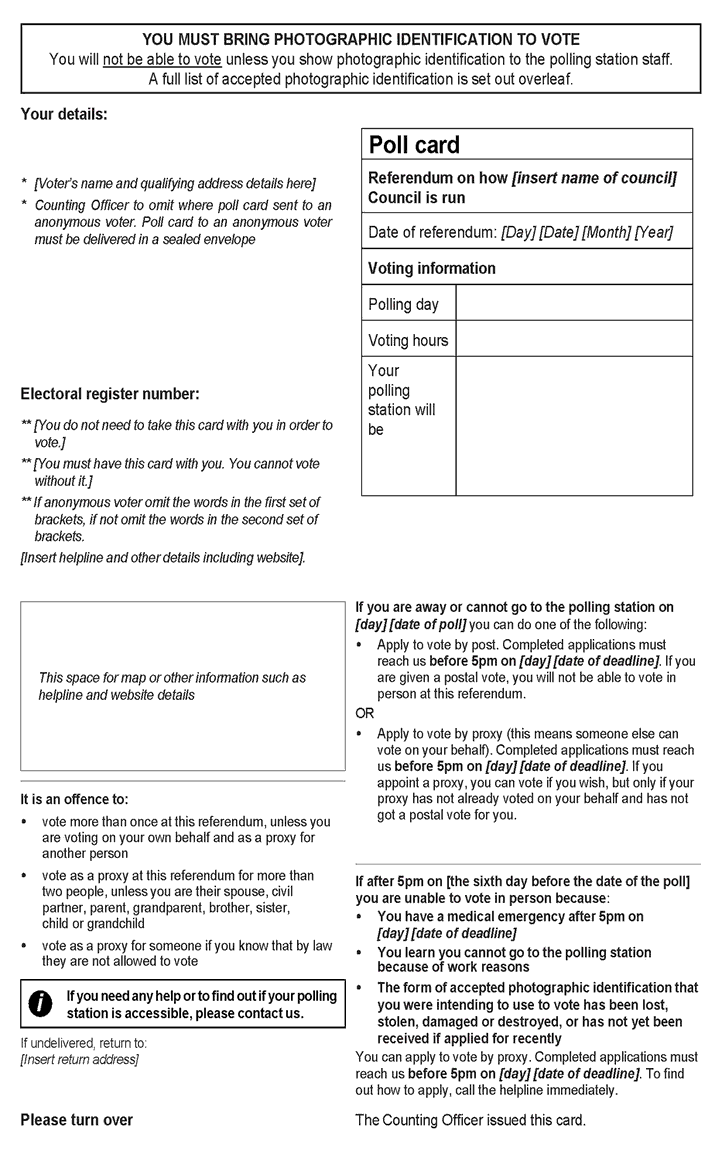
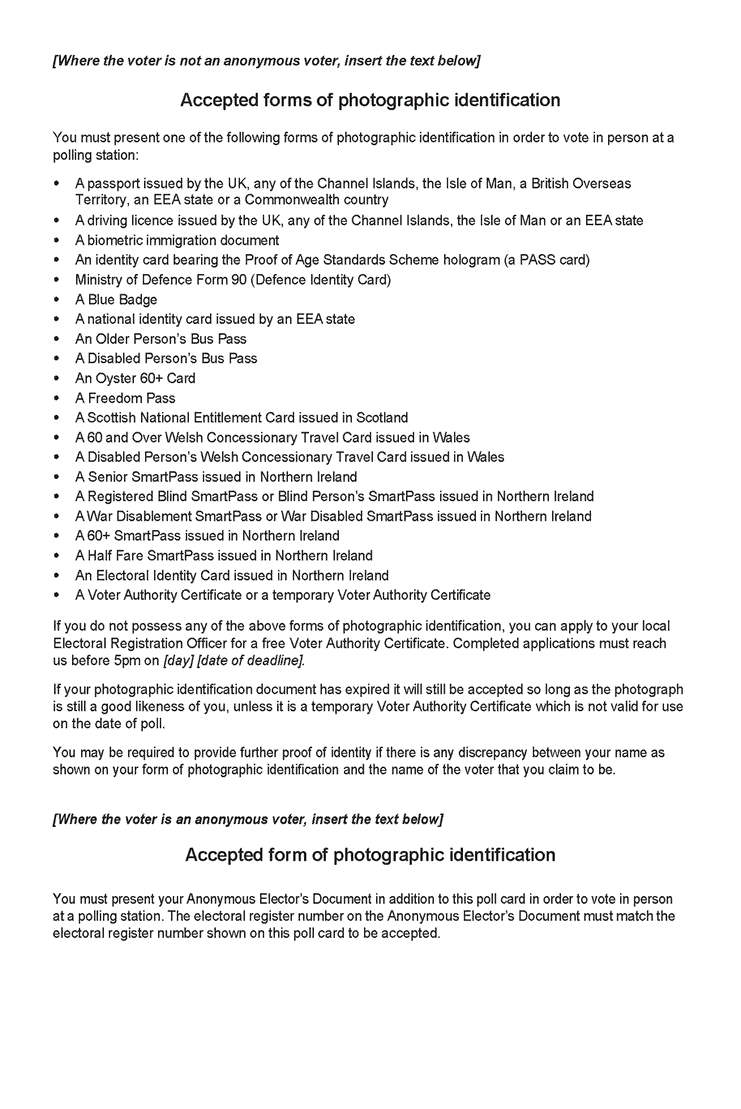
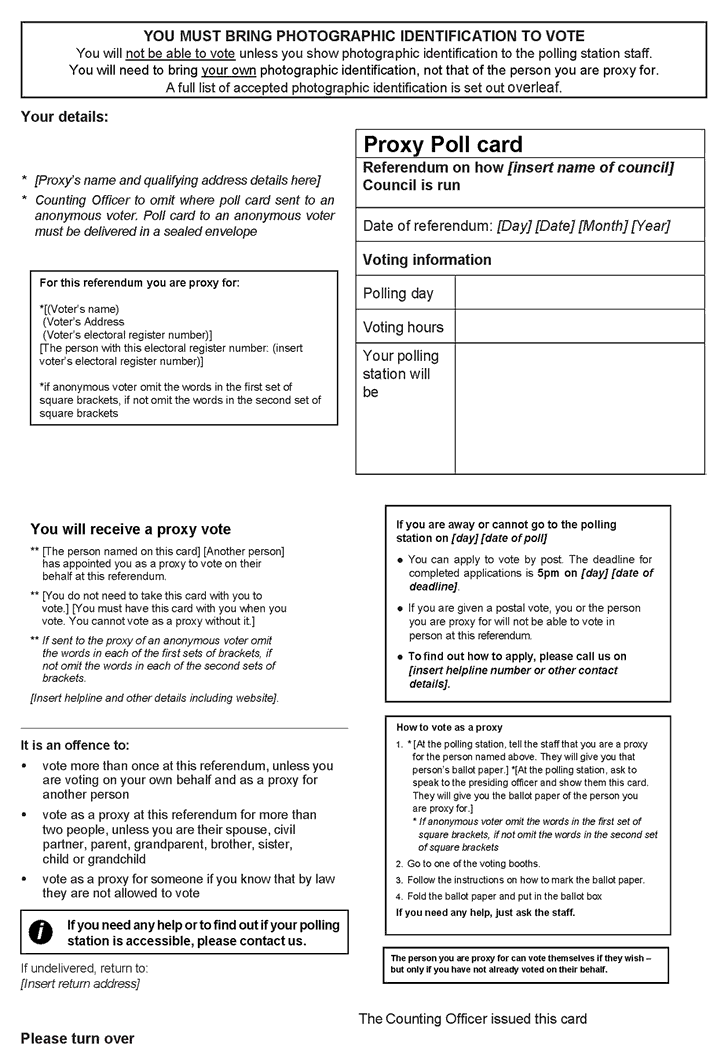
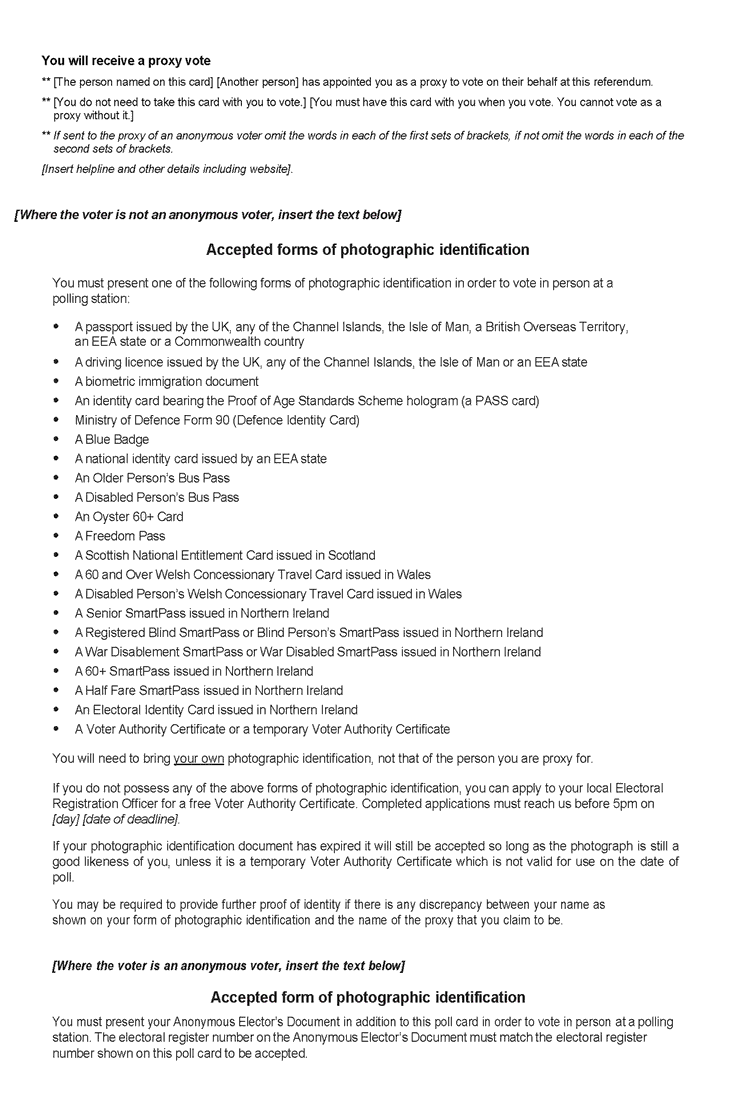
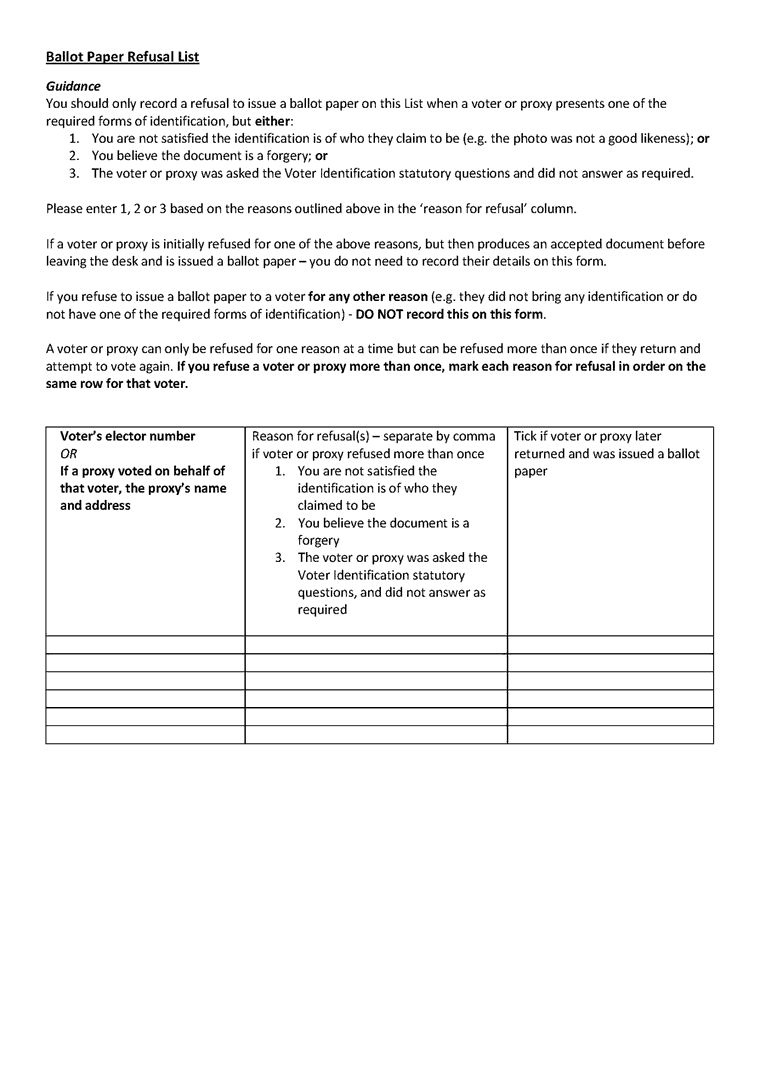
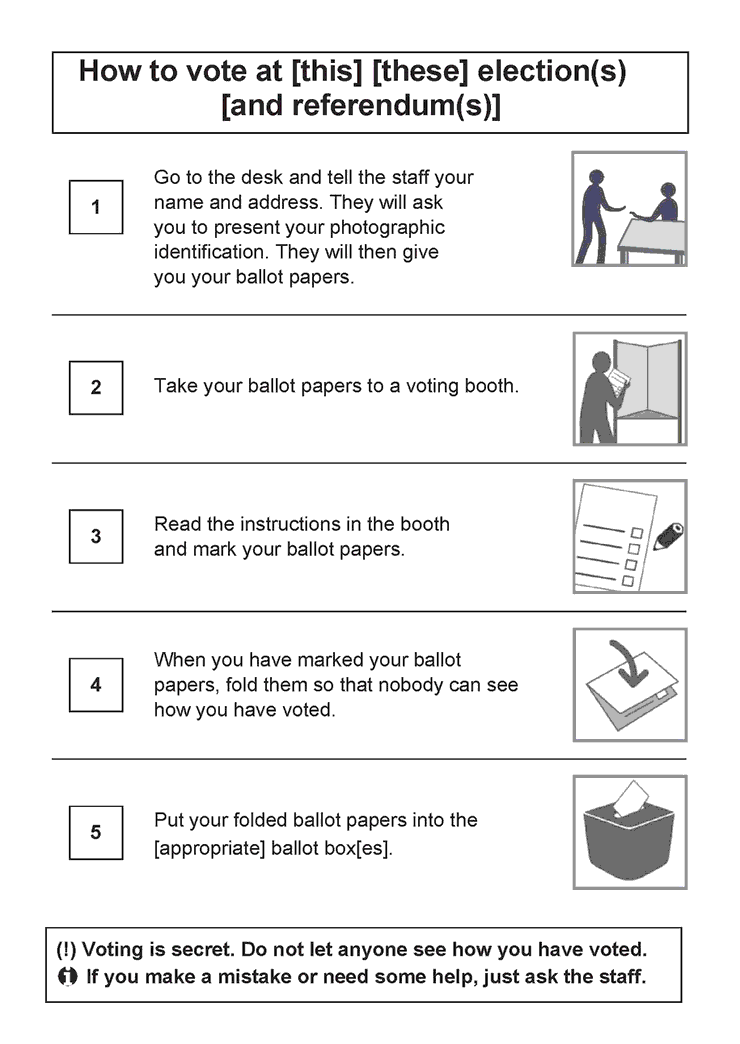
F195Declaration to be made by the companion of a voter or proxy with disabilities
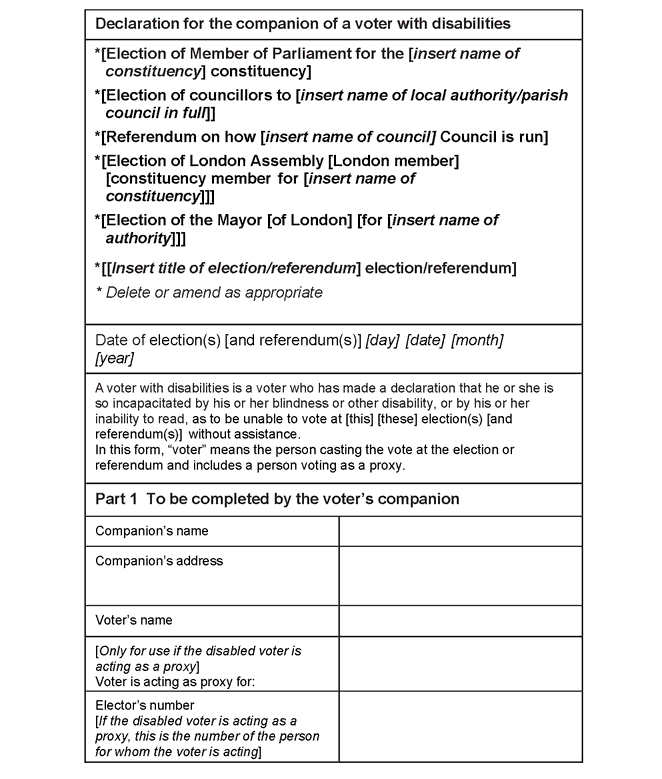
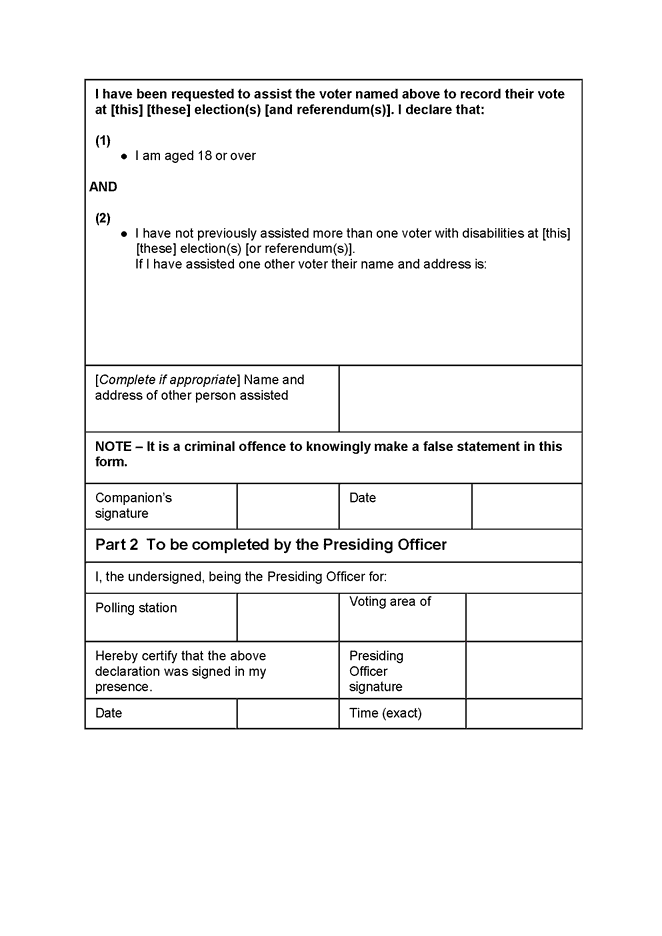
SCHEDULE 6Application, with further modifications, of the Representation of the People Act 1983 in relation to referendum petitions
1983 (c.2); section 128 was amended by paragraph 12 of Schedule 1 to the Electoral Administration Act 2006 (c.22).
Section 130 was amended by paragraph 50 of Schedule 10 to the Courts and Legal Services Act 1990 (c. 41), paragraph 2 of Schedule 17 to the Political Parties, Elections and Referendums Act 2000 (c.41) and paragraph 14 of Schedule 10 to the Tribunals, Courts and Enforcement Act 2007 (c.7).
Section 136 was amended by paragraph 48 of Schedule 4 to the Representation of the People Act 1985 (c.50) and paragraph 19 of Schedule 18 to the Political Parties, Elections and Referendums Act 2000 (c.41).
The existing section 137 was substituted for section 137 as originally enacted by paragraph 3 of Schedule 17 to the Political Parties, Elections and Referendums Act 2000 (c.41).
Section 138 was amended by paragraph 4 of Schedule 17 to the Political Parties, Elections and Referendums Act 2000 (c.41).
Section 140 was amended by paragraph 49 of Schedule 4 to the Representation of the People Act 1985 (c.50).
Section 141 was amended by paragraph 50 of Schedule 4 to the Representation of the People Act 1985 (c.50) and paragraph 84 of Schedule 27 to the Civil Partnership Act 2004 (c.33).
Section 145 was amended by paragraph 33 of Schedule 3 to the Greater London Authority Act 1999 (c.29)
Section 156 was amended by paragraph 51 of Schedule 4 to the Representation of the People Act 1985 (c.50) and paragraphs 48 and 50 of the Legal Services Act 2007 (c.29)
Section 157 was amended by paragraph 6 of Schedule 17 to the Political Parties, Elections and Referendums Act 2000 (c. 41) and paragraph 28 of Schedule 11 to the Constitutional Reform Act 2005 (c.5).
Subsection (1) was amended by paragraph 52 of Schedule 4 to the Representation of the People Act 1985 (c.50), and the present subsection (3) was substituted for subsection (3) as originally enacted by that paragraph.
Section 161 was amended by paragraph 53 of Schedule 4 and Schedule 5 to the Representation of the People Act 1985 (c.50) and paragraph 149 of Schedule 4 to the Constitutional Reform Act 2005 (c.5).
Section 163 was amended by paragraph 55 of Schedule 4 to the Representation of the People Act 1985 (c.50).
Section 167 was amended by paragraph 56 of Schedule 4 to the Representation of the People Act 1985 (c.50) and paragraph 18 of Schedule 18 to the Political Parties, Elections and Referendums Acts 2000 (c.41).
Section 183 was amended by paragraph 28 of Schedule 11 to the Constitutional Reform Act 2005 (c.5).
Section 184 was amended by paragraph 19 of Schedule 18 to the Political Parties, Elections and Referendums Act 2000 (c. 41), SI 2001/1149 and paragraphs 116 and 118 of Schedule 12 to the Postal Services Act 2011 (c.5).
Section 185 was amended by paragraph 10 of Schedule 17 to the Political Parties, Elections and Referendums Act 2000 (c. 41) and paragraphs 86 and 87 of Schedule 6 to the Licensing Act 2003 (c.17).
(1) Provision | (2) Further modifications |
|---|---|
Section 128 (presentation of petition questioning local election) F116 | In subsection (1)— |
(a) for “under the local government Act” substitute | |
(b) omit “either” and the words from “, or by a person” to the end. | |
In subsection (2), for the words from the beginning to “any” substitute | |
Section 129 (time for presentation or amendment of petition questioning local election) | In subsection (1) for “under the local government Act” substitute |
In subsection (2)(b) for “a candidate elected at the election” substitute | |
In subsection (3)(b) for “the candidate elected at the election, or by an agent of the candidate or with the privity of the candidate or his election agent” substitute | |
Omit subsections (4) and (5). | |
For subsection (7) substitute— | |
“(7) Subsections (3) and (6) apply notwithstanding that the act constituting the alleged illegal practice amounted to a corrupt practice.” | |
Omit subsection (9). | |
Section 130 (election court for local election in England and Wales, and place of trial) F117 | In subsection (1) for “and Wales under the local government Act” substitute |
In subsection (3)(a) for “and Wales under the local government Act” substitute | |
Section 131 (accommodation of and attendance on court) | |
Section 132 (remuneration and allowances) | |
Section 133 (repayments under section 131 and 132) | |
Section 136 (security for costs) F118 | In subsection (2)(b) for “petition questioning an election under the local government Act” substitute |
Section 137 (petition at issue) F119 | |
Section 138 (list of petitions) F120 | In subsection (1)(a) for “all election petitions” substitute |
In subsection (3) for the words from the beginning to “candidates” substitute | |
In subsection (4)— | |
(a) for “the same election or to elections under the local government Act” substitute | |
(b) for “the election list”, in both places, substitute | |
Section 139 (trial of petition) | In subsection (1) omit “, in the case of a parliamentary election petition, 14 days and in any other case,”. |
Omit subsection (3). | |
For subsection (5) substitute— | |
“(5) On the trial of a petition, the respondent may give evidence in the same manner as if he or she had presented a petition against the referendum.” | |
For subsection (6) substitute— | |
“(6) Where the petition relates to a referendum as regards which, by reason of an equality of votes found at the count, the result was determined by lot, that determination is to be effective also for the purposes of the petition unless subsection (6A) applies. | |
(6A) This subsection applies where the court disallows any vote cast in the referendum; and in any such case— | |
(a) the determination referred to in subsection (6) is to have no effect, and | |
(b) the court is to declare the result of the referendum. | |
(6B) Where— | |
(a) the petition relates to a referendum at which no equality of votes was found at the count, and | |
(b) the court— | |
(i) disallows any vote cast in the referendum, and | |
(ii) determines that an equality of votes was cast in the referendum, | |
the result of the referendum is to be determined by the court by lot.” | |
Section 140 (witnesses) F121 | |
Section 141 (duty to answer relevant questions) F122 | |
Section 143 (expenses of witnesses) | |
Section 145 (conclusion of trial of local election petition) F123 | For subsection (1) substitute— |
“(1) At the conclusion of the trial of a petition questioning a referendum under the Local Authorities (Conduct of Referendums) (England) Regulations 2012 the election court is to determine— | |
(a) in the case of a petition presented on the ground mentioned in regulation 15(1)(a) of those Regulations, whether the result of the referendum was or was not in accordance with the votes cast in the referendum, | |
(b) in the case of a petition presented on the ground mentioned in regulation 15(1)(b) or (c) of those Regulations, whether the referendum was void. | |
For subsection (1A) substitute— “(1A) Following a determination under subsection (1)(a), the election court must, as the circumstances require, confirm or reverse the result of the referendum.” | |
In subsection (3)— | |
(a) for “sections 158 and” substitute | |
(b) for the words from “for which” to the end substitute | |
In subsection (6) for “for which the election was held” substitute | |
Section 146 (special case for determination of High Court) | Omit subsection (2). |
In subsection (3) for the words from the beginning to “local government Act” substitute— | |
“(3) In the case of a referendum petition under the Local Authorities (Conduct of Referendums) (England) Regulations 2012,”. | |
Section 147 (withdrawal of petition) | |
Section 154 (costs of petition) | |
Section 155 (neglect or refusal to pay costs) | |
Section 156 (further provision as to costs) F124 | |
Section 157 (appeals and jurisdiction) F125 | Omit subsection (4). |
Section 160(1) and (3) (persons reported personally guilty of corrupt practices) F126 | Omit subsection (1)(b). |
Section 161 (Justices of the Peace) F127 | |
Section 162 (member of legal and certain other professions) | |
Section 163 (holder of licence or certificate under Licensing Acts) F128 | |
Section 164(1) and (2) (avoidance of election for general corruption etc) | In subsection (1)— |
(a) for “election”, in the first two places where that words appears, substitute | |
(b) for “the election of any person at that election” substitute | |
(c) for paragraphs (a) and (b) substitute | |
In subsection (2) for “An election” substitute | |
Section 167 (application for relief) F129 | |
Section 180 (evidence by certificate of holding of election) | Omit sub-paragraph (ii) and the word immediately preceding it. |
Section 183 (costs) F130 | |
Section 184 (service of notices) F131 | |
Section 185 (interpretation of Part 3) F132 |
SCHEDULE 7Modifications of the Election Petition Rules 1960
Amended by S.I. 1985/1278.
Amended by S.I. 1985/1278.
Amended by S.I. 1985/1248.
Amended by S.I. 1985/1278.
Amended by S.I. 1999/1352.
Amended by S.I. 1999/1352.
Amended by S.I. 1999/1352.
Amended by S.I. 1985/1278.
Amended by S.I. 1985/1352.
(1) Provision modified | (2) Modification |
|---|---|
Rule 2(2) F133 | After the definition of “the Act” insert— |
“ “the 2012 Regulations” means the Local Authorities (Conduct of Referendums) (England) Regulations 2012;”. | |
After the definition of “local election petition” insert— | |
“ “referendum petition” means a petition under the 2012 Regulations;”. | |
In the definition of “petition” insert at the end | |
For the definition of “constituency” substitute— | |
“ “constituency” in relation to— | |
(a) a local election petition, means the local government area to which the petition relates; | |
(b) a referendum petition, means the local government area in which the referendum is held;”. | |
After the definition of “returning officer” insert | |
Rule 2(3) F134 | After “local government Act” insert |
Rule 4(1) F135 | Omit sub-paragraph (a). |
For sub-paragraph (b) substitute— | |
“(b) the date and result of the referendum to which the petition relates;”. | |
In sub-paragraph (c) for the words from “petition” to “the Act” substitute | |
Rule 10 F136 | Omit. |
Rule 12(3) F137 | For “the election” substitute |
Rule 14(2) F138 | For “the election may” substitute |
Rule 16(3) F139 | For “the election may” substitute |
Rule 18 F140 | After “local election petition” insert |
The Schedule F141 | For “a Parliamentary (or Local Government) Election for (state place) ........” substitute |
In paragraph 1— | |
(a) for “election”, in the first place where that word occurs, substitute | |
(b) omit “(or was a candidate at the above election) (or in the case of a parliamentary election claims to have had a right to be elected or returned at the above election)”. | |
For paragraph 2 substitute— | |
“(2) That referendum was held on the [insert day] day of [insert month] [insert year]”. | |
In paragraph 4 omit “in the case of a petition mentioned in section 122(2) or (3) or”. | |
For paragraph (1) of the Prayer substitute— | |
“(1) That it may be determined [that the result of the referendum was not in accordance with the votes cast]* [that the referendum is avoided]* [that the referendum is tainted as mentioned in regulation 17(5) of the 2012 Regulations]*. * Include or omit as the circumstances require.” |
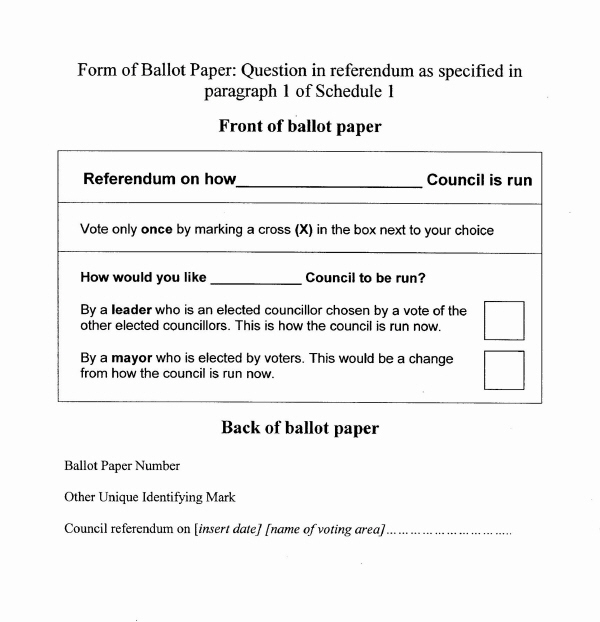
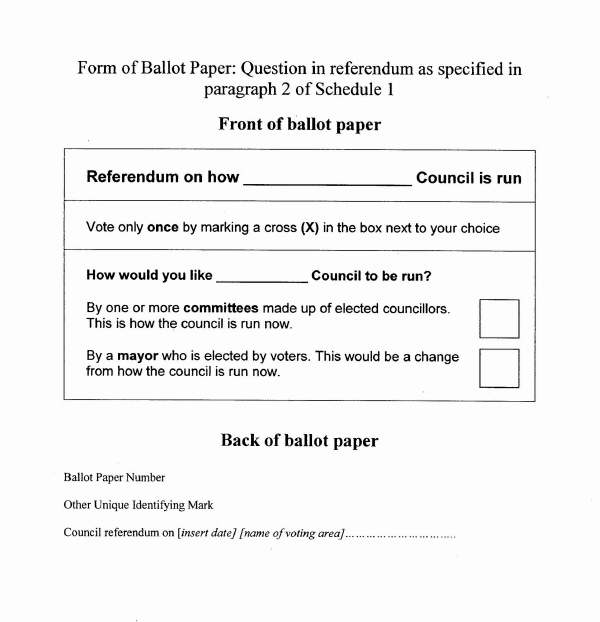
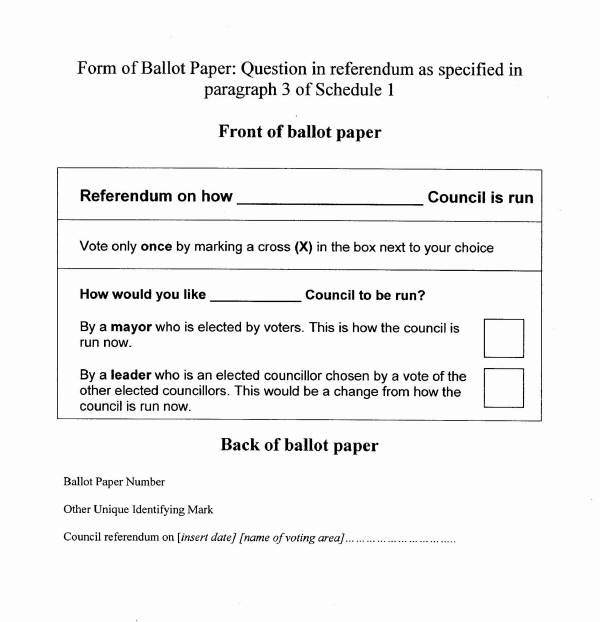
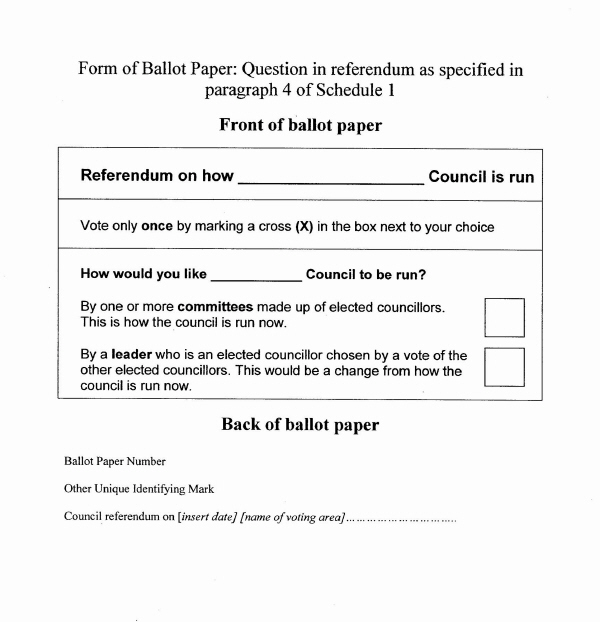
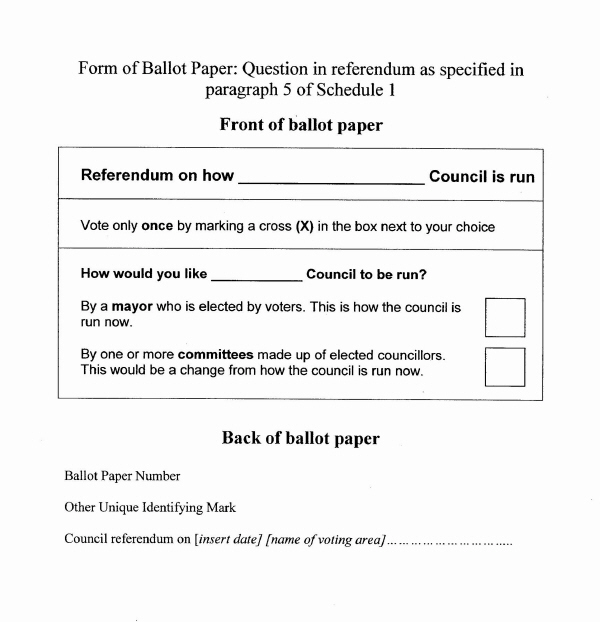
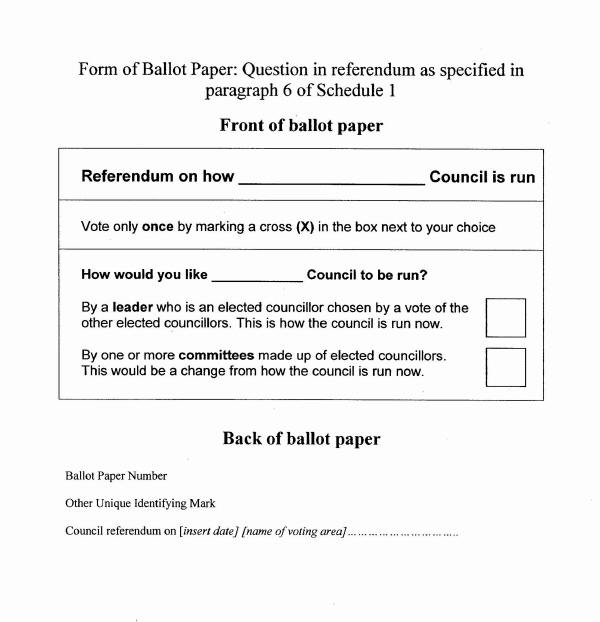
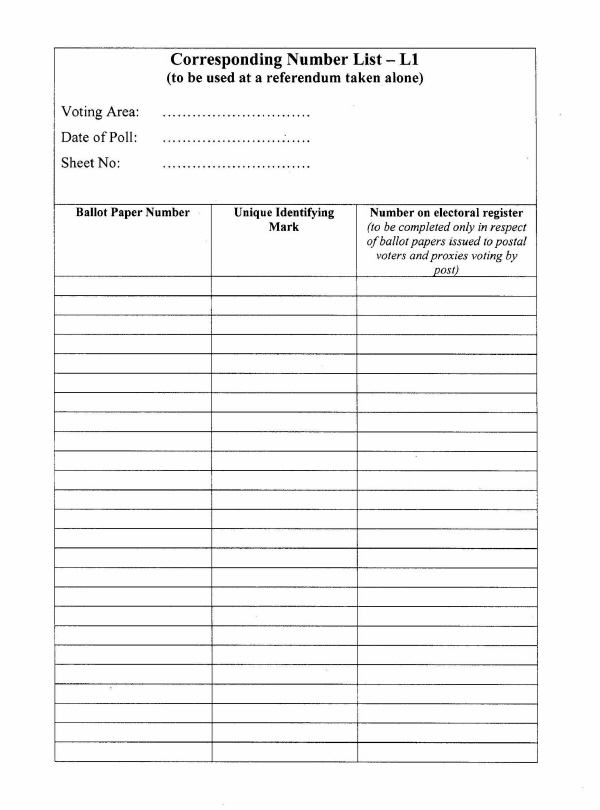
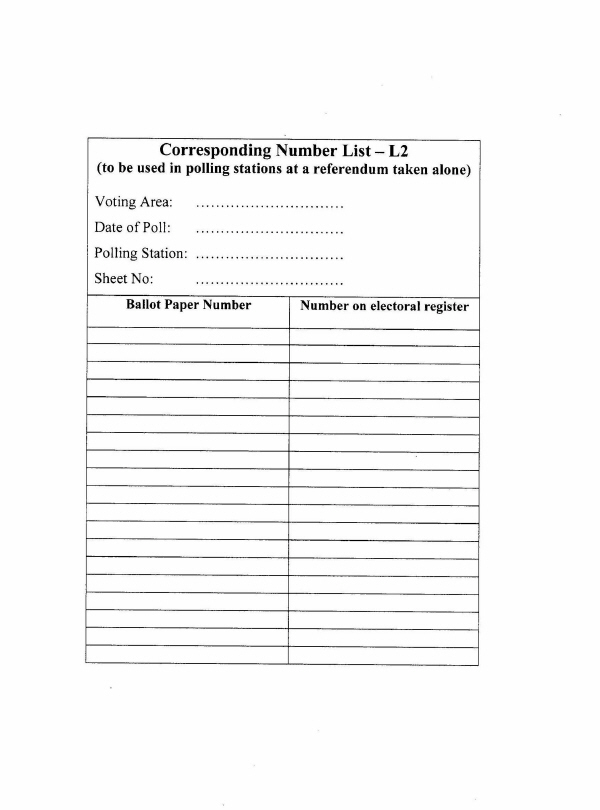
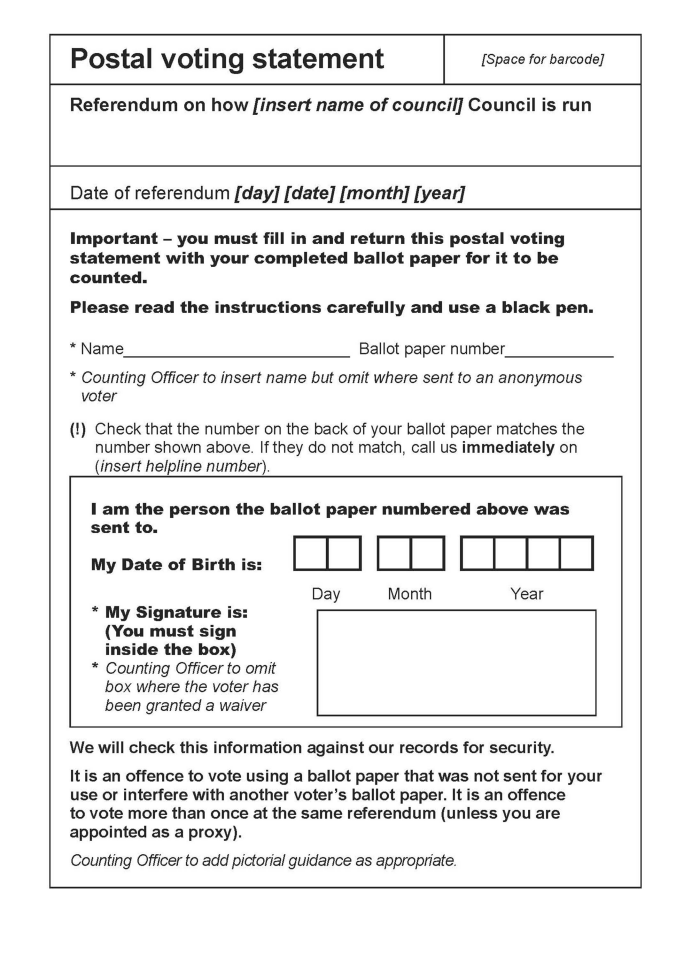
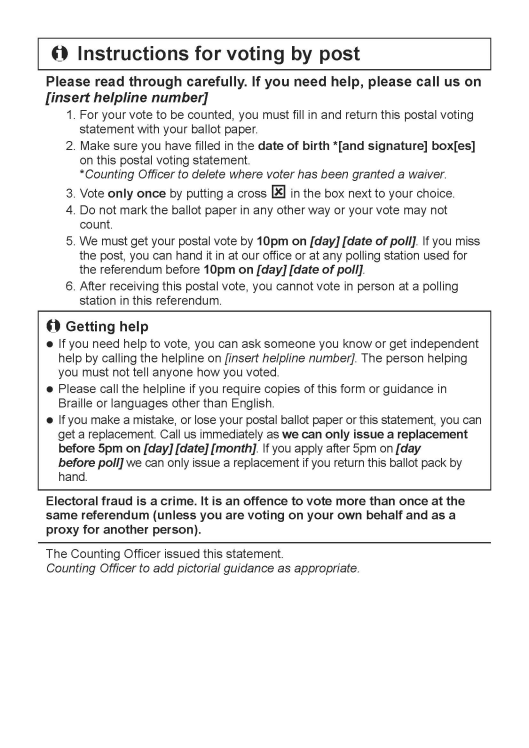
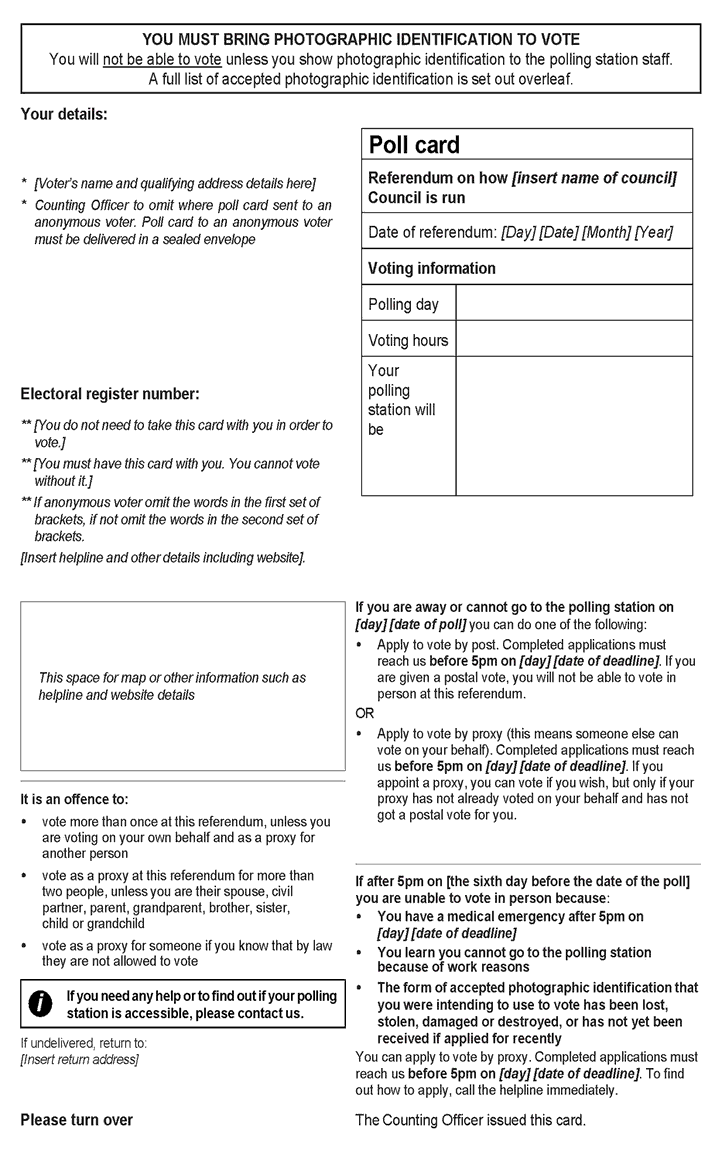
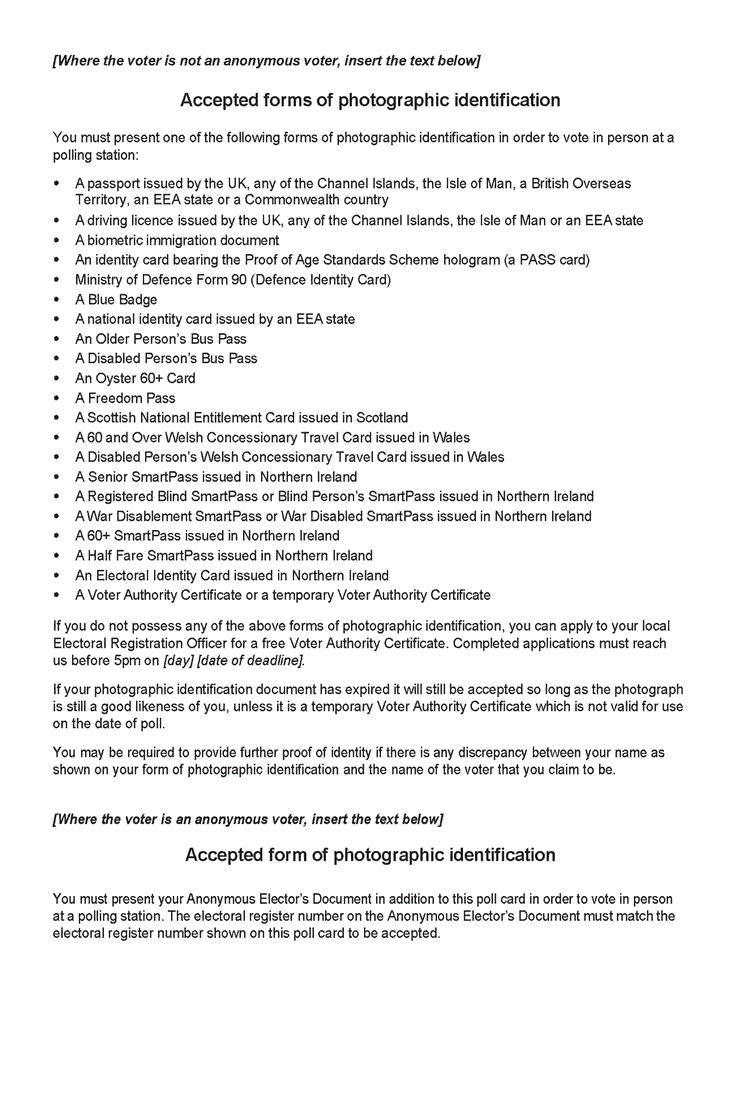
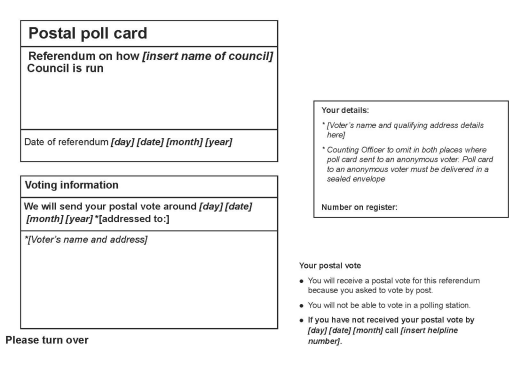
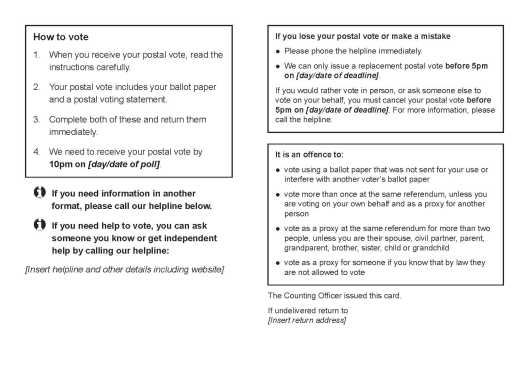
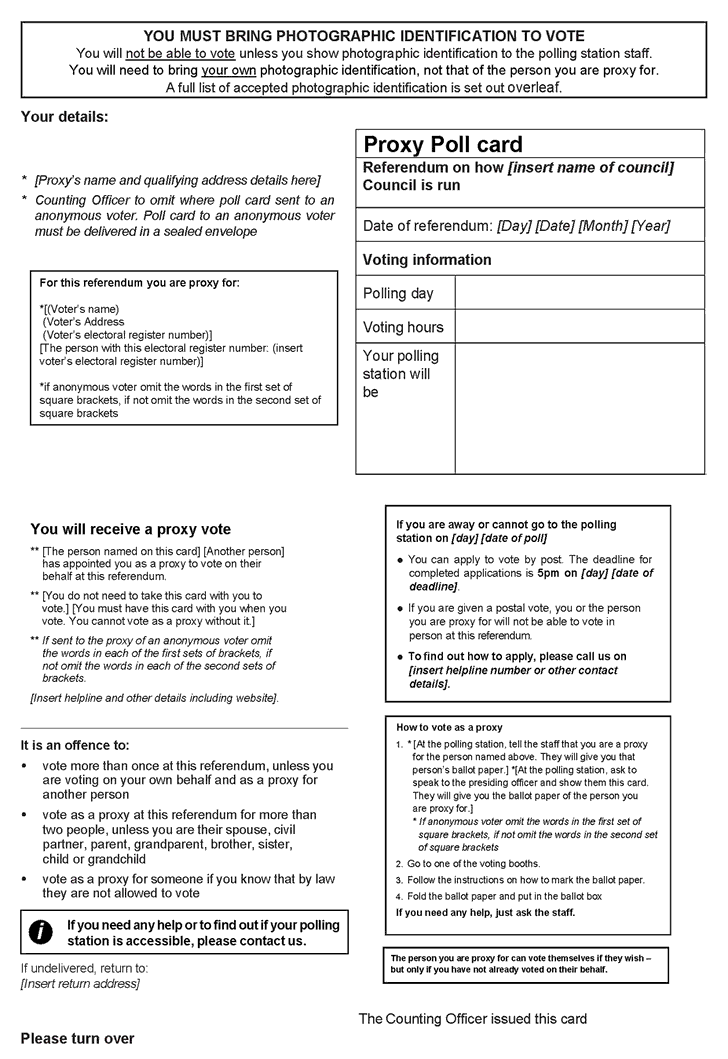
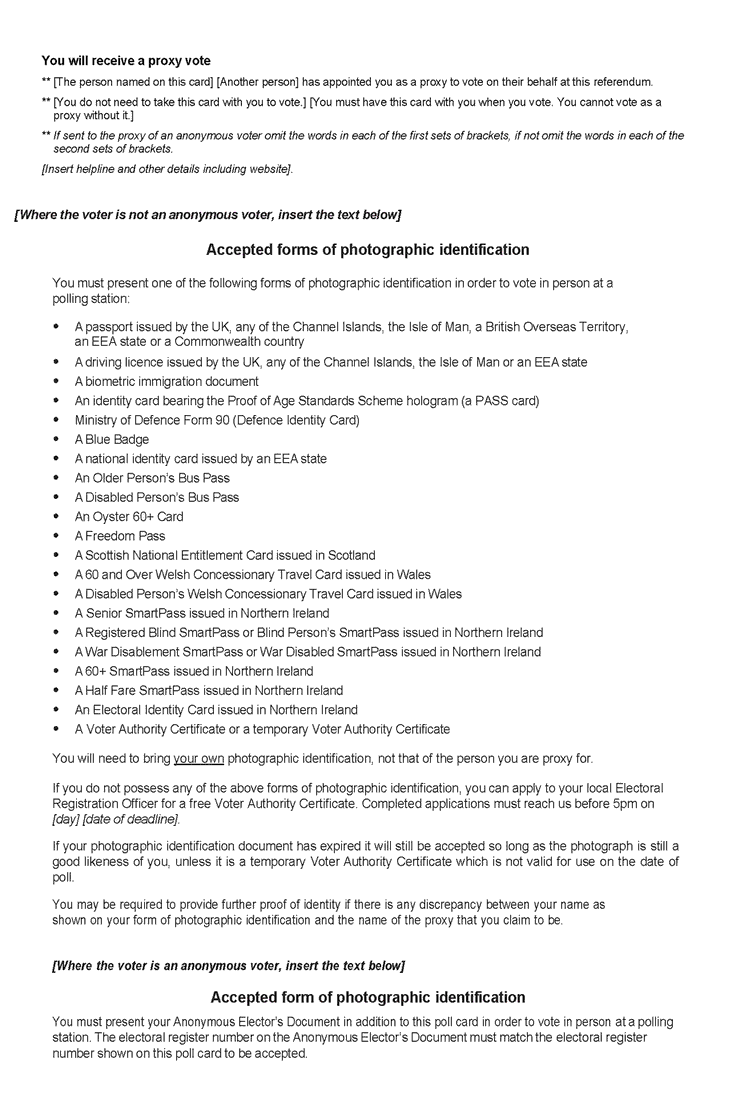
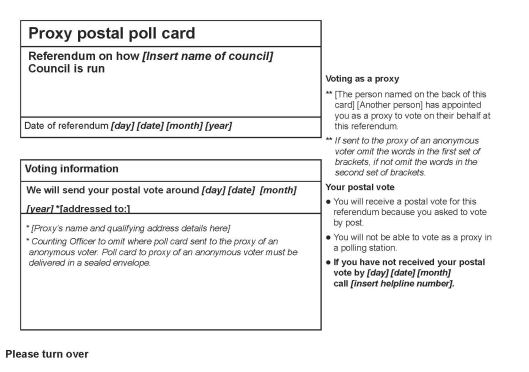
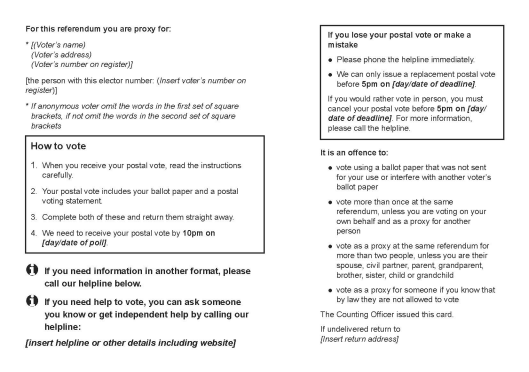
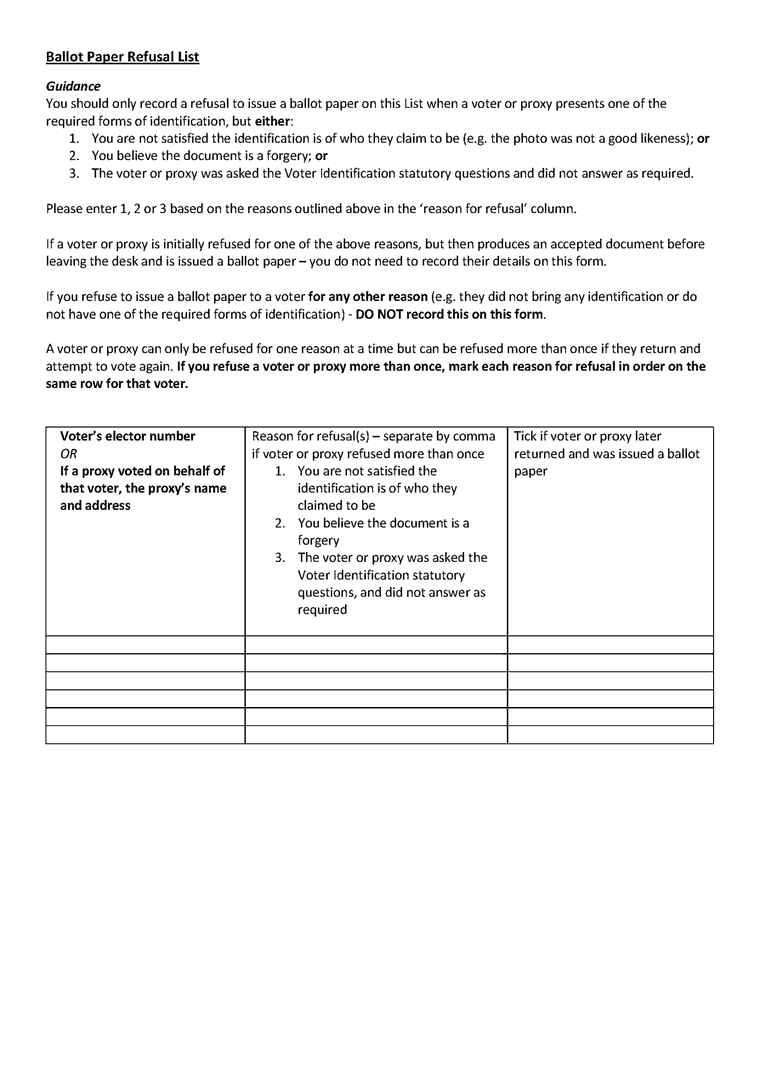
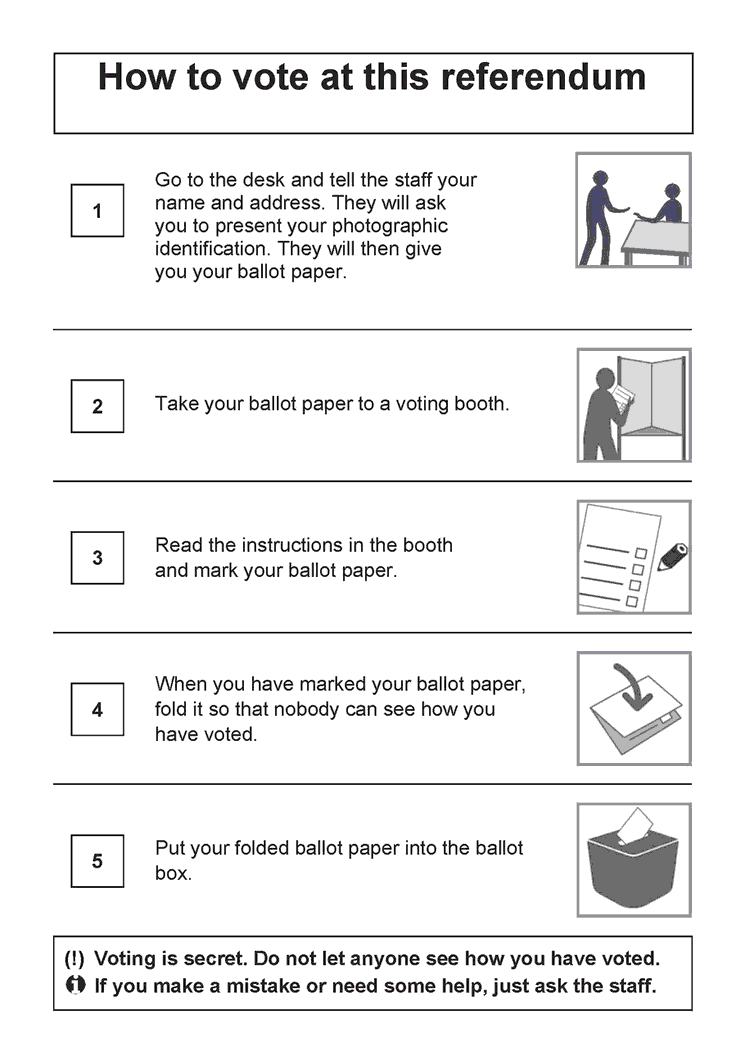
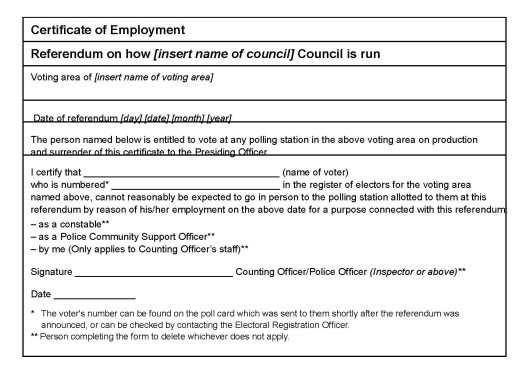
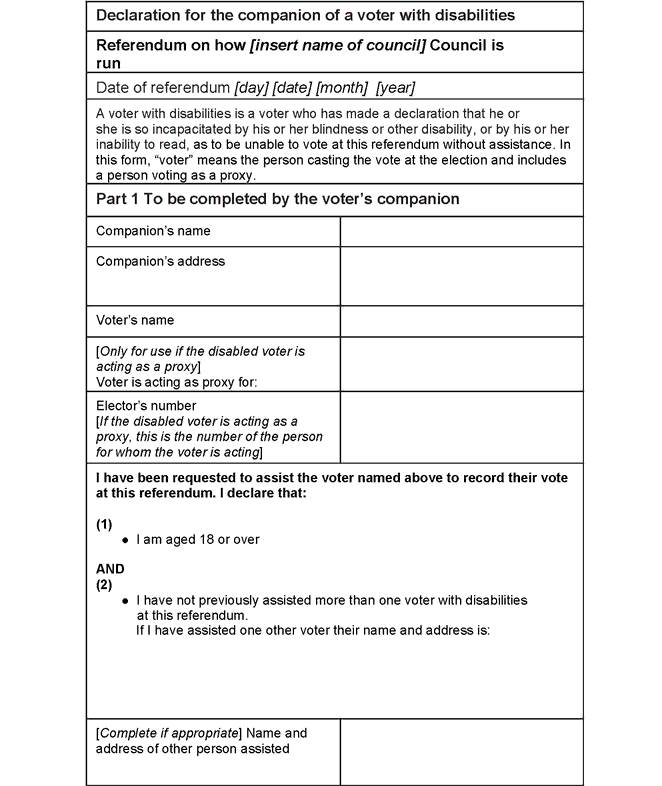
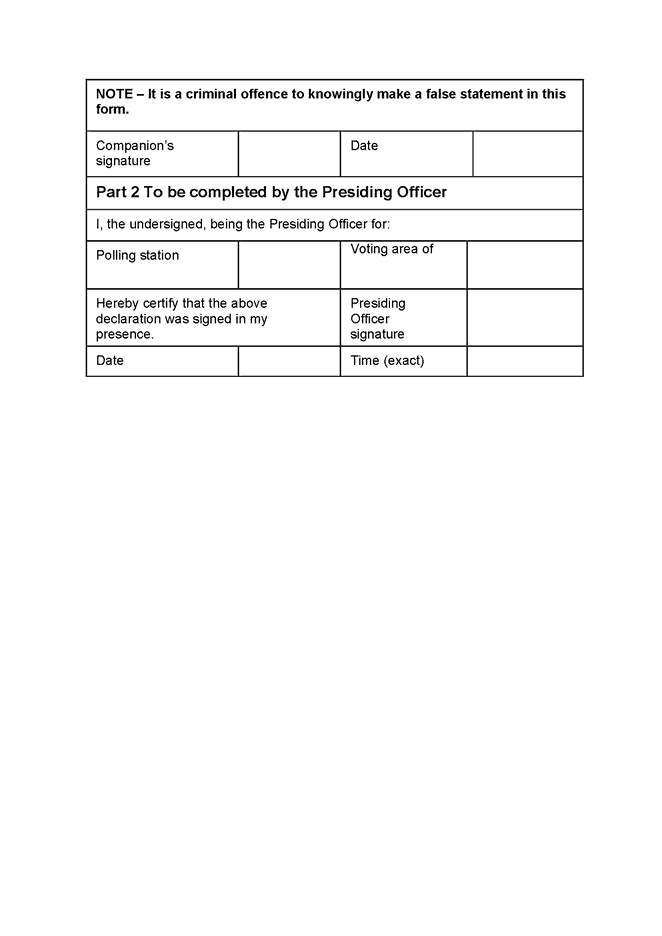
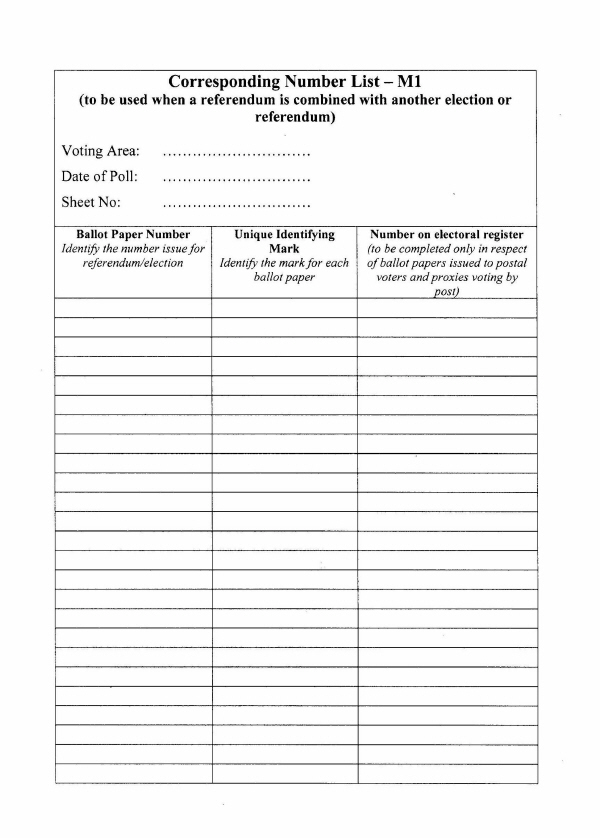
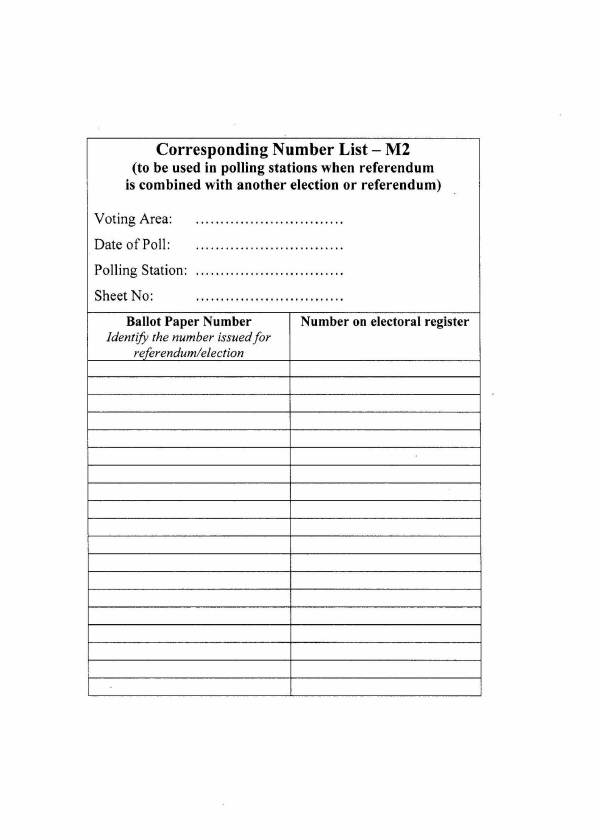
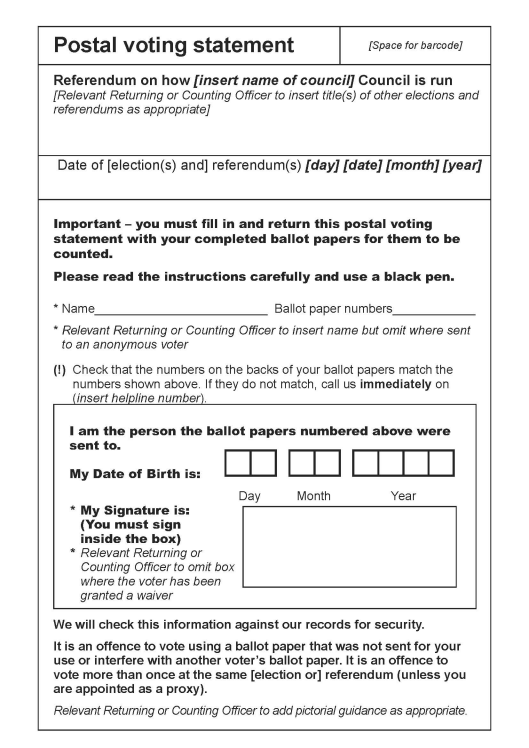
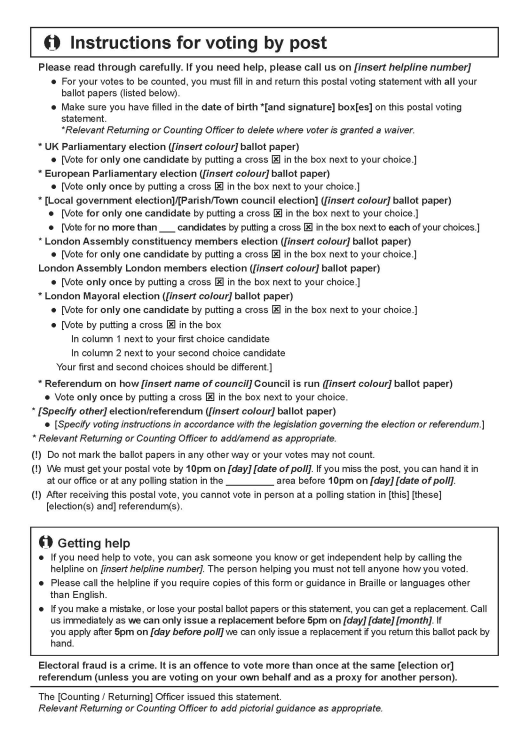
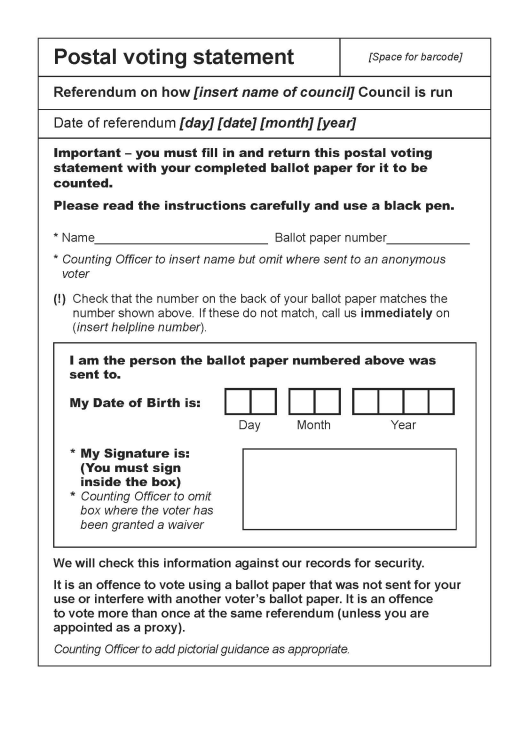
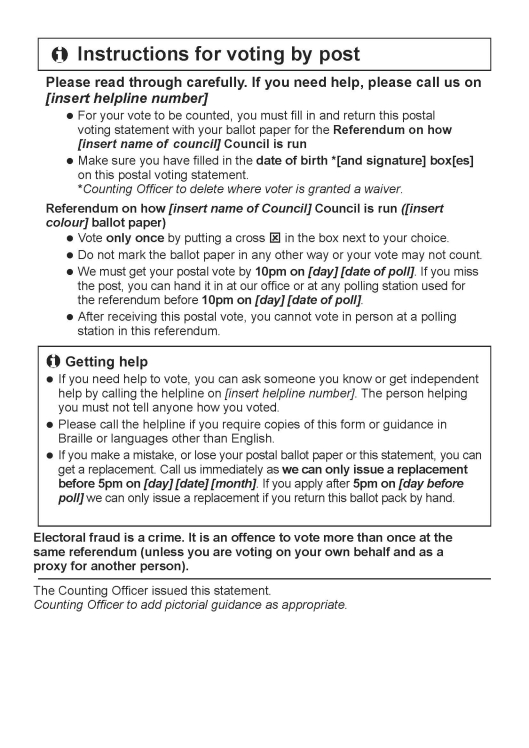
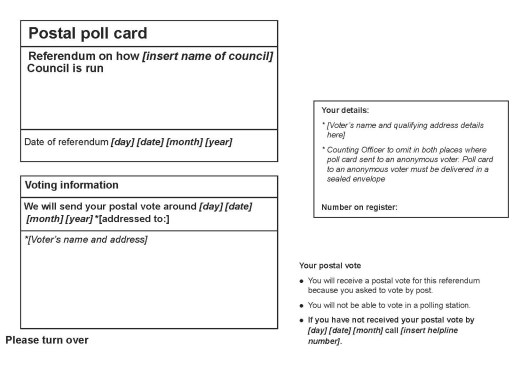
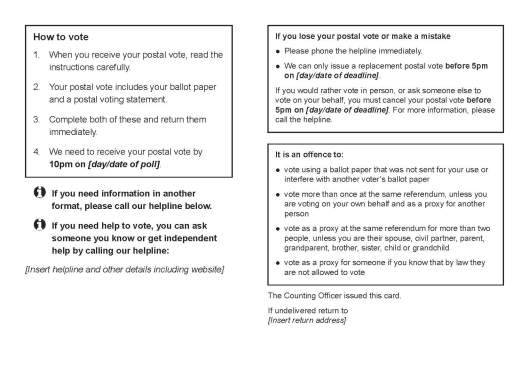
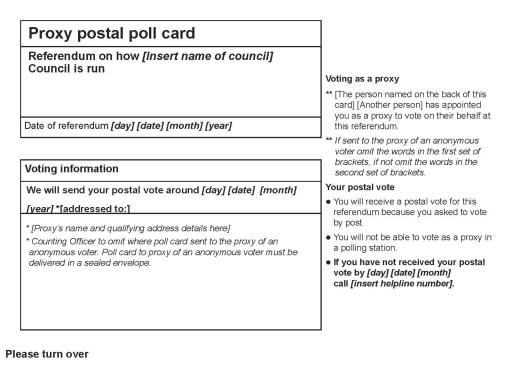
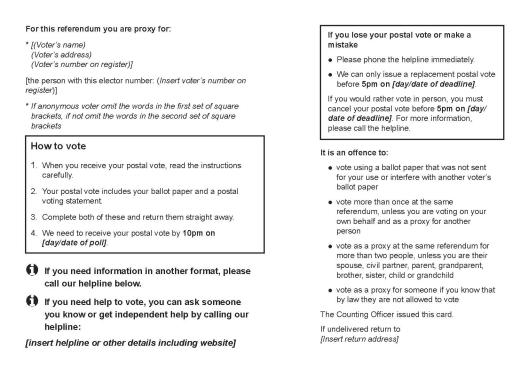
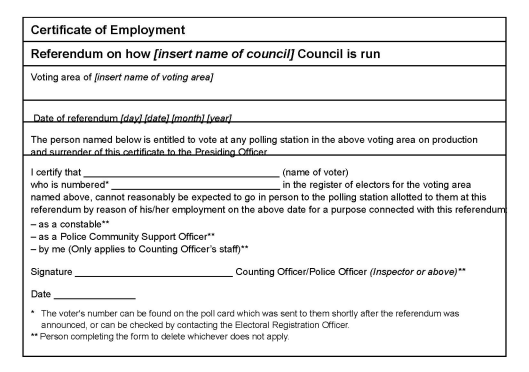
2000 c.22. Part 1A was inserted into the Local Government Act 2000 by Schedule 2 to the Localism Act 2011 (c.20). Section 105 was amended by paragraph 70 of Schedule 3 to the Localism Act 2011.